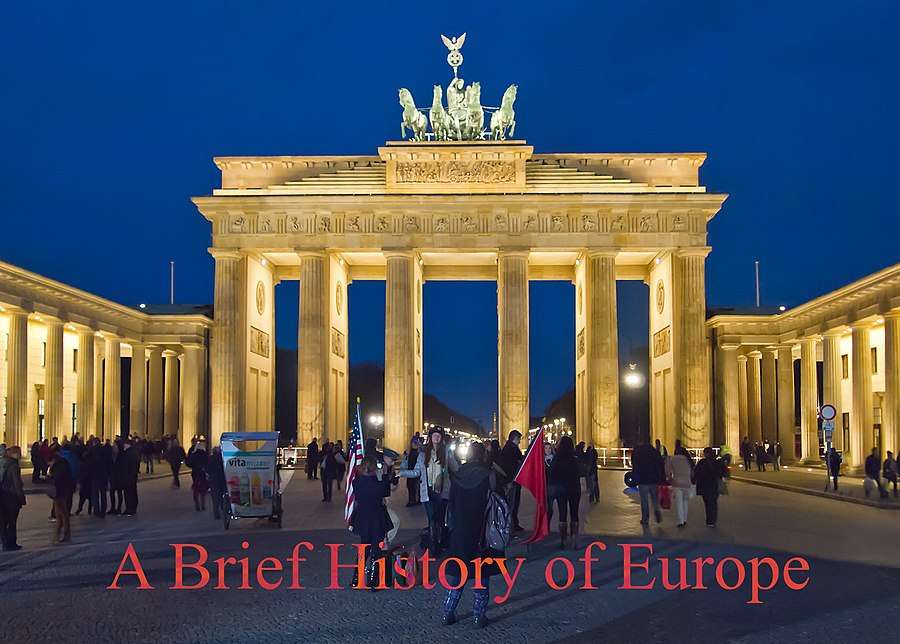
A Brief History of Europe is a free content online book published on English Wikibooks.
Preface
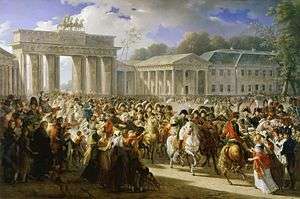
A Brief History of Europe covers European history from the fall of Rome to the present day.
This period can roughly be divided into the Middle Ages, and the modern period. The modern period includes the contemporary period.
Author(s)
Jules (Mrjulesd)
Sources
Primarily articles on the English Wikipedia.
For this reason it should not be directly cited. It is recommended instead to search for the italicized term on Wikipedia, and refer to the citations on the relevant article.
Notes
c. = circa or century.
Comments
Any comments? Please comment here.
See also
Part 1 Middle Ages
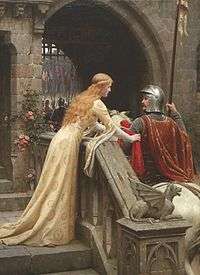
The Middle Ages (or medieval period) lasted roughly from the 5th to the 15th century. It can be considered as from the period from the end of classical antiquity with the fall of Rome in 476, to the fall of Constantinople in 1453. It followed Classical antiquity, which was circa 8th –7th century BC to the fall of Rome. Medium aevum (Latin for middle age) gave rise to the term “medieval”.
It can be divided into:
- Early Middle Ages, which was circa AD 500–1000, and sometimes referred to as the Dark Ages, although this is controversial. It was a time of new empire building, most importantly Francia (the Frankish empire). The rise of Islam created a rivalry with the Byzantine Empire, and Iberia would soon be conquered by them.
- High Middle Ages, which was circa AD 1000–1300, or 1000–1250. After the Norman conquest of England, the English Plantagenet dynasty would rival the French kings for France. The Holy Roman Empire would get established as a powerful Germanic empire. There was religious turmoil with the crusades, and with the Great Schism the Catholic and Orthodox churches would separate.
- Late Middle Ages was circa AD 1300–1500 or 1250–1500. The Crisis of the Late Middle Ages was a series of famines, plagues, peasant revolts, and wars, that devastated European populations. It was also the period of the rise of the Ottoman Empire, who would overthrow the Byzantine Empire and come to dominate the Balkans.
See also Wikipedia:Middle Ages.
Chapter 1 Early Middle Ages
The Early Middle Ages was Circa AD 500–1000; it is sometimes referred to as the Dark Ages, as there was a relative scarcity of literary and cultural output in Western Europe.
See also Wikipedia:Early Middle Ages
Peoples of the Early Middle Ages

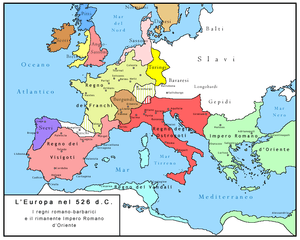
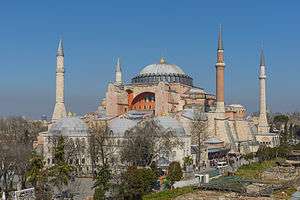

Germanic peoples
Germanic peoples can be divided into West, East and North:
West Germanic peoples included:
- Anglo-Saxons, the Angles, Saxons, and Jutes; they inhabited Jutland and northern Europe, and founded Anglo-Saxon England (c. 500–1066).
- Franks, that spread across Europe from the north, to form Francia/Carolingian Empire (from 481, divided in 843).
- Lombards, who inhabited the Kingdom of the Lombards (568–774), which covered much of the Italian Peninsula.
- Suebi, who inhabited the Iberian Kingdom of the Suebi (409–585).
- Frisii, who inhabited the Frisian Kingdom (c. 600–734) near the North Sea.
Other West Germanic peoples included: Chatti/Hessians (who inhabited Hesse in Roman times); Alemanni (who inhabited Alamannia/Swabia); Bavarii (who inhabited Bavaria); and Thuringii (who inhabited Thuringia).
East Germanic peoples included, most importantly, Vandals, Goths, and Burgundians:
- Vandals (an East Germanic people) spread across Western Europe, Iberia, Carthage, and across the Mediterranean Sea to Rome; the Vandal Kingdom (435–534) included North Africa and Carthage; Corsica; Sardinia; Sicily. Eventually fell to the Byzantines.
- Goths (an East Germanic people) included Visigoths and Ostrogoths. Visigoths spread across the Balkan Peninsula, Italy, Rome, southern France; the Visigothic Kingdom (418–c. 720) included much of Iberia and southern France. Eventually fell to Islam, Asturias and Francia. Ostrogoths spread across Europe to Rome to form the Ostrogothic Kingdom (493–553), of Italy and the west Balkans, after the murder of Odoacer. Eventually fell to the Byzantines and the Avar Khaganate.
- Burgundians (an East Germanic people) formed the Kingdom of the Burgundians/Burgundy (411–534), before falling to the Franks.
Other East Germanic peoples and territories included: Gepids (and the Kingdom of the Gepids); and Rugii (and Rugiland).
North Germanic peoples included: Danes, Swedes, Geats, Gutes and Norsemen.
- Danes: inhabited the province of Scania, now in southern Sweden.
- Geats (Götar) and Swedes (Svear) were north of the Danes; Gutes (Gutar) inhabited the island of Gotland. They would gave rise to modern Swedes. The Geats may have given rise to the Goths.
- Norsemen (also called Norwegians) inhabited the petty kingdoms of Norway.
Non-Germanic peoples
Indo-European speaking peoples, other than Germanic peoples, included:
- Greco-Romans, who ruled the Byzantine Empire, and who spoke Ancient Greek (a Hellenic language) and Latin (an Italic language).
- Celts: were once widespread across Europe, but by the 5th century CE they had been mostly conquered. Celtic Britons inhabited England and Wales, and also Brittany. Celtic Gaels (also know as Scoti) inhabited Ireland and later Scotland. Picts (who may have been Celtic) inhabited Scotland. Other Celtic peoples included Gauls (of Gaul, present day France); Celtiberians (of Iberia); and Galatians (of ancient Anatolia). Britain was abandoned by its Roman garrison in AD 410, paving the way for Anglo-Saxon invasions from the east.
- Slavs: could be divided into North Slavs (which includes East and West Slavs); and South Slavs. West Slavs would settle in Eastern Europe areas south of the Baltic Sea. East Slavs would settle in areas that correspond to present-day Belarus, central and northern Ukraine, and parts of western Russia. South Slavs would settle in the Balkans. Early Slavic kingdoms included Samo's Empire (631–658) and Carantania (658–828).
- Balts, lived near the Baltic Sea, and are related to Slavs. Peoples included the Lithuanians, Latvians, and Old Prussians.
- Iranians: included the Eastern Iranian Alans and Pashtuns (ethnic Afghans); in the Middle East there were the Western Iranian Persians and Kurds.
Apart from the Indo-European speakers, Europe included:
- Turkic peoples: they may have included Huns; early Turkic peoples included Khazars and Bulgars. Also see the section Turkic migration.
- Uralic peoples: included Magyars (of the Principality of Hungary), Sami (of northern Scandinavia), and Finns (of Finland); related to the Finns were the Livonians (Latgalians) and Estonians.
- Northeast Caucasian people: Pannonian Avars would form the Avar Khaganate in the 6th century, before falling to the Bulgars.
- Afroasiatic peoples: Berbers (of North Africa) and Arabs (of Arabia) would latter press north into Iberia, and would be known as Moors.
Roman Empire and movements of peoples
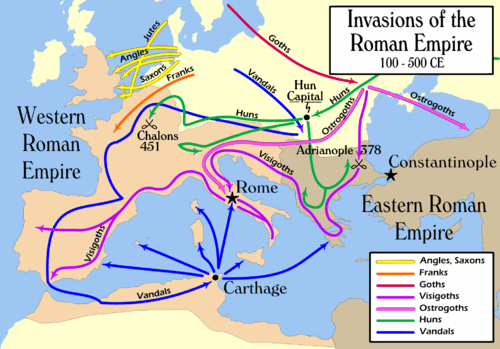
.jpg)
The Fall of the Western Roman Empire, in AD 476, when non-Roman Odoacer deposed Romulus Augustulus and became King of Italy (476–493). Later on it became part of the Ostrogothic Kingdom (493–553), before Italy fell to the Byzantines. The fall of Rome can in part be attributed to the migration of peoples, mainly from the east. The Byzantine Empire, or Eastern Roman Empire, survived the fall of the Western Roman Empire.
Migration Period and other migrations
Migration Period (c. AD 375 to 538): was a period of barbarian invasions of Europe. Invasions by the Huns, and also Avars, Slavs and Bulgars, caused movements in Germanic peoples, particularly Goths (including the Visigoths and the Ostrogoths), Vandals, Anglo-Saxons, and Franks. Other Germanic peoples affected included Lombards, Burgundians, Suebi, Frisii, and Alemanni.
Turkic migration: between the between the 6th and 11th centuries, there was an expansion of Turkic tribes over Asia and Eastern Europe. Early Turkic peoples in Europe were mainly Oghurs, such as Khazars and Bulgars. Later on Turks (from the Oghuz branch) and Tatars (mainly from the Kipchak branch) became prominent. Today Turkic peoples are mainly represented by Turks, Azerbaijanis and Turkmen (from the Oghuz branch); Uzbeks and Uyghurs (from the Karluk branch); and Kazakhs and Tatars (from the Kipchak branch).
Huns may have been Turkic: the Hunnic Empire (370s–469) included much of Eastern Europe and western Asia, and was unified under Attila.
Viking Age (793–1066): began with the raid on Lindisfarne (793). Vikings were North Germanic peoples, which included Danes, Swedes, and Norsemen (Norwegians). In this period they settled in Greenland, Newfoundland, and present-day Faroe Islands, Iceland, Norway, Sweden, Normandy, Scotland, England, Ireland, Isle of Man, the Netherlands, Germany, Ukraine, Russia, and Turkey. The Varangians (also known as Rus') were Viking Swedes that traveled along the Volga and Dnieper rivers, and may have founded Kievan Rus', an early Russian federation.
Vikings would give rise to Normans, descendants of Vikings who settled in Normandy, and would conquer England and south Italy in the High Middle Ages.
Other movement of peoples included Magyars, Moors (Arabs and Berbers), and Mongols (during the 13th century).
Byzantine Empire
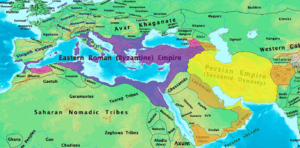
Byzantine Empire, or Eastern Roman Empire (395–1453), continued after the fall of the West. Crises of third century had led to the Roman Empire divisions of east and west. In AD 330, Constantine moved the seat of the Empire from Nicomedia to Constantinople (formerly called Byzantium, later called Istanbul), which was sometimes characterised as the "New Rome". Theodosius I (379–395) was the last Emperor to rule both East and West. The empire was oriented towards Greek rather than Latin culture, and characterised by Orthodox Christianity.
Under the Justinian Dynasty (518–602), the Byzantine Empire reached its greatest extent since the fall of the Western Roman Empire. The expansion resulted largely from the Wars of Justinian the Great (Justinian I), who ruled between 527–565, and expanded it over North Africa, southern Spain, and Italy (including Sicily, Sardinia and Corsica). It also included the Balkan peninsula, Anatolia, and the Holy Land. In this period, the Plague of Justinian (541–542 AD) had a profound effect on the population of the empire, with an estimated 25–50 million deaths.
Many territories were later lost to the Islamic Caliphates during the early Muslim conquests (622–750). The Byzantine Empire had been weakened by the ongoing Byzantine–Sasanian wars (285 to c. 628), against the Persian Sasanian Empire; this included the 626 siege of Constantinople. The Sasanian Empire itself was toppled in 651 by the Rashidun Caliphate. But at the first and second Arab sieges of Constantinople, 674–678 and 717–718, the Umayyad Caliphate was defeated by the Byzantine Empire.
Italian Peninsula in the Early Middle Ages
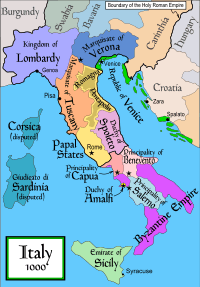
Odoacer's Kingdom Of Italy (476-493), which included some surrounding territory, had been conquered to form the Ostrogothic Kingdom (493–553). Theodoric the Great was the King of the Ostrogoths 475 to 526; would rule the Ostrogoths of Italy, but he would also rule the Visigoths. Corsica, Sardinia, and Sicily became part of the Vandal Kingdom (435–534), along with some of North Africa and Carthage. Both the Ostrogothic and Vandal kingdoms were conquered by the Byzantine Empire under Justinian I (527–565), after the Gothic War (535–554) and the Vandalic War (533–534); and Italy and surrounding islands became part of the Byzantine Empire under the Justinian dynasty (518–602).
Starting in the 6th century, much of Italy was eventually conquered by Lombards (a West Germanic people), their Kingdom of the Lombards being at its greatest extent around 749–756. They conquered territories from the Byzantine Empire, who in the 8th century remained in the southern extremes, the territory around Rome, Sicily and Sardinia. The Kingdom of the Lombards included:
- Langobardia Major, which was the northern Lombards, which included (i) Neustria (in the north-west, later called Lombardy); (ii) Austria (in the north-east, later called the March of Verona); and (iii) Tuscia (south of Neustria, later called Tuscany).
- Langobardia Minor, which was the central and southern Lombards, which included the Duchies of Spoleto and Benevento.
Charlemagne (of Francia) conquered the northern Lombard Kingdom in 774, but never took Benevento. Venice and the Papal States were also to remain independent of Francia. In the 9th century, Moors captured Sicily from the Byzantines, to form the Muslim Emirate of Sicily (831–1091).
Later on, Normans would conquer southern Italy and Sicily between 999 and 1139. Roger II of Sicily consolidated the Norman Italian kingdoms into one, the Kingdom of Sicily, which included Sicily, southern Italy and some of north Africa. The Norman kingdom fell in 1194 to the House of Hohenstaufen, and to Frederick II, Holy Roman Emperor, in 1198.
Francia and the Carolingian Empire
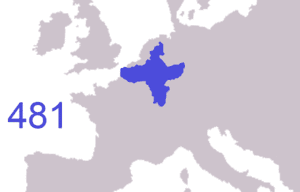

Francia, also called the Kingdom of the Franks and Frankish Empire, grew from 481 onwards as the Franks were united by Clovis I (who ruled c. 481–511). Clovis was a member of the Merovingian dynasty of Frankish kings, between 450 and 751. The Battle of Tours (732) in Aquitaine, where the Franks defeated the Umayyad Caliphate, helped to establish Frankish dominance. Charles Martel commanded the Franks at Tours, and established the Carolingian dynasty of Frankish kings.
On Christmas Day in 800, Pope Leo III crowned Charlemagne (Charles I, the Great) Holy Roman Emperor, as a revival of the Western Roman Emperor. Charlemagne was King of Francia 768–814; King of the Lombards 774–814; and Emperor 800–814. As Charlemagne was a member of the Carolingian dynasty, Francia from 800 is known as the Carolingian Empire.
Charlemagne expanded the kingdom into Bavaria/Carinthia, and Lombard, Saxon and Spanish March territories. Francia by 800 covered much of the former Western Roman Empire, with most of Western and Central Europe; but not including Iberia, Britain, Jutland, Brittany, southern Italy, Venice and the Papal States. Sometimes considered to be the first Holy Roman Empire, but more often called the Carolingian Empire, and it was distinct from the Holy Roman Empire of 962–1806.
Charlemagne was succeeded as Holy Roman Emperor by his son Louis the Pious (813–840). On the death of Louis, civil war erupted (840–43), followed by the Treaty of Verdun; Francia was then divided among the three surviving sons of Louis the Pious:
- West Francia was first ruled by Charles the Bald (who later became Holy Roman Emperor and King of Italy). West Francia is considered to be the Kingdom of France with the rule of the Capetian dynasty (987 onwards).
- Middle Francia was ruled by Lothair I (who was Holy Roman Emperor); it was a short lived state of territory between West and East Francia.
- East Francia was first ruled by Louis the German; it had four stem duchies at the time: Swabia/Alamannia; Franconia; Saxony; and Bavaria (with Carinthia). East Francia would later form the nucleus of the Holy Roman Empire (962–1806) founded by Otto the Great.
With the Treaty of Prüm (855), the sons of Lothair I divided Middle Francia into:
- Lotharingia, which would later became Lorraine and Upper Burgundy, ruled by Lothair II.
- Provence, also known as Lower Burgundy, ruled by Charles of Provence.
- Italy, the northern peninsula, ruled by Louis II of Italy.
By the time of the Treaty of Meerssen (870), Charles of Provence and Lothair II had both died, and Francia had become:
- West Francia, which contained parts of Lotharingia, and some of Provence; ruled by Charles the Bald at that time.
- East Francia, which contained most of Lotharingia; ruled by Louis the German at that time.
- Italy, the northern peninsula, which had expanded to include most of Provence; ruled by Louis II of Italy at that time.
With the Treaty of Ribemont (880), some Lotharingia territory was returned to East Francia from West Francia. Francia was reunited briefly, between 884–887, under Charles III (the Fat), Emperor between 881–888; after that it then divided again. Charles was the last of the Carolingian dynasty of Holy Roman Emperors, with the exception of the disputed Holy Roman Emperor Arnulph (896–899).
Europe from 814
After the death of Charlemagne (814), Europe during the Early Middle Ages included the following states:
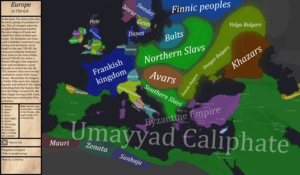
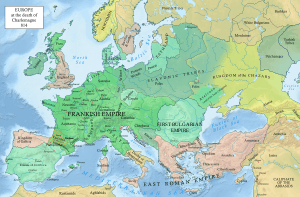
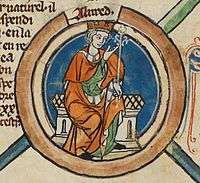
- British Isles
- Alfred the Great, the Anglo-Saxon King of the West Saxons, defeated the Great Heathen Army of the Danish King Guthrum at the Battle of Edington (878) to become first unified King of the Anglo-Saxons. The House of Wessex, which included Alfred, would eventually conquer all of England from the Danes under Æthelstan (c. 927). But there were also Danish kings after this, including Cnut the Great, who reigned over England 1016–1035, as well as Denmark and Norway, as the North Sea Empire. Other tribes of the British Isles included the Welsh and West Welsh (who were Celtic Britons); the Picts; and the Celtic Gaels/Scoti.
- Scandinavia and to the east
- Scandinavia was inhabited by North Germanic peoples, with Danes (in Jutland and Scania), Swedes, Geats, and Gutes. In the Unification of Norway (860s–1020s), the Norwegian Norsemen unified from the petty kingdoms of Norway. Lands of Finns (a Uralic people) lay to the east.
- Western and Central Europe
- Was dominated by Francia (with West Germanic Franks), which remained undivided until 840. Brittany was inhabited by Celtic Britons.
- Slavic states and Balts
- Included Bohemia, with West-Slavic Bohemians, the ancestors of Czechs. Great Moravia (833–c. 907) was a short lived state of the West-Slavic Moravians. Kievan Rus' principalities (882–1240) would form from East Slavic peoples, Finns and Vikings. Serbia (with South-Slavic Serbs) existed as a state between 8th century up to 1371, and then fell to the Ottomans. The Kingdom of Croatia (925–1102) of South-Slavic Croats, developed from the earlier Duchy, and would enter personal union with Hungary in 1102. Carantania (658–828) was a South-Slavic state. The Bulgarian Empire was partly South Slavic. Balts lived near the Baltic Sea, and may have ruled the territory of the Aesti (Esthland or Estonia).
- First Bulgarian Empire (681–1018)
- The First Bulgarian Empire was established by Bulgars (a Turkic people) after defeating the Byzantines at the Battle of Ongal (680); earlier Bulgar nations included Old Great Bulgaria (632–668). After defeating the Byzantines at the Battle of Achelous (917) it achieved hegemony over much of the Balkans. It was eventually subjugated by the Byzantine Empire. Much later on in the High Middle Ages, the Second Bulgarian Empire (1185–1396) was established after uprisings, which eventually fell to the Ottomans.
- Carpathian Basin
- In the Carpathian Basin (or Pannonian Basin), the Avars (a North-east Caucasian people) would form the Avar Khaganate (567–after 822). After being conquered by East Francia and the First Bulgarian Empire, the Magyars (a Uralic people) would establish the Principality (later Kingdom) of Hungary (895–1301).
- Iberian Peninsula
- Included the Islamic Emirate (later Caliphate) of Córdoba in southern Iberia. In the north was the Kingdom of Asturias (718–924, named after the Celtic Astures), which took over Galicia. Later on the Kingdom of Navarre, at first called Pamplona, was traditionally founded in 824; and Asturias would become the Kingdom of León (910–1230).
- Italian Peninsula
- Francia dominated the northern peninsula, and had hegemony over the Papal States. The Republic of Venice (697–1797) was within the Byzantine sphere of influence. Benevento (571–1077) was ruled by the Lombards, with the Byzantine Empire in the south. Later on the Moors would conquer Sicily from the Byzantines, and the Normans would then conquer Sicily and southern Italy.
- Byzantine Empire and to the east
- The Byzantine Empire ruled the southern Balkans and Anatolia. East of the Byzantines was ruled by the Abbasid Caliphate. Khazars (a Turkic people) and Magyars ruled Europe north of the Black Sea.
Islam and the Caliphates
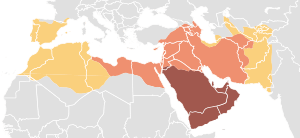
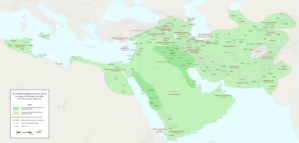
Islam is an Abrahamic monotheistic religion: the central message is that there is only one God (called Allah), and that Muhammad is his prophet, whose scriptures called the Quran are the word of God; later teachings, called the sunnah, are composed of hadiths (sayings). Followers are usually called Muslims.
Shia–Sunni divide: soon after the death of Muhammad, the Muslims were divided into Shia and Sunni branches. Shias (also called Shi'ites) believed that the early caliphs should only have been members of Muhammad's family; so they only recognise the imams as being legitimate. The Battle of Karbala (680), where the supporters and relatives of Husayn ibn Ali (Muhammad's grandson and Shia imam), were defeated by a larger force of the caliph Yazid I (of the Sunni Umayyad caliphate), solidified the Shia-Sunni split. The Shias were instrumental in the Abbasid Revolution (747–750), the overthrow of the Umayyads by the Abbasids. Today the majority of Muslims are Sunni, with Shia majorities only in Iran, Iraq, Bahrain, Lebanon, and Azerbaijan.
A caliphate is a state under the leadership of a caliph, an Islamic steward who claims to be a successor to Muhammad. Islamic rulers also include sultans (who rule over sultanates), and emirs (who rule over emirates). There were four main caliphates post Muhammad (who lived c. 570 to 632):
- Rashidun Caliphate (632–661), with early Muslim conquests, including the conquest of the neo-Persian Sasanian Empire.
- Umayyad Caliphate (661–750), with early Muslim conquests, including the conquest of Hispania (al-Andalus).
- Abbasid Caliphate (750–1258), and the Islamic Golden Age.
- Ottoman Caliphate (1517–1924), a later caliphate of the Ottoman Empire (1299–1922), an empire of the Late Middle Ages and modern period.
Early Muslim conquests (622–750): Muhammad, between 622 and 632, captured much of Arabia. Under the Rashidun Caliphate the Muslim conquest of Persia from the Sasanian Empire occurred, as well as conquering some lands of the Byzantine Empire. The Umayyad Caliphate, founded by Muawiyah I, greatly expanded the empire, particularly over North Africa, Iberia, and east of Persia, including some lands of the Byzantine Empire.
Islamic Golden Age
.png)
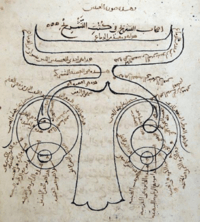
The Islamic Golden Age occurred during the time of the Abbasid Caliphate (750–1258), a Sunni caliphate that succeeded the Umayyad Caliphate; for many years they ruled from the city of Baghdad. Early splinter states included:
- Córdoba (756–1031): the Umayyads held on to al-Andalus (Iberia) as the Emirate of Córdoba, which became a caliphate in 939. It then split into smaller states called taifas, and was later ruled by the Almoravid dynasty and Almohad Caliphate. The Reconquista was the reconquest of Iberia by Christians.
- Smaller dynasties, such as the Idrisids (788–974) who gained Morocco, and the Aghlabids (800–909) who gained Ifriqiya (north-central Africa).
During the Islamic Golden Age, science, economic development and cultural works flourished in the Middle East, with Baghdad as a central hub. The translation movement continued, which was the translation of texts into Arabic, especially from Persian and Greek. Great scholars of the Islamic Golden Age include:
- Al-Khwarizmi was a Persian scholar who made great advances in algebra, the Arabic being "al-jabr". He also developed and popularized Hindu–Arabic numerals.
- Ibn al-Haytham was an Arab scholar described as the "father of modern optics"; he was the first to describe sight as light reflecting from an object and then entering the eyes.
- Jabir ibn Hayyan was known as the "father of chemistry", making advances in alchemy, cosmology, numerology, astrology, medicine, magic, mysticism and philosophy.
- Ibn al-Nafis was an Arab physician who first to described the pulmonary circulation of the blood.
- Avicenna (Ibn Sina) was a Persian polymath who wrote the hugely influential The Canon of Medicine and The Book of Healing.
- Al-Zahrawi was an Arab physician, surgeon and chemist, and is considered as the "father of surgery". He described over 200 surgical instruments, and used catgut for internal stitching.
- Al-Razi was a Persian polymath and physician, and an early proponent of experimental medicine.
- Omar Khayyam was a Persian mathematician, astronomer, and poet, who devised a very accurate solar calendar.
- Ismail al-Jazari was an Arab polymath who wrote The Book of Knowledge of Ingenious Mechanical Devices, describing many mechanical devices.
- Nasir al-Din al-Tusi and Al-Battani greatly advanced trigonometry.
By about 892 and the death of Al-Mu'tamid, the Abbasid's direct rule was reduced mostly to Mesopotamia and western Arabia, with other autonomous rulers adhering to nominal Abbasid suzerainty. Later on Abbasid political power would further diminish, especially with the rise of the Iranian Buyids and Seljuk Turks. But the Abbasids would be recognized as caliphs by most dynasties that followed, and there were also later political revivals.
Islam during the ninth and tenth centuries
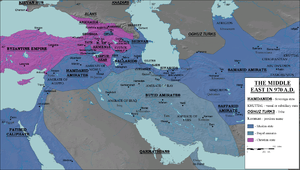
Arab and Berber dynasties included the Abbasids, but the Hamdanid dynasty and Fatimid Caliphate would also gain prominence:
- Hamdanid dynasty (890–1004) was a Shia Muslim Arab dynasty of northern Mesopotamia and Syria. It would fall to the Uqaylid dynasty (990–1096), a Shia Arab dynasty.
- Fatimid Caliphate (909–1171) was an Arab and Berber Caliphate of the Isma'ili-Shia. Starting in North Africa and Sicily, it spread to Egypt, the Holy Land, and western Arabia. It was eventually reduced mostly to Egypt, and would later be taken over by the Ayyubid dynasty.
The "Shia Century" was the period of vitality by Shia Muslim dynasties starting in the tenth century, such as the Hamdanids, Uqaylids, Fatimids, and Buyids; although many Iranian dynasties were Sunni Islam. It ended with the "Sunni Revival", with the rise of Turkic dynasties of Sunni Islam.
The Iranian Intermezzo was an interlude of ethnic Iranian dynasties (mainly Persians and Kurds), between the dominance of the Arab and Berber dynasties in the Middle East, and the rise of Turkic dynasties:
- Buyid dynasty (934–1062) was a Shia Iranian dynasty, which would rule lands in Mesopotamia and Persia during this time.
- Other Iranian dynasties tended to be more Sunni Islam, and included the Samanids (819–999), Tahirids (821–873), Saffarids (861–1003), Sajids (889–929), Ziyarids (930–1090), and Sallarids (942–979).
Turkic dynasties, of Sunni Islam, ended the Iranian Intermezzo, such as the Ghaznavids, Seljuk Turks, and Khwarazmians.
Reconquista
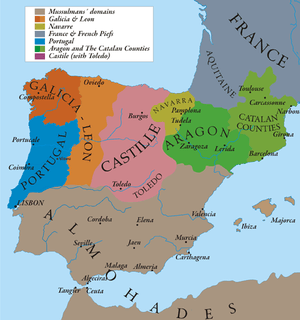
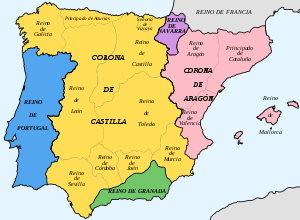
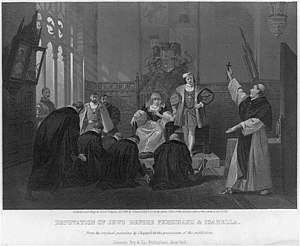
The Umayyad conquest of Hispania (711–788) was the capture of Iberia by the Umayyad Caliphate from the Visigoths, who by 624 had gained control of all of Iberia. Hispania was the Roman name for Iberia, which is now Spain and Portugal. The Islamic dominions of Iberia were known as al-Andalus; they were ruled by Muslim Arabs and Berbers known as Moors. The Emirate of Córdoba (756–939) was a splinter state ruled by the Umayyads, after al-Andalus separated from the Abbasid Caliphate. Córdoba would later became a caliphate (939–1031), before splitting into many independent states, called taifas.
The Reconquista was the reconquest of Iberia by Christians, began after the Battle of Covadonga (either 718 or 722), where the Visigoth Pelagius of Asturias defeated the Moors. The Christian Kingdom of Asturias was founded after it. The Franks were successful in early battles against the Moors; at the Battle of Tours (732), also known as the Battle of Poitiers, the Frankish leader Charles Martel defeated the Umayyad Caliphate. After Barcelona was conquered by the Moors, the city was retaken by Franks, led by Louis the Pious, in 801. Almanzor, the Umayyad vizier between 978 and 1002, waged many campaigns against the northern Christian kingdoms.
Alfonso III of Asturias (866–910) would consolidate power and have numerous victories over Islamic and Christian opponents. It is assumed that the old Asturian kingdom was divided between the three sons of Alfonso III of Asturias, into the kingdoms of León, Asturias and Galicia. The Kingdom of León was so named as the capital was shifted from the city of Oviedo to the city of León in 910. The Kingdom of León would unite with the Kingdom of Asturias in 924; and the Kingdom of León would at times be in personal union with the Kingdom of Galicia, with this becoming permanent with the Crown of Castile of 1230 to 1715.
Iberia during the High Middle Ages
During the High Middle Ages, Al-Andalus (that is, Islamic Iberia) rulers would include the Almoravid dynasty (1040–1147), and Almohad Caliphate (1121–1269).
During the High Middle Ages, the Kingdom of León would give rise to two new kingdoms:
- Kingdom of Castile (1065–1230): in 931 the County of Castile separated from the Kingdom of León; Castile became a kingdom in 1065. Between 1037 and 1065, and 1072 and 1157, Castile and León would be in personal union. With the Crown of Castile of 1230 to 1715, Castile and León and would be permanently united. With Castile and León, the crown would eventually unite the kingdoms of Galicia, Toledo, Seville, Córdoba, Jaén, Murcia, Granada, and Navarre; and the Principality of Asturias and Lordship of Biscay.
- Kingdom of Portugal (1139–1910): the County of Portugal (1093–1139), in 1128 with the Battle of São Mamede, achieved independence from the Kingdom of León, and then became a kingdom.
The Kingdom of Navarre, traditionally founded in 824 as the Kingdom of Pamplona, was a northern Basque-based kingdom. Sancho III of Pamplona was King of Pamplona/Navarre (1004–1035); he gained suzerainty of many lands, including the counties of Aragon, Castile and Barcelona, as well as León and the French Duchy of Gascony. His son Ferdinand I of León would rule both Castile and León; his other sons were García Sánchez III of Pamplona, and Gonzalo of Sobrarbe and Ribagorza, and Ramiro I of Aragon.
The County of Aragon would become the Kingdom of Aragon (1035–1707), first ruled by Ramiro I; later the Crown of Aragon (1162–1716) would be result from the Union of the Kingdom of Aragon and the County of Barcelona, El Cid (Rodrigo Díaz de Vivar) took Valencia from Muslims in 1094; it would later be retaken by Muslims before being conquered by Aragon.
After the Siege of Córdoba (1236) and Siege of Seville (1247-1248), the cities fell to Castile. By 1250 only the Emirate of Granada remained Islamic; the northern Christian states consisted of the crowns of Castile and Aragon, and the kingdoms of Portugal and Navarre.
Iberia during the Late Middle Ages
King Ferdinand of Aragon and Queen Isabella of Castile were later called the Catholic Monarchs; they were both from the House of Trastámara, and their marriage in 1469 marked the de facto unification of Spain (as Aragon and Castile). In 1478, Ferdinand and Isabella launched the Spanish Inquisition primarily to identify heretics, especially among the conversos, those who converted to Catholicism from Judaism and Islam; Tomás de Torquemada was the first Grand Inquisitor between 1483 and 1498.
Ferdinand and Isabella completed the Reconquista with a victorious war against the Emirate of Granada (1482–1492). After the Reconquista, the Alhambra Decree (1492) led to the expulsion of Jews from Spain, although Jews who converted to Christianity escaped expulsion. It was followed by forced conversions and expulsions of Muslims; even some Moriscos (i.e. Muslims who had converted to Christianity) experienced expulsion.
In 1512, most of the Kingdom of Navarre was annexed to the Crown of Castile. In 1519 the crowns of Aragon and Castile would join in personal union with Charles V, Holy Roman Emperor, and from then onwards they remained in personal union, finally becoming a unified crown of Spain in 1715. But Portugal would remain independent of Spain, except for the period of the Iberian Union (1580-1640).
Chapter 2 High Middle Ages
The High Middle Ages was circa AD 1000–1300, or 1000–1250.
See also Wikipedia:High Middle Ages.
States and territories of the High Middle Ages
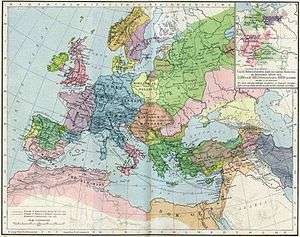
States and territories of the High Middle Ages included:
- Northern Europe
- Britain Isles included England, Scotland, Wales, and Ireland. Nordic countries included Norway, Denmark, and Sweden, and lands of the Sami and Finns. Valdemar I of Denmark saw his country becoming a leading force in northern Europe.
- Western and Central Europe
- Consisted of the Kingdom of France and the Holy Roman Empire.
- Eastern Europe
- In the Kingdom of Poland (1025–1569), Casimir III of Poland doubled the size of kingdom by the end of his reign (1333–1370) and considerably strengthened the nation. Around the Baltic Sea there were Finnic Estonians and Livonians; and Baltic Tribes, composed of Balts, including Old Prussians, Lithuanians, and Latvians. Further east was Kievan Rus' (882–1240; founded by the Rus' people), and the Novgorod Republic (1136–1478). The Balkans were dominated by five states: Hungary (which gained hegemony over Croatia, Bosnia, Slavonia, Dalmatia and Transylvania); Grand Principality of Serbia (1091–1217, which expanded over what is today Serbia, Montenegro, Bosnia and Herzegovina, and southern Dalmatia); the Second Bulgarian Empire; and the Byzantine Empire (which included Greece and some of Anatolia); and the Cuman-Kipchak confederation (a Turkic state also known as Cumania, of the 10th century to 1241).
- Iberian Peninsula
- Included the Christian kingdoms of Castile, León, Navarre, Aragon, Portugal. The Muslim Caliphate of Córdoba was, after 1031, replaced by taifa (independent Muslim states). The Reconquista (722–1492) was the reconquest of Iberia by Christians.
- Italian Peninsula
- Included the Kingdom of Sicily, which was under Norman rule from 1091, which included southern Italy by 1130. The Republic of Venice, Papal States, and the Holy Roman Empire were in the north.
Normans
Normans: came from Normandy, a northern region of France, and were descended from Vikings and indigenous Gallo-Romans and Franks. They gained gained political legitimacy in 911 when the Viking leader Rollo agreed to swear allegiance to King Charles III of West Francia, in exchange for ceding them lands. Culturally, they were known for their Norman architecture (also known as Romanesque architecture); they adopted a Gallo-Romance language called Norman French.
From the 11th century onwards they conquered the Kingdom of England, and the Kingdom of Sicily (which was mainly in southern Italy and Sicily), as well as other territories, including in the Middle East. The Norman conquest of England, under William the Conqueror, began with the Battle of Hastings in 1066. Later on their influence would spread to the rest of the British Isles (Wales, Scotland, and Ireland).
The Kingdom of Sicily (1130–1816) was formed, between 999 and 1139, as a Norman kingdom in southern Italy, Sicily, northern Africa and Malta. Conquered territories in southern Italy included (based on Italy at around 1000 AD): territory held by the Byzantine Empire (roughly modern day Calabria and Apulia); Salerno (roughly Basilicata); Benevento (except for the city); Capua; Amalfi; the southern region of Spoleto; and the Muslim-held Emirate of Sicily. Later on southern Italy would cede from Sicily to form the Kingdom of Naples (1282–1816).
England and the Angevin Empire

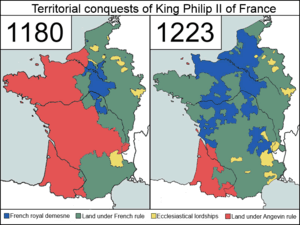
After the Norman conquest of England, which began with the Battle of Hastings (1066), England was ruled by the House of Normandy; the reign of William the Conqueror (1066–1087), was followed by that of his sons William II (1087–1100) and Henry I (1100–1135). But after the death of Henry I, a succession crisis between the Empress Matilda (Henry I's daughter), and Stephen of Blois (Henry I's nephew), brought about the Anarchy (1135–1153), a period of civil war between the claimants. The Anarchy was ended by the Treaty of Wallingford (1153), where Stephen recognized Matilda's son Henry II as heir to the crown.
King Henry II (who reigned 1154–1189) was the first of the Plantagenet dynasty of English kings (1154–1485), named after his father Geoffrey Plantagenet, the Count of Anjou. Henry II would inherit the following titles:
- King of England, from his mother's claim, the Empress Matilda
- Duke of Normandy, and Count of Anjou, Touraine, and Maine, from his father
- Duke of Aquitaine, from his wife Eleanor of Aquitaine, Duchess of Aquitaine
Henry II also partially controlled the Duchy of Brittany, as well as Scotland and Wales. After the Norman invasion of Ireland (1169–1171), Henry II became Lord of Ireland. Henry II's empire became known as the Angevin Empire (1154–1214), named after the county of Anjou. The Angevin kings of England were the kings who ruled the Angevin Empire, the first three Plantagenets: Henry II, and his sons King Richard I (Richard the Lionheart) and King John. As well as the Angevin Empire, France consisted of the domaine royal (directly controlled by the king), ecclesiastical lordships, and various other fiefs (including those of the Languedoc province).
Capetian–Plantagenet rivalry (1159-1259), between the French House of Capet and the English House of Plantagenet, resulted from the Angevin Empire, and a series of wars over the territory is sometimes considered to be the "First Hundred Years War". King John (who reigned 1199–1216) lost control of most of his French possessions to King Philip II of France (Philippe Auguste), who reigned 1180 to 1223. It included the successful French invasion of Normandy (1202–1204). The Anglo-French War of 1213 to 1214 culminated in French victory against the Holy Roman Emperor Otto IV at the Battle of Bouvines, who had allied with the English. Only Gascony in southern Aquitaine would remain English.
The Magna Carta ("Great Charter") was then forced upon John by the English barons; it guaranteed certain rights, and was agreed at Runnymede, near Windsor, on 15 June 1215. This was followed by the First Barons' War (1215–1217), after John reneged on the Great Charter, which he had annulled by Pope Innocent III. The future Louis VIII of France (the son of Philip II) backed the rebellious barons, and claimed the English throne between 1216 and 1217. In 1216 John was succeeded by his son Henry III, who reissued a modified Great Charter in 1216 to try to appease the barons; Louis was eventually defeated as the barons defected to Henry III. Great Charters were also issued in 1217, 1225, and 1297.
Henry III was succeeded by his son Edward I (also called Edward Longshanks and the Hammer of the Scots); and then by his son Edward II (also called Edward of Carnarvon). Power was wrestled from Edward II by his son Edward III (1327–1377), backed by Edward III's mother Isabella of France and Roger Mortimer. During the reign of Edward III, the loss of Gascony (1337), and Edward's rival claim to the French crown, triggered the Hundred Years' War.
Holy Roman Empire
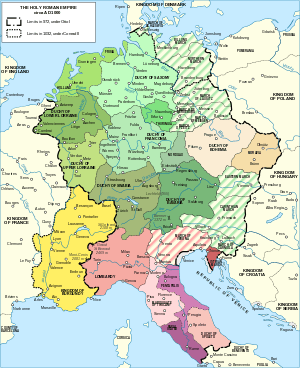

Holy Roman Empire (962–1806), of Emperor Otto I the Great, was a union of East Francia and Italy. Otto was a Saxon, and Duke of Saxony and King of East Francia from 936; King of Italy from 961; and Holy Roman Emperor between 962–973, after a large interregnum (gap) between 924–962 (38 years). The Nazis considered it to be the first German Reich (Deutsches Reich), where reich is roughly comparable to "realm". Before their coronation as emperors, or as heir-apparents, their rulers were designated as kings, most commonly as "King of the Romans".
By 947, the former Francia had divided into four kingdoms: West Francia; East Francia; Kingdom of Italy; Kingdom of Arles. East Francia and the Kingdom of Italy initially formed the Holy Roman Empire; later on Bohemia (which was never part of Francia) and the Kingdom of Arles joined. West Francia would go on to form the Kingdom of France.
- 1. East Francia by 962 had six stem duchies: (i) Franconia; (ii) Swabia (former Alamannia); (iii) Saxony; (iv) Bavaria; (v) Upper Lorraine (in south); (vi) Lower Lorraine (in north). It remained the centre of the Holy Roman Empire for its lifetime, and is sometimes considered as the Kingdom of Germany.
- 2. The Kingdom of Italy was roughly the Italian Republic north. At about 1000 it included Lombardy, the March of Verona and Aquileia, the March of Tuscany, and the Duchy of Spoleto; but excluded Venice and the Papal States. Holy Roman Emperors were also kings of Italy between 962–1493 and 1519–1556 (Charles V). After that Italy was nominally within the Holy Roman Empire until 1801, but power was lost.
Later territories gained by Holy Roman Empire (East Francia and Italy) were Bohemia and the Kingdom of Arles:
- 3. Duchy/Kingdom of Bohemia, a Holy Roman Empire state between 1002–1806. Now roughly the Czech Republic (with Moravia and Silesia). Raised to a kingdom between 1198–1918; sometimes the Emperor was also king.
- 4. Kingdom of Arles/Arelat of 933–1378; part of the Holy Roman Empire between 1032–1378. The Kingdom of Upper Burgundy established from 888, was composed of Transjurania and the County of Burgundy. The Kingdom of Lower Burgundy, which was composed of Cisjurania and Provence, joined in 933 to form Arles. Now partly Swiss, French and Italian. Distinct from the French Duchy of Burgundy, which was a separate territory.
Also, the Kingdom of Sicily (of southern Italy and Sicily) was in personal union with the Holy Roman Empire between 1194–1254.
The Holy Roman Empire achieved its greatest extent during the Hohenstaufen dynasty of kings, who were emperors between 1155–1250, except for 1198–1215. Frederick I Barbarossa (Emperor 1155–1190) held great power, despite defeats by the Lombard League. But under Frederick II (Emperor 1220–1250), the rule of the emperor was weakened with the Confoederatio cum principibus ecclesiasticis ("Treaty with the princes of the church") of 1220, and the Statutum in favorem principum ("Statute in favour of the princes"), confirmed in 1232. Frederick II was also king of Sicily (1198–1250).
Later, large interregnums (gaps) of Emperors occurred between the years of 1245–1312 (67 years) and 1378–1433 (55 years). The Golden Bull of 1356 named seven Prince-electors who chose the Emperor: Archbishops of Mainz, Cologne and Trier; King of Bohemia; Count Palatine of the Rhine; Duke of Saxony-Wittenberg; Margrave of Brandenburg.
Christianity and the Great Schism

Christianity: is an Abrahamic monotheistic religion based on the teachings of Jesus Christ as described in the New Testament. Christians, the members of the faith, believe that Jesus is the Messiah as prophesied in the Old Testament; and, apart from Nontrinitarians, that God is a Holy Trinity of the Father, the Son of God (Jesus Christ), and the Holy Spirit. Early Christianity was from its origins (c. 30–36) until the First Council of Nicaea (325); this created the Nicene Creed and was the first ecumenical council. Constantine the Great (who reigned East 306–324, and East and West 324–337) was the first Christian Roman Emperor. By the time of the 6th century, Christianity was dominate throughout Europe, but not including northern and eastern Europe, and Scandinavia. By the time of the 11th century, the majority of Europe was Christianised, with the exception of some Baltic states and eastern Scandinavia, and Islamic Iberia.
Great Schism, or East–West Schism, of 1054: the Roman Catholic and Eastern Orthodox churches separated, after the mutual excommunication of the Michael I Cerularius (the Ecumenical Patriarch of Constantinople) and Cardinal Humbert of Silva Candida, papal legate of Pope Leo IX. There were many reasons for the schism, including doctrinal, theological, linguistic, political, and geographical reasons. A particular issue was the question of the authority of Constantinople and Rome over the other three seats of the Pentarchy; that is, Antioch, Jerusalem and Alexandria.
Since that time the Roman Catholic and Eastern Orthodox churches have remained separate. The Roman Catholic Church consists of the western Latin Church, and 23 Eastern Catholic Churches. The Holy See is the jurisdiction of the pope, and includes the Diocese of Rome (as the Bishop of Rome), the worldwide Roman Catholic Church (as leader in full communion with), and the Vatican City state (as sovereign). During the pre-Protestant Bohemian Reformation (after the Hussite Wars, 1419–1434) and the Protestant Reformation (1517 onwards), some churches in the west seceded from the Catholics.
The present-day Eastern Orthodox church, officially the Orthodox Catholic Church, is a communion that includes many Orthodox churches. The Greek Orthodox Church includes the Ecumenical Patriarchate of Constantinople, and the Greek Orthodox Patriarchates of Alexandria, Antioch and Jerusalem, and the Churches of Greece, Albania, Crete and Sinai. Other major Orthodox Churches include those of Russia, Ukraine, Romania, Serbia, and Bulgaria. The Ecumenical Patriarch of Constantinople has the status of primus inter pares (first among equals) among the other Eastern Orthodox prelates (bishops and patriarchs).
Oriental Orthodoxy has been separate to Eastern Orthodoxy since the Council of Chalcedon (451), and includes churches in Alexandria (the Coptic Orthodox Church), Antioch (Syriac Orthodox), Armenia (Apostolic), India (Malankara Orthodox Syrian), and the Orthodox Tewahedo Churches of Ethiopia and Eritrea.
Islam, Crusades, and Mongol invasions
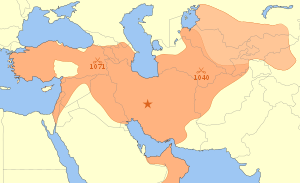
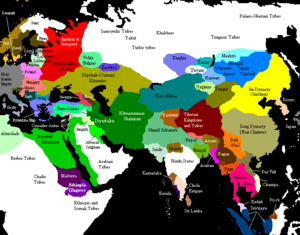
The Islamic Golden Age continued into the High Middle Ages. Although the influence of the Abbasid Caliphate (750–1258) would wane, they would continue to be recognized as caliphs by most Islamic dynasties, and would survive until the Mongol invasions. The Iranian Intermezzo ended with the rise of some Islamic Turkic dynasties in the Middle East; these included:
- Ghaznavid dynasty (977–1186) was a Turkic Sunni Muslim dynasty that gained territories, including from both the Iranian Samanids and Saffarids. At its greatest extent about 1030, it fell across modern-day Iran and Afghanistan, and all the way to the Indian subcontinent. It would fall mainly to the Seljuk Empire and the Ghurid dynasty.
- Seljuk Empire (1037–1194) was a Turko-Persian Sunni Muslim empire, founded by the Oghuz Turkic warlord Seljuk Beig. They took lands from other dynasties, including from the Iranian Buyid dynasty and the Turkic Ghaznavid dynasty. With its greatest extent in about 1092, it covered a vast area, including Palestine, and much of Anatolia, the Levant, Persia and beyond. The Battle of Manzikert (1071) was decisive in their capture of much of Anatolia from the Byzantines.
- Seljuk Sultanate of Rum (1077–1308) was a Seljuk Turk splinter state in Anatolia. Surviving long after the Seljuk Empire, it declined after defeat by Mongols.
- Zengid dynasty (1127–1250) was a Turkic state of Sunni and Shia Islam. Originally a Seljuk Turk vassal, it continued for a while after the Seljuk Empire, before falling to the Mongols and Ayyubids.
- Khwarazmian dynasty (1077–1231) was a Persianate Sunni Muslim dynasty of Turkic origin, that gained much of Persia and beyond, mainly from the Seljuks and Ghurid dynasty. It ended after the Mongol conquest of Khwarezmia (1219–1221), with a heavy toll on life.
As well as the Turkic dynasties, the Ghurid dynasty (before 879–1215) was an Iranian dynasty from the Ghor region of present-day central Afghanistan, gaining its greatest extent around 1200, including territories from the Ghaznavids and Seljuks. The dynasty converted to Sunni Islam from Buddhism. It fell across modern-day Iran and Afghanistan, and the northern Indian subcontinent all the way to Bengal. It would fall mainly to the Delhi Sultanate and Khwarazmian dynasty.
At around 1200, when the Abbasid, Seljuk Rum, Khwarazmian, and Zengid dynasties were still active in the Middle East, there was two major Islamic dynasties in northern Africa:
- Ayyubid Sultanate (1171–1260), overthrew the Fatimid Caliphate of Egypt. Ayyub's son Saladin was their first sultan (1174–1193), a Kurdish Sunni Muslim who switched allegiance to the Abbasid caliphs. It conquered Jerusalem from the crusaders (1187) and other lands in the Middle East. They eventually fell to the Mamluk Sultanate.
- Almohad Caliphate (1147–1269) was a Moroccan Berber Sunni caliphate. It ruled much of western north Africa and southern Iberia. It was overthrown by the Marinid dynasty.
Later on there would be Islamic dynasties such as the Mamluk Sultanate of Cairo, and the beginnings of the Ottoman Empire.
Crusades and crusaders
.jpg)
The crusades were a series of holy wars, predominantly Christians against Muslim-held territories. The immediate cause was the Byzantine–Seljuk wars (1048–1308), an ongoing conflict over Anatolia, and in 1095 the Byzantine Emperor Alexios I Komnenos requested military aid from Pope Urban II; Urban II responded by calling for war against the Seljuk Turks in the Holy Land.
The crusaders opened trade routes which enabled the merchant republics of Genoa and Venice to become major economic powers. It led to the establishment of diverse religious-military orders; they included:
- Knights Templar (the Order of Solomon's Temple), who built a network of nearly 1,000 commanderies and fortifications across Europe and the Holy Land, before being disbanded by Philip IV of France and Pope Clement V
- Knights Hospitaller (the Order of Saint John), who later became knights of Cyprus, Rhodes, and Malta, and are now the Sovereign Military Order of Malta
- Teutonic Order (the German Order): formed to aid Christians on their pilgrimages to the Holy Land, and took part in the Prussian Crusade (a Northern Crusade), and merged with the Livonian Brothers of the Sword
- Livonian Brothers of the Sword: they took part in the Livonian Crusade (a Northern Crusade), and later merged with the Teutonic Order as the Livonian Order
As well as the Crusades to the Holy Land, other crusades included:
- Northern Crusades (1147–1410) were primarily against pagans, from the Baltic, Finnic and West Slavic peoples; Baltic states that resulted included the State of the Teutonic Order (Prussia) and Terra Mariana (of present day Estonia and Latvia).
- Crusades against Christians occurred between 1235 and 1434: they included the Albigensian Crusade (1209–1229) against Cathars in southern France.
- Between 1291 and 1481 there were was then a number of additional crusades against Muslims that didn't target Jerusalem. There was also some anti-Muslim crusades during the Reconquista (718–1492).
Crusades to the Holy Land and Latin Empire
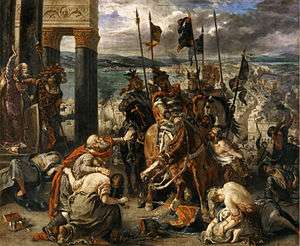
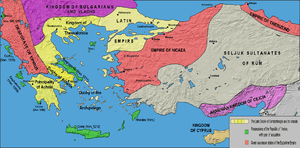
There were nine numbered Crusades to the Holy Land (1095–1291), but there were many additional ones. The popular crusades (1096–1320) were unsanctioned by the Church, and were minor crusades which achieved very little; they included the People's Crusade (1096), Children's Crusade (1212), Shepherds' Crusade (of 1251 and 1320), and Crusade of the Poor (1309).
The Seljuks held Jerusalem, from 1073–1098; before that it had been held by the Byzantines (to 638) and the Caliphates. After that, Jerusalem was held by the Fatimid Caliphate (1098–1099); Crusaders (1099–1187); the Ayyubid Sultanate (of Saladin), Christians and Khwarezmian Tatars (at various times between 1187 and 1260); the Mamluk Sultanate (1260–1517); the Ottoman Empire (1517–1917).
Notable crusades included:
- First Crusade (1095–1099) resulted in the conquest of Jerusalem and the Holy Land. It was preceded by the People's Crusade (1096), and followed by the Crusade of 1101 (Crusade of the Faint-Hearted), which were both Turkish victories.
Crusader states were then established, and included the Kingdom of Jerusalem, the Principality of Antioch, the County of Tripoli and the County of Edessa. Nicaea and much of western Anatolia was also restored to the Byzantine Empire.
- Venetian Crusade (1122–24), in which the Republic of Venice succeeded in capturing Tyre.
- Second Crusade (1147–1149) was a failed attempt to reclaim of Edessa after its fall in 1144.
Jerusalem was retaken by Muslims led by Saladin of the Ayyubid Sultanate in 1187, reverting to Christian control in 1229.
- Third Crusade (1189–1192) included as crusaders Philip II of France, Richard I of England, and the Holy Roman Emperor Frederick Barbarossa. It failed to retake Jerusalem, but a treaty provided that unarmed Christian pilgrims and traders could visit Jerusalem. Crusader territories were reclaimed, including the key towns of Acre and Jaffa; the crusader state of the Kingdom of Cyprus was established.
- Crusade of 1197, of Henry VI, Holy Roman Emperor, resulted in the capture Beirut and Sidon from the Muslims in 1198.
- Fourth Crusade (1202–1204) primarily resulted in the Sack of Constantinople (1204) by crusaders and the Republic of Venice. The Catholic city of Zara was also sacked by crusaders.
After that the Byzantine Empire was partitioned: the Latin Empire of Constantinople was a crusader state, which had crusader vassal fiefs such as Thessalonica, Achaea, Athens, and the Archipelago. Venice took control of some areas, such as Crete. Greek successor states were established in Nicaea, Epirus, and Trebizond. The Nicaean–Latin wars of Nicaea and the Latin Empire commenced, and as well as the Bulgarian–Latin wars.
- Fifth Crusade (1217–1221) was an unsuccessful attempt to conquer the powerful Ayyubid state in Egypt, to later regain Jerusalem.
- Sixth Crusade (1228–1229) resulted in a diplomatic crusader victory, who gained control of Jerusalem between 1229 and 1244.
- Barons' Crusade (1239–1241) enlarged the territory controlled by the crusaders, and was in territorial terms the most successful crusade since the First.
Reconquest of Constantinople: Nicea was later able to recapture much of the Latin Empire and Epirus, including Constantinople in 1261, and the Byzantine Empire continued as a weakened Greek state. Later on a Byzantine civil war (1341–1347) further weakened the empire. Eventually Constantinople would fall to the Ottomans in 1453.
Jerusalem was lost to Khwarezmian Tatars (1244–1247), the Ayyubids (1247–1260), and the Mamluk Sultanate (1260–1517). The Seventh (1248–1254), Eighth (1270), and Ninth (1271–1272) Crusades had varying degrees of success, but didn't retake Jerusalem.
Mongol Empire
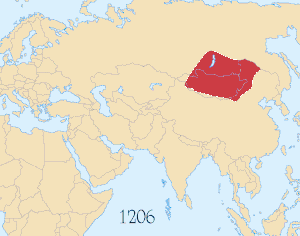
Genghis Khan founded the Mongol Empire in 1206; it eventually covered most of central Asia from the west to east. The Mongols were a group of steppe nomads. Khan is a title for a sovereign or a military ruler, used by Mongols living to the north of China. An estimated 30 to 80 million people were killed under the rule of the Mongol Empire.
By c. 1294, with the death of Kublai Khan, it had fractured into independent states:
- Golden Horde (1242–1502), a khanate in the north-west, mostly north of the Black Sea and Caspian Sea. It would disintegrate to many other khanates in the fifteenth century.
- Ilkhanate (1256–1335) a short-lived khanate in the south-west, across the Middle East and Persia.
- Chagatai Khanate (1226–1705) in central Asia, centered on present-day Kyrgyzstan. It would decline to other dynasties.
- Yuan dynasty (1271–1368) in the east, based in modern-day Beijing; it included much of present-day China and Mongolia. It would fall to the Ming dynasty (1368–1644).
End of the Islamic Golden Age
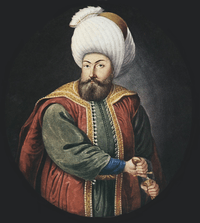
The Siege of Baghdad (1258) was by the Mongols under the command of Hulagu Khan. They subsequently sacked the city and destroyed the copious libraries, including the House of Wisdom; hundreds of thousands of people were killed in the region. This ended the Abbasid Caliphate and Islamic Golden Age, and the region was made part of the Mongol Empire.
The Mongol Empire was in part succeeded by the Ilkhanate (1256–1335), the south-west sector of the Mongol Empire. In the 1330s, outbreaks of the Black Death ravaged the Ilkhanate, causing it to disintegrate. The Timurid Empire (1370–1507) was a latter large Turco-Mongol empire of the Middle East and beyond, which continued the Mongol legacy. In part it was succeeded by the Iranian Shia Muslim Safavid dynasty (1501–1736).
In Egypt and the Middle East, the Mamluk Sultanate of Cairo (1261–1517), also known as the Realm of the Turks, overthrew the Ayyubids. It was an Arabic, Turkic and Circassian Sunni sultanate. With the fall of the Abbasids in 1258 and the end of the Islamic Golden Age, the Mamluks attempted to re-establish a Sunni Abbasid Caliphate with the Caliphs of Cairo; they were largely ceremonial caliphs under the patronage of the sultans. The Mamluk Sultanate eventually fell to the Ottoman Empire.
The Ottoman Empire (c. 1299–1922) was founded by Osman I of the House of Osman. Starting from a small Anatolian beylik (state), and with the decline of the Sultanate of Rum, they would go on to build a vast empire, including territories in Anatolia, eastern Europe, the Middle East, and northern Africa.
Golden Horde
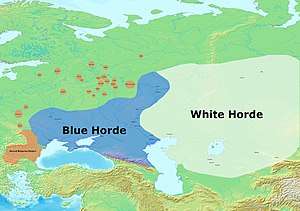
Golden Horde (1242–1502), or Kipchak Khanate, was originally a Mongol, and later Turkicized, khanate founded by Batu Khan, a Mongol warlord who followed the Tengrism religion. It originated as the north-western sector of the Mongol Empire. It had a geographic area roughly comparable to the earlier Cumania (the Cuman-Kipchak confederation), a Turkic state of the Cumans and Kipchaks; and that of Volga Bulgaria, a historic Bulgar state. It was majorly divided into Blue Horde (Kok Horde) and White Horde (Ak Horde). Öz Beg Khan assumed the throne in 1313, and adopted Islam as the state religion.
With the Mongol invasion of Kievan Rus' (1237–1242), the last vestiges of the state finally disintegrated, and its former principalities became Mongol vassals; there was widespread destruction, but the Novgorod Republic remained relatively unscathed. The "Tatar Yoke" is a phrase often used to express their rule, as many of the rulers became Tatars, who were Turkic peoples who adopted the Kipchak language as a common tongue. With the breakup of Kievan Rus', the East Slavic peoples would eventually evolve three separate nations: modern-day Russia, Ukraine and Belarus. Russia would develop from the rise of the Grand Duchy of Moscow, also called Muscovy.
The Golden Horde would lose control of the Rus' principalities, and then disintegrate into a number of Turkic-speaking khanates: Tyumen Khanate (1468), later Khanate of Sibir; Khanate of Kazan (1438) – Qasim Khanate (1452); Khanate of Crimea (1441); Nogai Horde (1440s); Kazakh Khanate (1465); and Khanate of Astrakhan (1466). These would all fall to Russian expansion. See also the Rise of Muscovy for more about Kievan Rus' and the rise of Muscovy.
Medieval renaissances and cultural changes
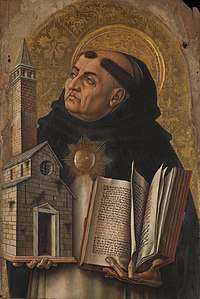
Medieval renaissances can refer to various movements in the latter half of the Early Middle Ages, and during the High Middle Ages.
- Carolingian renaissance, of the 8th and 9th centuries, was a period of renewed cultural and intellectual movements associated with the rise of the Carolingian Empire, and the Carolingian court.
- Ottonian renaissance, of the 10th and 11th centuries, was a similar phenomenon associated with the Ottonian period of the Holy Roman Empire. Otto I, Otto II and Otto III ruled the culturally Germanic empire between 936–1002, and created a revival particularly in arts and architecture.
- Renaissance of the 12th century: included social, political and economic transformations; intellectual revitalization (philosophical and scientific). It included Latin translations of Arabic sources.
In the thirteenth century, Thomas Aquinas developed scholasticism (early critical thought in a religious context) with his Summa Theologica; written between 1265 and 1274, it was a treatise on theology that drew from a wide range of philosophical sources. It attempted to reconcile the philosophy of Aristotle with the theology of Augustine of Hippo, using both reason and faith. In 1202, in his Book of Calculation, the Italian mathematician Fibonacci helped to populise Arabic numerals.
Romanesque architecture (also known as Norman architecture) dominated 11th and 12th centuries; earlier architecture was known as Pre-Romanesque. Later on Gothic architecture was used widely between the 12th and 16th centuries.
The High Middle Ages was accompanied by a rapid increase in population; this would grind to a halt in the 14th century, as Europe would enter a period of crisis.
Chapter 3 Late Middle Ages
The Late Middle Ages was circa AD 1300–1500 or 1250–1500.
See also Wikipedia:Late Middle Ages.
States and territories of the Late Middle Ages
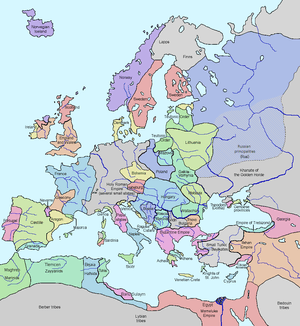
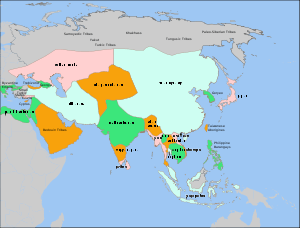
States and territories of the Late Middle Ages included:
- Northern Europe
- British Isles included England and Wales, Ireland, and Scotland. The Kalmar Union (1397–1523) was of the three kingdoms of Denmark, Sweden (then including most of Finland), and Norway. There were also lands of Lapps and Finns.
- Western and Central Europe
- France with Gascony (in southern Aquitaine); Gascony precipitated the Hundred Years' War when it was lost by the English. The Holy Roman Empire was east of France.
- Eastern Europe
- Included Poland (including Mazovia) and Lithuania; Galicia–Volhynia was later divided between Poland and Lithuania. The State of the Teutonic Order (Prussia) and Terra Mariana (of present day Estonia and Latvia between 1207–1561) were Baltic crusader states. Further east: the Kievan Rus' principalities were vassals of the Golden Horde khanate; there was also the Novgorod Republic (1136–1478). Balkans states: included the Kingdom of Hungary, which included the Banate of Bosnia, Croatia, and Transylvania. The Danubian Principalities (Wallachia and Moldavia) were vassals of the Hungarians; after gaining independence they would become vassals of the Ottomans. Further south were the Byzantine Empire, the Second Bulgarian Empire (1185–1396), the Serbian Empire, crusader states (e.g. the Duchy of Athens), and possessions of Venice and Genoa. Louis I of Hungary was was King of Hungary and Croatia from 1342 and King of Poland from 1370; he had many military successes.
- Iberian Peninsula
- Was dominated by Castile, Portugal and Aragon. It also included Navarre, the Kingdom of Majorca (the Balearic Islands), and Islamic Granada. The fall of Granada in 1492 ended the Muslim rule in Iberia.
- Italian Peninsula
- In the north was the Holy Roman Empire; but Italian city-states, such as the Republics of Genoa and Pisa, were starting to assert de facto independence, as well as expanding their territories, including Genoese Corsica. There was also the Papal States and Venice, with Venice greatly expanding its territories along the coasts of the Mediterranean Sea. In the south was the Kingdom of Naples (1282–1816) and Kingdom of Sicily (1130–1816).
Crisis of the Late Middle Ages
Around 1300, centuries of prosperity and growth in Europe came to a halt, and Europe entered a state of crisis. It resulted in a reduction of the population of Europe by about 50%; but this period was also the beginnings of the Italian Renaissance. Contributors included famines and plagues, revolts, and wars.
- Famines and plagues: includes the Great Famine of 1315–1317 (due to crop failures); and the Black Death (peaking 1347 to 1351), an outbreak of the plague.
- Peasant revolts: includes the Jacquerie (1358, France); and the Peasants' Revolt (England, 1381), Wat Tyler's Rebellion.
- Wars: includes the Hundred Years' War (1337 to 1453) and Wars of the Roses (1455–1487). They also included wars from the Rise of the Ottomans (1299–1453), Mongol and Tatar raids against Kievan Rus' (1223–1480), Polish–Teutonic Wars between the Kingdom of Poland and the State of the Teutonic Order, and Burgundian Wars (1474–1477).
France
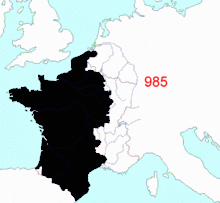
France developed from West Francia (the Kingdom of the West Franks, 843–987) formed from division of the Carolingian Empire under the Treaty of Verdun (843). From 987, France was ruled by the Capetian dynasty, beginning with Hugh Capet, Duke of France and Count of Paris. This replaced the previous Carolingian kings (936–987). The Capetian dynasty of France, until dethroned by the French First Republic, was the following:
- House of Capet (987–1328).
- Valois kings of France (1328–1589): the houses of Valois, Valois-Orléans, and Valois-Angoulême.
- House of Bourbon (1589–1792).
Burgundian State
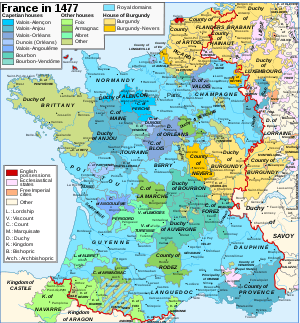
The Duke of Burgundy was an immensely powerful figure who ruled the Burgundian State (1384–1482). As well as the French Duchy of Burgundy, they would gain control of the Free County of Burgundy and the Burgundian Netherlands, as well as other lands. The Burgundian Netherlands roughly covered the present-day Low Countries (Belgium, Netherlands and Luxembourg). The dukedom had transferred from the House of Burgundy (1032–1361) to the House of Valois-Burgundy (1363–1482).
During the Armagnac–Burgundian Civil War (1407–1435), the Burgundian State would clash with the Armagnac faction. During the Lancastrian War (1415–1453) phase of the Hundred Years' War, and after the assassination of John the Fearless (1419), they formed an alliance with the English between 1420 and 1435 with the Treaty of Troyes. In 1435, Charles VII of France concluded the Treaty of Arras with Philip the Good (the Duke of Burgundy 1419–1467), ending the civil war and gaining the support of the Burgundians against the English, which helped them win the Hundred Years' War.
After Philip the Good, the dukedom passed to:
- Charles the Bold, whose death ended the Burgundian Wars (1474–1477), a conflict between the Duke of Burgundy and the Old Swiss Confederacy and its allies.
- Mary of Burgundy. Mary had married the Maximilian I, the Habsburg Holy Roman Emperor, and the War of the Burgundian Succession (1477–1482) was a war over the partition of the Burgundian lands between Louis XI of France and the House of Habsburg.
After the War of the Burgundian Succession and various treaties, territories including the Duchy of Burgundy would be lost to the French king. But the dukedom would continue with the Free County of Burgundy and the Burgundian Netherlands, passing to the Habsburgs and Habsburg Spain:
- Philip the Handsome, the first Duke of Burgundy of the House of Habsburg, who was also King Philip I of Castile.
- Charles V, Holy Roman Emperor, who was also King Charles I of Spain (Castile and Aragon).
Charles V was succeeded by Philip II of Spain, Philip III of Spain, Philip IV of Spain, and Charles II of Spain, the last Habsburg ruler of Spain. After that the dukedom was claimed by the House of Bourbon, before returning to the House of Habsburg, and then to the House of Bourbon again.
Avignon Papacy
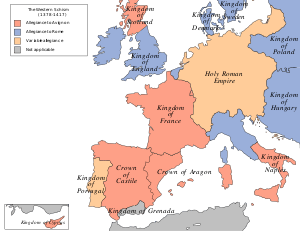
Avignon Papacy (1309–1376): was a period of during which the Popes resided in the Avignon, after manipulation by Philip IV of France. In all seven popes reigned during that period; they were all French, and heavily influenced by the French kings. During this period, the Antipope Nicholas V was crowned in Rome in 1328 at the behest of the Holy Roman Emperor Louis IV (Ludwig the Bavarian).
Western Schism
The Avignon Papacy would eventually lead to the Western Schism (1378–1417) within Roman Catholic Church. Two, even three, men simultaneously claimed to be the true pope, with loyalties divided between them; the non-Roman ones are considered as being antipopes (illegitimate popes). It happened after the death of Gregory XI in 1378, who had moved back to Rome in 1376. Difficulties with the newly-elected Pope Urban VI in Rome resulted in the establishment of rival Antipope Clement VII in Avignon, who was succeeded by Antipope Benedict XIII in 1394. There were also rival antipopes in Pisa during the period 1409 to 1415, after the controversial Council of Pisa.
The Western Schism ended with the Council of Constance (1414–1418), held just north of Switzerland. Pope Gregory XII and the Pisa-based Antipope John XXIII stepped down in 1415; and in 1417 Pope Martin V was elected. Avignon-based Antipope Benedict XIII refused to step down and was excommunicated.
Hundred Years' War
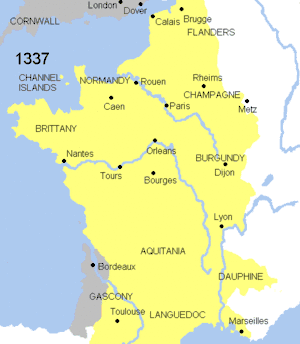
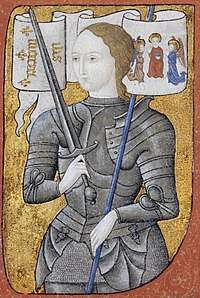
Hundred Years' War (1337–1453): was a series of wars in France, primarily between the French and the English. It was triggered by a series of disagreements between the French monarch Philip VI "the Fortunate" (who reigned 1328–1350), and the English House of Plantagenet monarch Edward III (who reigned 1327–1377). This ended in Philip VI confiscating the Duchy of Aquitaine (then essentially corresponding to Gascony) from the Duke of Aquitaine Edward III. Philip VI was the first king of the House of Valois, and succeeded Charles IV "the Fair"; this created a rival claim to the French throne of Edward III through his mother Isabella, the sister of Charles IV. The war can be divided into three phases:
Edwardian War (1337–1360)
The English were led by Edward III and his son Edward the Black Prince. With the Battle of Sluys (1340), the English gained command of the seas. The English had a great victory at the Battle of Crécy (1346); and after the Siege of Calais (1346–1347) Calais was held by the English until 1558. The French King Philip VI was succeeded by his son John II (1350), who was captured by the English at the Battle of Poitiers (1356).
With the Treaty of Brétigny (1360), Edward III renounced the French crown, but became Lord of Aquitaine (1360–1362), with Aquitaine as an independent and much enlarged territory than before the war. Conflict was extended between the English and French in the War of the Breton Succession (1341–1365), the Castilian Civil War (1351-1369), and the War of the Two Peters (1356–1375).
Caroline War (1369–1389)
When the French King John II died in captivity in 1364, his son, Dauphin Charles, succeeded him as Charles V "the Wise"; he again claimed Aquitaine in 1369 from Edward the Black Prince, the son of Edward III and Prince of Aquitaine (1362–1372). The French had a capable general in Bertrand du Guesclin. The war was mostly characterized by a Fabian strategy by the French, avoiding open conflict and concentrating on skirmishes, although there was a series of battles. English command of the seas ended at the Battle of La Rochelle (1372). Conflict during this period included Despenser's Crusade (1382–1383), and the warfare during the 1383–1385 Portuguese interregnum crisis.
The French King Charles VI "the Beloved" (the son of Charles V) and the English King Richard II (the son of Edward the Black Prince) would agree the Truce of Leulinghem in 1389, with English-held lands in France much reduced.
Lancastrian War (1415–1453)
The English House of Lancaster King Henry V succeeded Henry IV in 1413, and reasserted the claim to the French throne of Edward III; Henry V would have a great victory against the French at the Battle of Agincourt (1415). In 1419, Rouen and Normandy fell to Henry V, and Henry V formed an alliance with Burgundy. In 1420, Henry V and Charles VI signed the Treaty of Troyes, that Henry V would marry Catherine of Valois (daughter of Charles VI of France), and that their heir would inherit both kingdoms, and that the Dauphin (the son of Charles VI) was disinherited.
In 1422 Henry V of England and Charles VI of France both died, creating rival claimants to the French throne:
- Henry VI, the nine-month-old son of Henry V, who was crowned king of France in 1431.
- Charles VII "the Victorious", the 19-year-old Dauphin (prince) and son of Charles VI. Charles VII would eventually be victorious over Henry VI.
At the Siege of Orléans (1428–1429), which was held by the French, Joan of Arc rallied the French troops, and the seige was lifted nine day later. Soon after a series of French victories, including the decisive Battle of Patay (1429), and the crowning of the Charles VII at Reims Cathedral (1429), further boosted the French. However Charles the Victorious and Joan of Arc were unsuccessful at the Siege of Paris (September 1429), which was held by the English; and subsequently Joan of Arc was captured by the Burgundians (March 1430), and then executed by the English (May 1431).
The resolution of the Armagnac–Burgundian Civil War (1407–1435) gave Charles VII the support of the Burgundians. The French had major victories at the Battle of Formigny (1450) and Battle of Castillon (1453), resulting in the loss of all English territories in France by 1453, with the exception of the Pale of Calais.
War of the Roses
.jpg)
After the reign of English King Richard II (1377–1399), the Plantagenets would divide into two cadet branches; the House of Lancaster and the House of York. The House of Lancaster would rule first, with the reigns of Henry IV; and then his son Henry V; and then his son Henry VI. Henry VI's early reign was overseen by a Regency government (1422–1437). When Henry VI finally became ruler, his ineffective rule and mental instability contributed to the the loss of the Hundred Years' War (1453); and in England, a collapse of law and order. Henry VI's wife Margaret of Anjou became the de facto ruler. Henry VI's cousin, Richard of York (the 3rd Duke of York), began to oppose him and his wife's clique.
Wars of the Roses (1455–1487): began when civil war broke out between supporters of the the House of Lancaster and the House of York:
- The House of Lancaster, symbolised by the Red Rose of Lancaster, supported the continuing reign of Henry VI.
- The House of York, symbolised by the White Rose of York, supported Richard of York; and after Richard's death in 1460, his son Edward, who would later reign as Edward IV.
After a series of Yorkist victories, Edward IV became king between 1461–1470. But in 1469, the Earl of Warwick threw his support behind Henry VI; a series of battles ended with Edward IV fleeing to Flanders in 1470, and the restoration of Henry VI's reign. But at the Battle of Tewkesbury (1471), Henry VI's forces were again defeated by Edward IV, who then returned to London unopposed to resume his reign; with Henry VI, and his son Edward, Prince of Wales, dead.
Edward IV would reign for a further 12 years, before dying in 1483. He was succeeded by his 12-year-old son Edward V, who reigned for 78 days, but was never crowned. Edward V and his brother Richard were kept in the Tower of London, and they were later called the Princes in the Tower. Their fate is uncertain, but they were probably murdered by their uncle, who then reigned as Richard III (1483–1485). Richard III would later be defeated and killed at the Battle of Bosworth Field (1485), by Henry Tudor, who would reign as Henry VII (1485–1509). This ended the Plantagenet dynasty, and began the Tudor dynasty. Henry VII was distantly related to John of Gaunt, Duke of Lancaster, through his mother; and he married Elizabeth of York, the daughter of Edward IV; his emblem, the Tudor rose, combined the red and white roses of Lancaster and York. The War of the Roses ended in 1487 with defeat of the Yorkist rebel John de la Pole, 1st Earl of Lincoln.
Holy Roman Empire and Hanseatic League
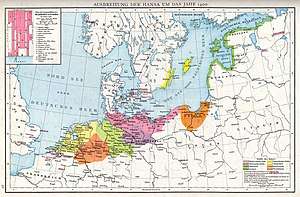
Rulers of states of the Holy Roman Empire around 1300 included the Houses of Wittelsbach, Luxembourg and Habsburg.
- The House of Wittelsbach lands included Bavaria (including the Upper Palatinate), Palatinate, Hainaut, Seeland, Holland and Friesland.
- The House of Luxembourg lands included Luxembourg, Bohemia (including Moravia and Silesia), Brabant and Brandenburg.
- The House of Habsburg lands included Inner Austria (Duchy of Austria, Styria, Carinthia and Carniola), Tyrol and Further Austria (Sundgau and Breisgau).
Hanseatic League (from 1358) was a league of guilds and market towns of Germanic origins, mostly south of the North Sea and Baltic Sea. The Hansa were a trade league, who were also committed to the mutual defense of the members, forming a political-economic alliance. Note that "Hanseatic" is the adjective for the noun Hansa, but also the adjective for hanse (historical for a merchant guild).
They consisted of:
- Hansa Proper: Hanseatic cities in territories divided into quarters. The quarters were the Wendish (Wendish and Pomeranian); Saxon (Saxon, Thuringian and Brandenburg); Baltic (Prussian, Livonian and Swedish); and Westphalian (Rhine-Westphalian and Netherlands, including Flanders).
- Kontore: Hanseatic foreign commercial enclaves, forming the Kontor quarter. Kontore is plural of kontor, literally "branch office". Spread throughout Europe, they were not Hanseatic members, but closely related to Hansa.
- Other ports with Hanseatic trading posts, and cities with a Hanseatic communities.
They would dominate trade in Northern Europe for the next three centuries, before gradually falling apart by the late 17th century. They were an early example of a trade bloc, and these would gradually become to dominate world trade; an example being the European Economic Community of the 20th century, that would become the present-day European Union.
Rise of Muscovy
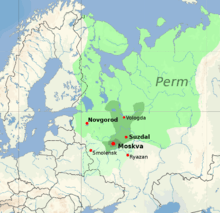
Kievan Rus' (882–1240): was an early progenitor to Russia. A loose federation of East Slavic and Finnic peoples, it was founded by the Rus' people, who are thought to be Varangians (Vikings). It was composed of a number of principalities and other territories; the city of Kiev was the nucleus of the state, and it was ruled by the Grand Prince of Kiev. Vladimir the Great was a Prince of Novgorod who became Grand Prince of Kiev 980–1015; he consolidated the realm, and converted to Christianity in 988. Roman the Great (Roman Mstislavich) was another Prince of Novgorod and Grand Prince of Kiev 1170–1205, and had victories against Cumania (also known as the Cuman-Kipchak Confederation), a large Turkic confederation south-east of the Rus'.
Kievan Rus' began to disintegrate in the 11th century; it ended after falling to the Mongols circa 1240s, and its principalities became vassals to the Golden Horde by 1294, a north western division of the Mongol Empire. Their rulers were Mongols, and later on Tatars. Mongols originated from Mongolia, and spoke the Mongolian language. Tatars was a general term used by Russians and other Europeans for Turkic peoples of the Golden Horde, but can be used more specifically for the speakers of the Tatar language. According to the Turco-Mongol tradition, they assimilated control of the Golden Horde, and took up the Kipchak language as a common tongue, which survives as the root of some Turkic languages such as Kazakh and Tatar.
Grand Duchy of Moscow (1283–1547), also known as Muscovy, was a Rus' principality and a successor state to Vladimir-Suzdal. Ivan the Great (Ivan III Vasilyevich), reigned 1462–1505; he tripled the territory, annexing the Novgorod Republic in 1478 and the Grand Duchy of Tver in 1485. After marrying Sophia Palaiologina (1472), the niece of the last Byzantine emperor, he claimed Muscovy to be a successor state to the Roman Empire, or the "Third Rome" (the first and second being ancient Rome and Constantinople); and adopted the title of tsar. With victory over the Golden Horde at the Great Stand on the Ugra River (1480), he cast off the "Tatar Yoke" and ended their status as a tributary vassal of the Golden Horde. In 1547 it was followed by the Tsardom of Russia under Ivan the Terrible.
Rise of the Ottoman Empire
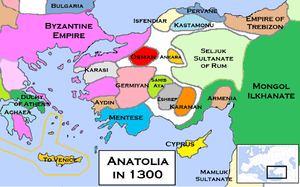
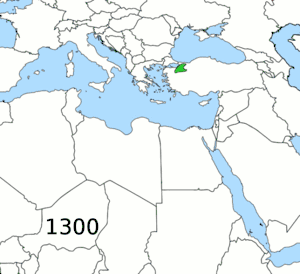
Ottoman Empire (1299–1922) and Caliphate (1517–1924): was an empire ruled by Turkish Sunni sultans of the House of Osman; later on they became caliphs (that is, stewards seen as successors to Muhammad). The Ottoman Empire was founded by Osman I (who ruled circa 1299‒1323/4) as an Anatolian Beylik; his father Ertuğrul had ruled the town of Söğüt. The Ottoman Turks were the Turkish-speaking people of the Ottoman Empire. The Grand Vizier, the senior minister of the sultans, became powerful figures with time.
Rise of the Ottoman Empire (1299–1453): was the period from the establishment of the state to the Fall of Constantinople. In the early 14th century Anatolia the declining Seljuk Sultanate of Rum was mostly divided into independent Turkish principalities known as the Anatolian Beyliks. In addition there was also the Greek Byzantines and Empire of Trebizond, the Armenian Kingdom of Cilicia, and the Mongol Ilkhanate to the east. The early conquests included much of Anatolia and the Balkans, eventually gaining the vassal states of the Danubian Principalities (Wallachia and Moldavia). As well other Turks, they fought the Byzantines in the Byzantine–Ottoman wars (1265–1479), as well as Bulgarians, Serbians, Hungarians and Albanians in the Balkans.
Fall of the Byzantine Empire: the Byzantines had been severely weakened during the sacking of Constantinople (1204), the main feature of the Fourth Crusade (1202–1204). Constantinople was finally captured by the Ottoman Turks in 1453 led by Mehmed II the Conqueror, and the Byzantine Empire was soon annexed to the Ottoman Empire. Mehmed expanded the Ottoman Empire particularly over Anatolia and the Balkans. Constantinople began to be known as Istanbul.
A period of growth followed the rise of the Ottoman Empire. It can be divided into the:
- Classical Age (1453–1566)
- Era of Transformation (1566–1703)
At its height In 1683, the Ottoman Empire and its vassals stretched over the Balkans and Anatolia, Levant, western Arabia, Egypt and northern Africa. This was followed by:
- Old Regime (1703–1789)
- Decline & Modernization (1789–1908)
- Dissolution (1908–1922)
Part 2 Modern period
.jpg)
The modern period was after the Middle Ages, circa 1500. Can also be seen as starting at the Fall of Constantinople (1453), or the discovery of the New World (1492). Can be divided into:
- Early modern period was circa 1500–1750 AD; it can also be seen as starting at 1453 or 1492 (see above); and ending at the French Revolution (1789), or at 1800. The early modern period was characterized by the ascendancy of Russia, which curtailed the expansion of Sweden after the Great Northern War. Within and outside of the Holy Roman Empire, Brandenburg (which would become Prussia) and Austria (ruled by the House of Habsburg) would dominate geopolitics. The House of Habsburg would have important wars against the Ottoman Empire, and the French in Italy; they would also gain the Spanish crowns. In France, the House of Bourbon would ascend to the throne, and later on would gain the Spanish crowns from the Habsburgs. With the Reformation, Protestants would break with the Catholic Church, leading to the European wars of religion. It was also the Age of Discovery, and vast colonial empires ruled by European countries would result. Philosophy, the arts, science and technology would greatly develop during this period, especially with The Renaissance and Age of Enlightenment.
- Late modern period was circa 1750–1945, or 1800–1945. It was characterised with three periods of intense conflict, surrounded by periods of relative peace: the French Revolutionary Wars and Napoleonic Wars (1792–1815); World War I (1914–1918); and World War II (1939–1945). The Age of Revolution would see many revolutionary movements, and was especially notable for the American Revolution and the French Revolution. It was also a time of European unification, with the formation of the German Empire, and the Risorgimento (Italian unification). Imperialism continued, especially with Scramble for Africa; but the Ottoman Empire would decline during this period, and with the Spanish American wars of independence and other decolonisation, most empires would eventually be lost. The Industrial Revolutions resulted in huge increases in mechanisation and industry.
- Contemporary period was from circa 1945 (post World War II) to the present time. It was characterised by the Cold War, in which much of the World would be divided in two groups, largely divided by communist and capitalist ideologies; a flurry of proxy wars occurred between the two dominant superpowers, the USA and the Soviet Union. With the fall of communism, this stalemate would mostly be ended, and the risk of full-blown nuclear conflict largely averted. Decolonisation gained traction during this period, with most territories of colonial empires made independent by 1975. With the European Economic Community and European Union, Europe would enter an era of free trade and movements of many Europeans, with some degree of political union. Huge technological developments occurred, particularly in computing and communications.
See also Wikipedia:Modern history.
Chapter 4 Early modern period
The early modern period was circa 1500–1750 AD, or ending at the French Revolution (1789), or at 1800.
See also: Wikipedia:Early modern period
States and territories of the early modern period
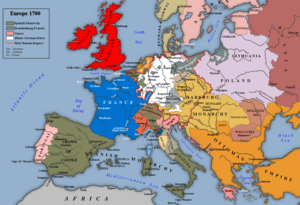
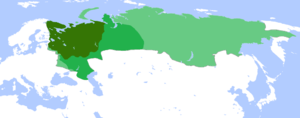
States and territories of the early modern period included:
- Northern Europe
- The Kingdom of England (which included Wales from 1284) would later become the Kingdom of Great Britain (1707–1800) by including the Kingdom of Scotland; the Kingdom of Ireland (1542–1801) was a client state of the British. The end of the Kalmar Union (1397–1523) led to two states: Denmark–Norway (1523–1533 & 1537–1814); and the Swedish Empire (1611–1721), which included Finland.
- Western and Central Europe
- Included France; and the Holy Roman Empire, with lands of Brandenburg-Prussia and the lands of the Austrian Monarchy. The Habsburg Netherlands (1482–1794) would become the Seventeen Provinces (1549–1581), covering the Low Countries. The Seventeen Provinces gave rise to the Dutch Republic, an independent state from 1581–1795; and the Southern Netherlands (until 1794). The Old Swiss Confederacy (c. 1300 – 1798) gained de facto independence from the Holy Roman Empire after the Swabian War (1499), where it fought against them and the Swabian League; it formally gained independence after the Thirty Years' War (1648).
- Eastern Europe
- The Grand Duchy of Lithuania created a bi-confederation with the Kingdom of Poland to create the Polish–Lithuanian Commonwealth (1569–1795). The Terra Mariana (of present day Estonia and Latvia between 1207–1561) collapsed into separate states. The Duchy of Prussia (1525–1701) was a Protestant secularization of the earlier Teutonic State. The Balkans were dominated by the Ottoman Empire, with vassals such as Wallachia and Moldavia; there were also the Habsburg lands of the Hungarian crown, Venetian possessions and the Prince-Bishopric of Montenegro (1516–1852). Further east was the Tsardom of Russia/Russian Empire (1547–1721 & 1721–1917).
- Iberian Penisinula
- The Spanish Empire included present day Spain (Castile and Aragon); but extended over Europe, including much of Italy and the Habsburg Netherlands. Possessions in Italy and the Netherlands were lost during the War of the Spanish Succession (1701–1714). It would also include Portugal during the Iberian Union (1580-1640).
- Italian Peninsula
- Included the Papal States and Venice. Other northern Italian states were nominally within the Holy Roman Empire, but many Italian city-states had de facto independence: important ones (in the 16th century) included Genoa, Florence, and Savoy; the Duchy of Milan became part of the Spanish Empire, as well as the southern states of Naples, Sicily, and Sardinia. Lesser northern Italian states at that time included Siena, Modena, Ferrara, Lucca, Montferrat, Saluzzo, Asti, and Mantua.
Russia, Sweden, and Poland
Russian Tsardom and Empire
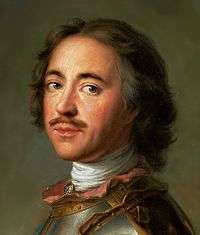
_-_Nationalmuseum_-_15939.tif.jpg)
Tsardom of Russia (1547–1721) became a new name for Muscovy, also known as the Grand Duchy of Moscow. Ivan the Terrible (Ivan IV Vasilyevich) the grandson of Ivan III, was declared "Tsar of All Rus'" (1547–1584), after ruling as Grand Prince of Moscow (1533–1547). Ivan the Terrible conquered the Khanate of Kazan, Astrakhan, and Sibirean khanates. Later on, the rest of Siberia would fall to the Russians, and by the mid-17th century Russia had expanded to the Pacific Ocean.
The Rurik dynasty were rulers of Kievan Rus' (after 882), as well as the successor principalities of Galicia-Volhynia (after 1199), Chernigov, Vladimir-Suzdal, and the Grand Duchy of Moscow; they also ruled the Tsardom of Russia. The Time of Troubles was between the death of Feodor I in 1598 and the accession of Michael I in 1613; during this time the Russian famine of 1601–1603 devastated Russia. Vasili IV was tsar between 1606 and 1610, but this was disputed, and there was numerous other usurpers and imposters. After the Time of Troubles, the House of Romanov ruled Russia, beginning with Michael I, and ending with Nicholas II, the last tsar of Russia who was deposed in 1917. By the 18th century, many Cossacks (an East-Slavic people) had been transformed into a special military estate of Russia.
Russian Empire (1721–1917): was declared by Peter the Great (Peter I), who reigned 1682–1725; as well as being emperor he retained the title of tsar. Peter the Great moved the capital to St. Petersburg in 1712, which remained there until 1917; he also won the Great Northern War in 1721. The Empress Catherine the Great (Catherine II), who reigned 1762–1796, presided over a golden age, with rapid expansion of the empire, and the Russian Enlightenment with advancement particularly in the arts. Alexander Suvorov was an outstanding general for the Russians, particularly during the Russo-Turkish Wars during the late 18th century; the Russo-Turkish Wars continued from the 16th to 20th centuries.
The Russian Empire continued until the 20th century, until the Russian monarchy was deposed, and the empire was succeeded by the Russian Republic (1917). It then became the Russian SFSR (Soviet Federative Socialist Republic) (1917–1991), which became a part of the Soviet Union or USSR (1922–1991).
Sweden and the Northern Wars
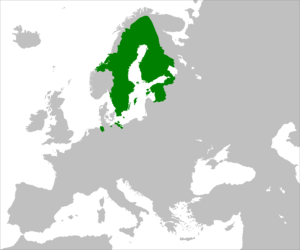
Before the Swedish Empire, Russia and Sweden had fought in two Northern Wars: the Russo-Swedish War of 1554–1557, and the Livonian War (1558–1583). After Russia was defeated, Terra Mariana (also called Old Livonia) was divided between the victors: Sweden, the Polish–Lithuanian Commonwealth, and Denmark–Norway. With the Northern Seven Years' War (1562–1570), Sweden had clashed with the Polish–Lithuanian Commonwealth and Denmark–Norway, without territorial changes.
Swedish Empire (1611–1721) was a great power in Europe and a rival to Russia in Eastern Europe. The Swedish Empire was founded by Gustavus Adolphus of Sweden (or Gustav II Adolf, who reigned 1611–1632); he led Sweden to military supremacy during the Thirty Years' War, including great victories such as the Battle of Breitenfeld (1631), before dying at the Battle of Lützen (1632).
During the Second Northern War (1655–1660), Sweden and its allies fought against many opponents; these included the Polish–Lithuanian Commonwealth, Russia (Muscovy), Brandenburg-Prussia (at times an ally), the Austrian Monarchy, and Denmark–Norway. NB that the term "First Northern War" can refer to a number of conflicts, including the Second Northern War. Major aspects included:
- Russo-Swedish War of 1656–1658, without territorial changes.
- Dano-Swedish Wars of 1657–1658 and 1658–1660, with territorial changes between Denmark–Norway and Sweden.
- Russo-Polish War of 1654–1667, also called the Thirteen Years' War, coincided with the Second Northern War to some extent; it ended with significant Russian territorial gains from the Polish–Lithuanian Commonwealth.
- The Swedish-Russian Deluge (Potop szwedzko-rosyjski) was the occupation of the Polish–Lithuanian Commonwealth during these wars, mainly by Sweden, Russia (Muscovy), Brandenburg-Prussia, and Khmelnytsky's Cossacks; it caused widespread destruction and looting, and a huge loss of life.
Sweden mostly gained territories as a result of this war. With the Scanian War (1674–1679), also called "Swedish-Brandenburgian War", Sweden ceded some Pomeranian areas to Brandenburg-Prussia.
Great Northern War (1700–1721) had a Russian coalition fighting against a Swedish coalition, for supremacy in Northern Europe. It began when Russia, Denmark–Norway, Saxony, and the Polish–Lithuanian Commonwealth sensed an opportunity and declared war on the Sweden, then ruled by the young Charles XII. The Caroleans (the soldiers of the Swedish kings Charles XI and Charles XII) had some great victories against Russia and other countries during this period, in many cases defeating far larger armies. But eventually there was victory by the Russian coalition; Russia, Prussia, Denmark-Norway, and other states would gain territories.
After the Great Northern War, both Sweden and the Polish–Lithuanian Commonwealth would decline, while Russia and Prussia would continue to rise. In 1809 eastern Sweden would be lost to Russia, which became the highly autonomous Grand Principality of Finland. During the Napoleonic Wars, Sweden allied itself with France; and after the Battle of Leipzig (1813), and a military campaign, the Swedish King Charles XIII managed to force Denmark–Norway, an ally of France, to cede Norway, in exchange for northern German provinces; Sweden–Norway lasted from 1814 to 1905. The 1814 campaign was the last time Sweden was at war.
Polish–Lithuanian Commonwealth
The Kingdom of Poland created a bi-confederation with the Grand Duchy of Lithuania to create the Polish–Lithuanian Commonwealth (1569–1795). During this period the King of Poland would also be the Grand Duke of Lithuania, although this personal union had existed since 1386. The "Golden Liberty" meant that the king was elected, and that the nobles held considerable power. The Poles were mostly West-Slavic, and the Lithuanians were mostly Balts.
During the Polish–Muscovite War (1605–1618), the Poles occupied Moscow between 1610 and 1612. During the Swedish-Russian Deluge (1648–1667), approximately one third of its population was lost, as well as its status as a great power, due to invasions by Sweden and Russia. The Polish King John III Sobieski allied with Holy Roman Emperor Leopold I; in 1683, at the Battle of Vienna, they defeated the Ottomans Empire, marking a turning point in the Ottoman–Habsburg Wars and Polish–Ottoman Wars.
After the Great Northern War, the Commonwealth would further decline, becoming a protectorate of the Russian Empire in 1768. The Partitions of Poland (1772–1795) was the partition of the Polish–Lithuanian Commonwealth between Russia, Prussia, and the Austrian Monarchy; it was instigated by Catherine the Great of Russia, Frederick the Great of Prussia, and Joseph II, Holy Roman Emperor. Poland would cease to be, until resurrected by Napoleon as the Duchy of Warsaw in 1807; after a tumultuous history it finally became the present-day Third Polish Republic, established 1989–1991. Lithuania would not become finally independent of Russia until 1990.
Decline of the Holy Roman Empire
.svg.png)
In 1500 and 1512, within the Holy Roman Empire, Imperial Circles where created. These included Bavarian, Franconian, Upper and Lower Saxon, Swabian, Upper Rhenish, Lower Rhenish–Westphalian, Austrian, Burgundian, and Electoral Rhenish Circles. Outside the Imperial Circles were the lands of the Bohemian Crown (included Silesia), the Old Swiss Confederacy (1291–1798), as well as the Italian territories.
Imperial Circles consisted of Imperial Estates, ruled by Imperial Princes. The Imperial Diet, the highest representative assembly, consisted of three colleges: an Electoral College of seven Prince-electors, who elected the emperor; a college of Imperial Princes; and a college of Free and Imperial Cities. Charles V was the last Holy Roman Emperor to be crowned by a pope, Pope Clement VII in 1530.
Since the 13th century the Holy Roman Emperor had began to lose power and territory. Gradually, the Holy Roman Emperor's power became largely nominal, with real power going to the rulers of the highly autonomous Imperial Estates; they held "immediacy", meaning that they were answerable only to the emperor. Two major power-bases within the Holy Roman Empire grew in influence:
- Brandenburg (as a Margraviate or Province, 1157–1945): which would provide the basis for Brandenburg-Prussia and the Kingdom of Prussia. Prussia would de facto lead the North German Confederation of 1867, which gained a new constitution as the German Empire in 1871, under the permanent presidency of Prussia.
- Austria (as a Duchy or Archduchy, 1156–1918): which would provide the basis of the Austrian Monarchy, which would later become the Austrian Empire and Austria-Hungary. After 1440, the Austrian monarch usually held the office of Holy Roman Emperor.
Both Brandenburg and Austria would gain territories both inside and outside of the Holy Roman Empire. The rest of the Holy Roman Empire power-base was split between miscellaneous states: larger ones in the early modern period included Bavaria (north was formerly Franconia), Saxony, Hanover, and Lorraine.
During the Thirty Years' War (1618–1648), religious divisions in Holy Roman Empire would further weaken it as a unified entity. The Habsburg Austrian Monarchy, which dominated the office of Holy Roman Emperor, would lose territories, although there would be territorial gains for Brandenburg-Prussia. Austria would fight against Prussia in the Silesian wars (1740–1763), and Silesia was a theater in the Seven Years' War (1756–1763). Voltaire quipped “... the Holy Roman Empire was in no way holy, nor Roman, nor an empire”, and the empire had become greatly fragmented between the semi-autonomous states by the late nineteenth century. The German mediatisation (1802–1814) reduced the number of German states from almost 300 to just 39.
The Holy Roman Empire would eventually be dissolved after the Austrian defeat by France under Napoleon in the War of the Third Coalition (1803–1806); and Prussia would be defeated by Napoleon in the War of the Fourth Coalition (1806–1807).
House of Hohenzollern

The House of Hohenzollern was a German dynasty from Hechingen in Swabia, who took their name from Hohenzollern Castle in the Swabian Alps. Most importantly, the Brandenburg-Prussian branch would rule Brandenburg-Prussia, the Kingdom of Prussia, and the German Empire
The first branch was the Swabian branch who ruled Zollern, a county in the Holy Roman Empire which from 1218 was called Hohenzollern, and whose capital became Hechingen. At first they ruled as Counts of Zollern (1061–1204) and Hohenzollern (1204–1575). They would then rule Hohenzollern-Haigerloch, Hohenzollern-Hechingen, and Hohenzollern-Sigmaringen during the period of 1576 to 1849. After 1849 to the present day they continued as Heads of the Princely House of Hohenzollern.
Other than the Swabian branch, other ruling branches were:
- Brandenburg-Prussian branch, which included the Electors and Margraves of Brandenburg, 1415 to 1806. They also included the rulers of Prussia (1525–1918), and the German Emperors (1871–1918): these were the Dukes of Prussia (1525–1701), the Kings in Prussia (1701–1772), and the Kings of Prussia (1772–1918). They also included Margraves of Brandenburg-Küstrin, and Brandenburg-Schwedt.
- Franconian branch, which included some Burgraves of Nuremberg; Margraves of Brandenburg-Kulmbach, Brandenburg-Ansbach, and Brandenburg-Bayreuth; and Dukes of Jägerndorf.
- Kings of the Romanians (1866–1947), of the Kingdom of Romania (1881–1947).
Brandenburg-Prussia and Frederick the Great
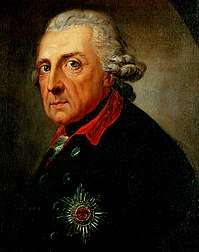
Brandenburg-Prussia (1618–1701): was formed from territories that initially included, within the Holy Roman Empire, the Margraviate of Brandenburg, the Duchy of Cleves, and the counties of Ravensberg and Ravenstein. Outside of the Holy Roman Empire it initially included the Duchy of Prussia. It would later considerably expand its territories, both inside and outside the Holy Roman Empire. Prussia had developed from the State of the Teutonic Order, a state founded after the Teutonic Knights had conquered the lands of the Old Prussians (who were pagan Balts), after the Prussian Crusade of 1217–1274 (one of the Northern Crusades). It then became the Duchy of Prussia (1525–1701), a protestant state; it then entered personal union with Brandenburg in 1618, when John Sigismund, Elector of Brandenburg, became Duke of Prussia.
Kingdom of Prussia (1701–1918) succeeded Brandenburg-Prussia, and was established after Frederick III, Elector of Brandenburg, crowned himself "King in Prussia" as Frederick I on 18 January 1701. Early kings would be styled as "King in Prussia" rather than "King of Prussia"; this continued until 1772. It would gain much territory both inside and outside of the Holy Roman Empire and successors. It would eventually form the nucleus of the German Empire (1871–1918).
Frederick the Great (or Frederick II or "The Old Fritz") ruled the Kingdom of Prussia 1740–1786; he was the first Elector of Brandenburg to claim to be "King of Prussia" in 1772, rather than "King in Prussia". He had many military successes, particularly in the Silesian Wars (of 1740–1763) where he gained Silesia (a Bohemian territory) from the Austrian Monarchy. He also acquired Polish territories during its partition. Apart from his military successes, he was seen as a leading monarch of the Enlightenment.
Frederick fought in three Silesian wars against Austria:
- The First Silesian War (1740–1742) and the Second Silesian War (1744–1745) were theaters of the War of the Austrian Succession (1740–1748), in which Prussia fought against Austria and its allies. This led to the annexation of Silesia from the Habsburgs.
- The Third Silesian War (1756–1763) was a theater of the Seven Years' War (1756–1763), where Prussia was part of the Great Britain coalition, and was opposed by Saxony (who he occupied), and Austria, France, Russia and Sweden. The Prussians maintained all their territories, and it was considered as the "Miracle of the House of Brandenburg".
Houses of Habsburg and Habsburg-Lorraine
.svg.png)
The House of Habsburg (or House of Austria) was a one of the most important dynastic royal houses in the history of Europe. Named after Habsburg Castle (in present-day Switzerland), they were powerful monarchs of many dominions across Europe during the Middle Ages and modern period. It was succeeded by the House of Habsburg-Lorraine (a branch of the House of Lorraine) with the extinction of the male line but the continuation of the female line.
The key monarchies for the Houses of Habsburg and Habsburg-Lorraine were the following:
- Monarchs of Austria between 1282 and 1918, as dukes, archdukes or emperors, or female equivalents. The Austrian branch gained many dominions both inside and outside of the Holy Roman Empire.
- Monarchs of Spain (Castile and Aragon) between 1516 and 1700. The Spanish branch was mostly separate from the Austrian branch, and would have a significant presence in the New World, the Netherlands (then covering the Low Countries), and Italy and its surrounding islands.
- Holy Roman Emperors for most of the period 1440 to 1806. It was an elective monarchy, and usually held by the Austrian monarch.
Austrian Monarchy
Austrian Monarchy, or Habsburg Monarchy (1282–1804), is an unofficial umbrella term for lands held in personal union with the monarchs of Austria (of the House of Hapsburg and later Habsburg-Lorraine). After 1804 it would be known as the Austrian Empire (as the Archduke of Austria also became Emperor of Austria); and then from 1867 to 1918 as Austria-Hungary (after the Austro-Hungarian Compromise of 1867). Lands would be gained from both within and outside of the Holy Roman Empire. The Austrian Monarchy would include:
- Within the Holy Roman Empire: the Hereditary Lands, which included the Archduchy of Austria (1453–1806), Inner Austria, County of Tyrol, and Further Austria. It also included the Lands of the Bohemian Crown (1526–1918), which early on included Bohemia, Moravia, Silesia, and Lusatia.
- Outside of the Holy Roman Empire: it included the Lands of the Hungarian Crown (1527–1918): Hungary, Croatia, Slavonia (after 1699), and the Principality of Transylvania (after 1711), as well as some military frontiers. N.B. that Croatia today is Croatia proper, Slavonia, Istria and Dalmatia. They also gained the Spanish Netherlands, Naples, Milan and Sardinia after the War of the Spanish Succession (1701–1714). Later on, during the Partitions of Poland (1772–1795), they gained some of the Polish–Lithuanian Commonwealth.
Holy Roman Emperors during the modern period
The House of Habsburg were Holy Roman Emperors between 1440 and 1740, beginning with Frederick III, the Peaceful. During this period the Holy Roman Emperor was also the Archduke of Austria, although Charles V was only archduke for two years. This ended in 1740 after the reign of the emperor Charles VI. The next two Holy Roman Emperors were:
- Charles VII (emperor 1742–1745) was also Elector of Bavaria, and House of Wittelsbach, and the first non-Habsburg Holy Roman Emperor for three centuries.
- Francis I and Maria Theresa (emperor and empress 1745–1765). Francis I was of the House of Lorraine; he was also Archduke of Austria through his marriage to Maria Theresa, Archduchess of Austria and daughter of the Habsburg emperor Charles VI.
The uncertainty over the Austrian succession through the female-lineage of Maria Theresa led to the War of the Austrian Succession (1740–1748). The last three Holy Roman Emperors were House of Habsburg-Lorraine and archdukes of Austria:
- Joseph II (emperor 1765–1790) was the son of Francis I, and the brother of Marie Antoinette (who would marry the King of France Louis XVI). He was a leading proponent of enlightened absolutism, and a supporter of the arts, such as the composers Wolfgang Amadeus Mozart and Antonio Salieri.
- Leopold II (emperor 1790–1792) briefly succeeded his brother Joseph II.
- Francis II (emperor 1792–1806) was the son of Leopold II, and the last Holy Roman Emperor. He proclaimed himself Emperor of Austria in 1804, and later archdukes of Austria would also be emperors of Austria.
After the dissolution of the Holy Roman Empire in 1806, the House of Habsburg-Lorraine, as both emperors and archdukes of Austria, would rule the the Austrian Empire and Austria-Hungary. This ended in 1918 when Austria-Hungary declared itself to be the Republic of German-Austria, which became the First Austrian Republic in 1919, a much reduced state in terms of territory.
Ottoman–Habsburg wars and Suleiman the Magnificent
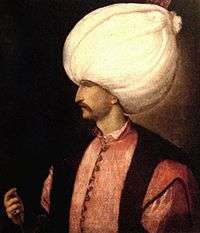

Ottoman–Habsburg wars (1526–1791) began with the Ottoman victory at the Battle of Mohács (1526); Suleiman the Magnificent, Sultan of the Ottoman Empire, defeated Louis II of Hungary, King of Hungary, Croatia and Bohemia, who died soon after. This ended the Ottoman–Hungarian wars, and would eventually result in the partition of Hungary between:
- Royal Hungary (1526–1867), the Kingdom of Hungary of the Habsburg Monarchy, first ruled by Ferdinand I, Holy Roman Emperor
- Eastern Hungarian Kingdom (1526–1551 and 1556–1570), which would become the semi-independent Principality of Transylvania (1570–1711)
- Ottoman Hungary (1541–1699), of the Ottoman Empire, after the seizure of Buda by the Ottomans in 1541
It also marked the beginnings of the Ottoman–Habsburg wars, a 250-year struggle between the Habsburgs and the Ottoman Empire for European territories. It also marked the end of Hungary as an independent territory until the 20th century.
Suleiman the Magnificent was the Ottoman Sultan 1520 to 1566. He conquered the Christian strongholds of Belgrade (1521) and Rhodes (1522); but after the Battle of Mohács, he was curtailed by the Austrians at the unsuccessful Siege of Vienna of 1529. He finally captured and occupied Buda (the Hungarian capital) following a siege in 1541. He also fought with the French against the Habsburgs in the Italian Wars. With the successful Ottoman–Safavid War (1532–1555) he gained territories from the Iranian Safavid dynasty; he also expanded the North African territories. His reign ended the Classical Age of the Ottoman Empire (1453–1566), characterized by a large expansion of territories.
Great Turkish War (1683–1699): was a campaign in the Ottoman–Habsburg wars that followed a period of peace after the Long Turkish War (1593–1606). At the Battle of Vienna (1683), the Ottomans were defeated after a two month siege of the city. John III Sobieski, the King of the Poland, helped the Austrians in the battle, along with a Holy Roman Empire army; the Winged Hussars, an elite Polish cavalry, delivered a final deadly blow. The Holy League of 1684–1699 that formed afterwards eventually ended the Great Turkish War; with the Treaty of Karlowitz (1699) most of Hungary, and Slavonia, were gained by the Habsburgs. Transylvania fell to the Habsburgs in 1711.
The Great Turkish War was followed by the Austro-Turkish War (1716–1718), Russo-Turkish War (1735–1739), and Austro-Turkish War (1788–91). The Ottoman–Habsburg wars ended Ottomans expansion into Europe.
Habsburg Spain
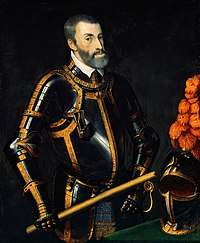
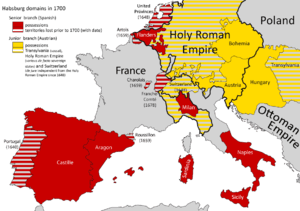
Habsburg Spain (1516–1700) began with Charles V, Holy Roman Emperor 1519–1556. His other titles included:
- King of Spain (Castile and Aragon, 1516–1556) as Carlos I (Charles I of Spain)
- Archduke of Austria, but only between 1519 and 1521
- Duke of Burgundy (1506–1555), and therefore Lord of the Netherlands
- By being Holy Roman Emperor he also had the titles King of Germany, and King of Italy (the last Holy Roman Emperor to claim the title)
The Crown of Aragon consisted of Aragon, Catalonia, Valencia, Naples, Sicily and Sardinia. Aragon had previously controlled Milan, and this was recaptured by Charles V, and later recognised by the French in 1559. The Crown of Castile would encompass a huge colonial empire. After the War of the Spanish Succession (1701–1714) Castile and Aragon would be unified. Burgundy included what would become the Seventeen Provinces (covering the present-day Low Countries), and the Free County of Burgundy (also known as Franche-Comté).
Charles V inherited the Spanish House of Trastámara bloodline through his mother Joanna of Castile (who was nominally a co-monarch, but was imprisoned after being pronounced insane); who had married his father Philip I of Castile (by right of his wife King of Castile for a short time before dying). But he actually succeeded his mother's parents, Queen Isabella I of Castile and King Ferdinand II of Aragon; Ferdinand II ruled Aragon as king, and Castile as Governor and Administrator after the death of Isabella. As king of both Castile and Aragon, he was the first monarch of both crowns (if you ignore his mother), with his grandparents being the first co-monarchs. Charles V was heir to Austria through his father's father Maximilian I, Holy Roman Emperor; but after two years this passed to his brother Ferdinand I. He was Duke of Burgundy through his father Philip I of Castile, who had inherited his dukedom from his mother Mary of Burgundy.
Charles V was involved in three major conflicts: the Italian Wars (with France), the Ottoman–Habsburg wars, and the Protestant Reformation (which he opposed). He also quelled some rebellions. Charles V brought about the divergence of two ruling branches of the Habsburgs:
- The junior branch of the Austrian Monarchy, with Charles being succeeded by his brother Holy Roman Emperor Ferdinand I (1556–1564), who was also Archduke of Austria after 1521, and king of Bohemia, Hungary and Croatia.
- The senior branch of Habsburg Spain (1516–1700), with Charles being succeeded by his son Philip II of Spain.
Philip II of Spain: was King of Spain (1556–98), Duke of Burgundy, King of Portugal (1581–1598), and King of England and Ireland (during his marriage to Queen Mary). In Europe, Philip's empire included the Spanish Netherlands, and the Italian states of Naples, Sicily, Milan and Sardinia. He also had hegemony over all of Italy, with only Savoy and Venice having true independence. His colonial empire included, most importantly, the Viceroyalty of New Spain, which included the Spanish East Indies, Spanish West Indies, and a substantial portion of North and Central America; South America included the Viceroyalties of New Granada, Peru and Rio de la Plata. In 1714, long after his reign, the Spanish Netherlands, Naples, Milan and Sardinia were ceded to Austria, and Sicily was ceded to Savoy.
Philip II presided over the start of the Spanish Golden Age (1556–1659), a period of flourishing in arts and literature in Spain. Philip financed the Holy League, who would have a great naval victory against the Ottomans at the Battle of Lepanto in 1571. During his reign the Iberian Union (1580-1640) temporarily united Portugal and Spain, which would last until the Portuguese Restoration War (1640–1668). He sent the Spanish Armada to invade Protestant England in 1588, which ended in failure; several state bankruptcies also occurred during his reign.
Philip II was succeeded by Philip III of Spain, Philip IV of Spain, and Charles II of Spain, the last Habsburg ruler of Spain.
Italian Wars and Eighty Years' War
Italian Wars (also called the Habsburg–Valois Wars, 1494–1559): were principally the Habsburgs against the French Valois kings for Italian possessions, principally the Duchy of Milan and the Kingdom of Naples. It stemmed from the claim to the Kingdom of Naples of Charles VIII of France, with the death of Ferdinand I of Naples.
The leaders for the Habsburgs were the Holy Roman Emperors Maximilian, Charles V and Ferdinand I; and King Philip II of Spain; their supporters included Henry VIII of England and Mary I of England. The French Valois kings opposing them were Charles VIII, Louis XII, Francis I, and Henry II; their supporters included Suleiman the Magnificent. Various Italian states supported the factions. The wars began with Charles VIII's Italian War (1494–1498), Louis XII's Italian War (1499–1504), the War of the League of Cambrai (1508–1516), the War of Urbino (1517), and the Four Years' War (1521–1526). During the War of the League of Cognac (1526–1530), the Sack of Rome (1527) was by mutinous troops of Charles V, Holy Roman Emperor. It was followed the Italian War of 1536–1538, the Italian War of 1542–1546, and the Last Italian War (1551–1559).
The Italian Wars were largely unsuccessful for the French. The Peace of Cateau-Cambrésis (1559) ended the Italian Wars, and was between France, Spain, England, and the Holy Roman Empire. In the treaty the French recognized Philip II as heir to Milan, Naples, Sicily and Sardinia, among other agreements.
Eighty Years' War, or the Dutch War of Independence (1568–1648): resulted in the Dutch Republic gaining independence from Spain. The Southern Netherlands (of roughly modern day Belgium and Luxembourg) remained under Spanish rule; it later became the Austrian Netherlands (1714–1794) until annexed by the French.
House of Bourbon and France
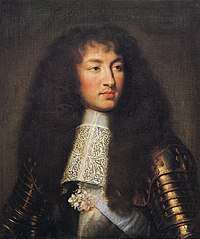
The House of Bourbon was a branch of the Capetian dynasty; it succeeded the House of Capet (987–1328) and Valois kings (1328–1589) as French monarchs. Branches would also become Spanish monarchs (see below), and Grand Dukes of Luxembourg (1964–present), as well as holding many other titles.
Henry IV, the Great (1589–1610) was the first Bourbon monarch, who ascended during the turmoil surrounding the French Wars of Religion. He was succeeded by Louis XIII, Louis XIV, Louis XV, and Louis XVI. Louis XVI was deposed in 1792 by the Great French Revolution (1789–1799). The Bourbons were later restored 1815–1830, with Louis XVIII and Charles X; and Louis-Philippe I (of the House of Orléans cadet branch) ruled 1830–1848. Cardinal Richelieu, King Louis XIII's chief minister between 1624–1642, helped transform France into a modern state.
Louis XIV (the Great or the Sun King) ruled France between 1643–1715. An absolute monarch, he greatly expanded the Palace of Versailles, and revoked the Edict of Nantes (leading to persecution of Protestants). Louis fought the Habsburgs and Dutch in the Franco-Dutch War (1672–1678), which resulted in some territorial gains for France. Louis also fought the Grand Alliance (of the Habsburgs, English and Dutch) in the Nine Years' War (1688–97), which resulted in some territorial changes. He also fought in the War of the Spanish Succession (see below).
Second Hundred Years' War: the French had a great rivalry with the British during this period, mirroring that of the Habsburgs. As well as the Nine Years' War and War of the Spanish Succession, they also fought the British in the War of the Austrian Succession (1742–1748), Father Le Loutre's War (1749–1755), 2nd Carnatic War (1749–1754), Seven Years' War (1756–1763) and Anglo-French War (1778–1783). These wars, along with later wars after the fall of the Bourbons, the French Revolutionary Wars (1792–1802) and Napoleonic Wars (1803–1815), are sometimes considered to be the Second Hundred Years' War. With the Diplomatic Revolution of 1756, Louis XVI and Marie Antoinette married, and Austria went from an ally of Britain to an ally of France, while Prussia became an ally of Britain.
Bourbon Spain
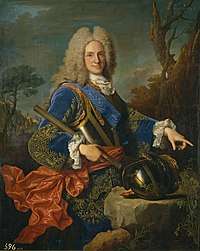
Bourbon Spain: from 1700, members of the House of Bourbon dynasty ruled Spain, beginning with Philip of Anjou, who would rule as Philip V of Spain; the Spanish Empire included territories in the New World and Europe. The Bourbons would be Spanish monarchs for much of its subsequent history, continuing to the present-day.
War of the Spanish Succession (1701–1714) had France (under Louis XIV) and their allies fighting the Grand Alliance, which included Austria, England and the Dutch Republic. The war was precipitated by the Habsburg ruler Carlos II of Spain (or Charles II) dying childless, and naming his successor as Philip of Anjou (later Philip V), the Bourbon grandson of Louis XIV and Carlos's half-sister Maria Theresa of Spain. The caused consternation for the Habsburgs, and the risk of a France–Spain superstate if both monarchies fell to a single ruler; therefore the Habsburg Holy Roman Emperor Charles VI claimed the throne. The Battle of Blenheim (1704) was a notable victory for the Grand Alliance. The war confirmed the Bourbon rule of Spain over the previous Habsburg monarchs; but Philip V had to renounce his place in the French succession; he also lost the Spanish Netherlands, Naples, Milan and Sardinia to Austria, and Sicily to Savoy.
The Spanish Bourbons were allies with the French Bourbons for some of their wars against the British: the War of the Spanish Succession, the War of the Austrian Succession, the Seven Years' War, and the Anglo-French War. But during the War of the Quadruple Alliance (1718-1720) France fought against Spain (and Great Britain, the Holy Roman Empire, and the Dutch Republic).
Reformation and religious turmoil
Protestant Reformation and earlier movements
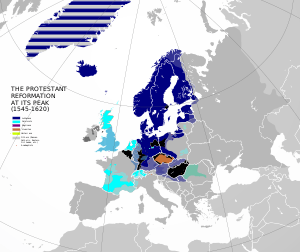
_-_Portr%C3%A4t_des_Martin_Luther_(Deutsches_Historisches_Museum).jpg)
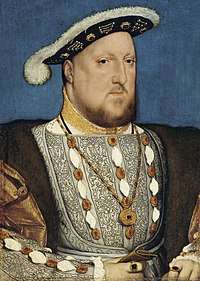
The Protestant Reformation was the establishment of Protestantism by in a 16th-century western Europe, whose religion was dominated by the Roman Catholic Church. The Protestant Reformation began in 1517, at Wittenberg, Saxony, when Martin Luther sent his Ninety-Five Theses to the Archbishop of Mainz; these protested against the sale of plenary indulgences by the clergy.
This was not the first time that the Catholic religion had been challenged. For example, in the High Middle Ages the Cathars of southern France had broken with Catholic doctrine; this led to the Albigensian Crusade (1209–1229) and genocide of the Cathars.
Proto-Protestantism were similar movements that influenced the Protestant Reformation, and included:
- Hussites, a Christian movement of the pre-Protestant Bohemian Reformation who followed Jan Hus. They had established the Hussite religion in Bohemia after the Hussite Wars (1419–1434); this lasted for two centuries until their suppression after the Bohemian Revolt (1618–1620) of the Thirty Years' War.
- Waldensians. Founded in the 1170s by Peter Waldo, they would come to influence Anabaptism in particular.
- Lollards. Founded by John Wycliffe, a 14th century English theologian, they played a part in the English Reformation.
Early Protestant movements included:
- Calvinism, or the Reformed tradition, was based on the teachings of Huldrych Zwingli, John Calvin and others; they included Presbyterians, Puritans, and Huguenots. Calvinism spread to the Dutch Republic, Scotland and southern France, and to a lesser extent in Germany, Hungary and England.
- Lutheranism was based on the teachings of Martin Luther, and Lutheran chutches became dominant in the north of Germany, and especially in the Scandinavian countries.
- Anglicanism was created by Henry VIII, and became the dominant religion of England as the Church of England; it incorporated aspects from the Reformed and Lutheran churches.
- Anabaptism was an early offshoot of Protestantism, and Anabaptist churches include the Amish, Hutterites, and Mennonites fellowships.
- Unitarianism is an nontrinitarian theological movement, and Unitarian churches began in the Polish–Lithuanian Commonwealth and Transylvania.
The Peace of Augsburg (1555) of Charles V allowed rulers within the Holy Roman Empire to choose either Lutheranism or Roman Catholicism as the official confession. Calvinism was not allowed in the Holy Roman Empire until the Peace of Westphalia (1648).
English Reformation and religious tensions
English Reformation: took place during the 16th century, when Henry VIII established the Anglican faith, followed by the Dissolution of the Monasteries. The Gunpowder Plot (1605) was an attempted assassination of the Protestant King James I of England by Catholics. The English Civil Wars (1642–1646, 1648–1649, 1649–1651) were partly religious in origin, and were part of the Wars of the Three Kingdoms (of England, Ireland and Scotland) between 1639–1651.
Anti-Catholic hysteria resulted in the Popish Plot (1678–81), a fictitious Catholic conspiracy to dethrone Charles II. The Glorious Revolution (1688) resulted in the ousting of the Catholic King James II by Parliament, who was replaced by the Protestant King William III and Queen Mary II. The Jacobite risings, especially prominent in 1715 and 1745, were failed Catholic uprisings that sought to reinstate James II and his descendants, including James Francis Edward Stuart ("The Old Pretender"), and Charles Edward Stuart ("the Young Pretender" or "Bonnie Prince Charlie").
Counter-Reformation
Counter-Reformation: was a period of Catholic resurgence in response to the Reformation. It began with the 25 sessions of the Council of Trent (1545–1563), which led to reform of Church doctrines and teachings, the foundation of seminaries for the training of priests, and new religious orders such as the Jesuits. The Inquisition was used to enforce the Counter-Reformation and suppress heresy; it included the Spanish Inquisition, the Roman Inquisition, and Portuguese Inquisition.
European wars of religion
European wars of religion of the 16th, 17th and early 18th centuries, were largely a result of the religious differences stemming from reform.
The French Wars of Religion (1562–1598) were especially notable, with Roman Catholics against the Huguenots (French Protestants) following the death of Henry II of France; three millions deaths can be attributed to them. The Bartholomew's Day massacre (1572) was the massacre of between 30,000 and 100,000 Huguenots across France. Henry IV, a former Huguenot, issued the Edict of Nantes (1598) assuring conditional religious freedom. Later on, Huguenot rebellions (1621–1629) erupted after intolerance by Louis XIII. Louis XIV's Edict of Fontainebleau (1685) revoked the Edict of Nantes, and resulted in further persecution.
Other major European wars of religion include: the Thirty Years' War (see below); the War of the Three Kingdoms (1639–1651) of England, Scotland, and Ireland; the Eighty Years' War (1568–1648) resulting in independence of the Dutch Republic from Spain; and the German Peasants' War (1524–1525) of the Holy Roman Empire. There was also a rise in witch trials between 1580 and 1630; over 50,000 people, mostly women, lost their lives, and religious tensions may have been a factor.
Thirty Years' War
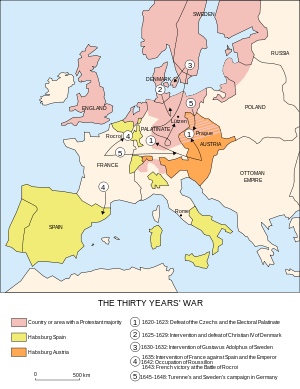
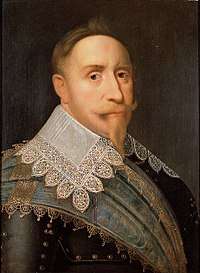
The Thirty Years' War (1618–1648) was an especially devastating European war of religion. It was fought roughly between two factions (although some allegiances would change during it). These included:
- The Catholic Habsburg states and allies, which included the Habsburg Austrian Monarchy and Spain, and the Holy Roman Empire Catholic League (mainly southern states which included Austria). The Holy Roman Emperors Ferdinand II and Ferdinand III, who reigned 1619–1637 and 1637–1657, spearheaded the Catholics.
- The anti-Habsburg states were mainly Protestant, with the notable exception of Catholic France. It also included the Scandinavian states of Denmark–Norway and Sweden; the Dutch Republic; and England and Scotland. Some Holy Roman Empire states were included, like Bohemia, Electoral Palatinate, Saxony, and Brandenburg-Prussia; but Saxony and Brandenburg-Prussia would join the Habsburgs in the fight against France. France was ruled by Louis XIII (1610–1643) and Louis XIV (1643–1715), and Cardinal Richelieu was First Minister of State 1624–1642.
There were many aspects to the war, but important ones include:
- Bohemian Revolt (1618–1620); was a revolt of the Hussites; see earlier movements above. It ended in success for the Habsburgs with the decisive Battle of White Mountain (1620).
- Danish phase (1625 to 1629). Christian IV of Denmark, king of Denmark–Norway, invaded the Holy Roman Empire to support the Protestants, but was soon forced to retreat. With the Treaty of Lübeck (1929), Denmark–Norway participation ended, and their nation would then decline.
- Swedish phase (from 1630). Protestant Gustavus Adolphus of Sweden invaded the Holy Roman Empire with considerable success, with battles such as the Battle of Breitenfeld (1631); this helped to establish Sweden as a great power. But Adolphus was killed at the Battle of Lützen (1632). The Peace of Prague (1635) more or less ended Holy Roman Empire civil war aspects.
- French phase (from 1635). Bourbon France, allied with Sweden, fought against the Austrian and Spanish Habsburgs, despite France being Catholic. The French had a great general in the Viscount of Turenne. It included the Battle of Rocroi (1643), a decisive French victory over the Spanish.
- War in the Iberian Peninsula began in 1640 and continued after 1648. The Reapers' War (1640–1659), or the Catalan Revolt, was a part of the Franco-Spanish War of 1635 to 1659; it included the French occupation of Roussillon in the Eastern Pyrenees (1642). The Portuguese Restoration War (1640–1668) resulted in the breaking up of the Iberian Union of Spain and Portugal.
Other aspects include: the Palatinate campaign, the Habsburg conquest of the Electoral Palatinate (1620–1623); Ottoman support for Protestant Transylvania and the Polish–Ottoman War of 1620–21; Protestant Huguenot rebellions in France (1621–1629); the Peasants' War in Upper Austria, whose goal was to free Upper Austria from Bavarian rule (1626); and the War of the Mantuan Succession in northern Italy (1628–31). There were a total of eight million fatalities, including soldiers and civilians. There was widespread famine and devastation of the Low Countries as a result of the war.
Peace of Westphalia (1648) ended the The Thirty Years' War, although warfare continued in Iberia. The war weakened the Holy Roman Emperor and the Habsburgs, with power returned to the Imperial Estates. There was formal independence for the Dutch Republic with the end of the Eighty Years' War (the Dutch War of Independence, 1568–1648); and also for Switzerland. Territorial changes included gains by France, Sweden, and Brandenburg-Prussia. Princes within the Holy Roman Empire could determine their state's religion from Catholicism and Lutheranism, and now Calvinism was also acceptable.
The Franco-Spanish War concluded with the Treaty of the Pyrenees (1659), and France gained some territories there from Spain. With the Treaty of Lisbon (1668), Spain lost Portugal, but still held the Spanish Netherlands, and a greater part of Italy. Conflict between France and Habsburg Spain would continue with later wars, the War of Devolution (1667–68), the Franco-Dutch War (1672–1678), the War of the Reunions (1683–1684), and the Nine Years' War (1688–1697).
Age of Discovery and colonial empires
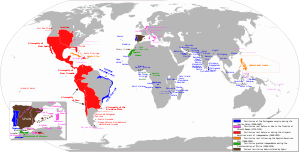
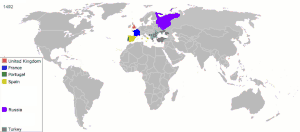
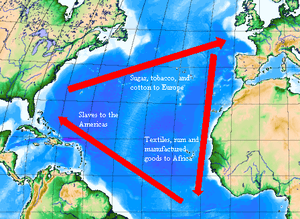
Age of Discovery: from circa 1400 to 1800. Lands include the Americas (the New World); southern Africa; Congo River; West Indies; India; Maluku Islands (Spice Islands); Australasia; New Zealand; Antarctica; Hawaii. Largely coincided with the Age of Sail (1571–1862).
Spanish Empire (1492–1975): Christopher Columbus landed in the New World in 1492. This was followed by La Conquista, the Spanish colonization of the Americas by the conquistadores. Cortes conquered the Aztecs after the Spanish–Aztec War (1519–21). In 1532 Pizarro conquered the Inca empire in Peru. The Maya and many other peoples were also conquered. Spanish lands in the Americas would be mainly divided into Viceroyalties: New Granada, New Spain, Peru, and Río de la Plata; and also Spanish Louisiana, and many other islands and territories.
Portuguese Empire (1415–1999): Vasco da Gama, during his voyage to India (1497–1499), performed the first navigation around South Africa, to connect the Atlantic and the Indian oceans. This would lead to Portuguese dominance in trade routes around Africa, particularly in the spice trade for around a century. Ferdinand Magellan and Juan Sebastián Elcano achieved the first global circumnavigation, 1519–1522. Portuguese influence in the East Indies and South Africa was curtailed by the Dutch–Portuguese War (1601–1663). In South America they ruled the Viceroyalty of Brazil.
The Treaty of Tordesillas (1494) split the world between regions of Spanish and Portuguese influence, but this was ignored by other nations. This resulted in the Spanish being particularly active in Americas, while Portuguese influence in the Americas was limited to Brazil. The Portuguese established a large number of trading posts around the coasts of India, the East Indies, Africa and Arabia.
Major colonial empires that followed included the English (from 1583, which in 1707 became British); Dutch (from 1581); and French (1534–1980). In North America, the British, French and Spanish dominated. South and Central America was mainly Spanish, with the Portuguese in Brazil. Dutch colonies were split between the Dutch East India Company (particularly in the East Indies and South Africa) and Dutch West India Company (mainly on the east coast of the Americas). The Dutch discovered Australia in 1606, and New Zealand in 1642; both of these would later colonised by the British. Anglo-Dutch Wars: were a series of four wars fought in the 17th and 18th centuries; largely a result of English and Dutch rivalry, mainly over trade and overseas colonies; most battles were fought at sea.
The Danish empire (1536–1953) included Norway, Iceland and Greenland. The Swedish empire (1638–1663 and 1784–1878) mainly consisted of Finland and the Baltic states.
Atlantic slave trade was a major source of wealth to Europe and its colonies; beginning with the Portuguese in 1526, it reached a zenith between 1780 and 1800. In many cases it was a triangular trade; manufactured goods from Europe would be exchanged on the western coats of Africa for slaves; these slaves would be exported to North and South America, and the West Indies; and raw goods would be exported back to Europe. By volume, the empires trading slaves were the Portuguese, British, French, Spanish, and Dutch Empires. It is estimated that over 12 million Africans were shipped across the Atlantic, until it started being outlawed, firstly by Denmark in 1803, and then Britain in 1807. In 1888 Brazil became the last Western country to abolish slavery.
Golden Age of Piracy: spans the 1650s to the late 1720s. Main seas of piracy were the Caribbean Sea, the Atlantic Ocean, the Indian Ocean, and the Red Sea. It includes colorful pirates of the Caribbean such as Henry Morgan, William 'Captain' Kidd, 'Calico' Jack Rackham, Bartholomew Roberts and Blackbeard (Edward Teach).
Later on, in the late modern period (19th and early 20th centuries), Italy, Germany, Belgium, Japan and the USA established empires. The British Empire rapidly expanded in this period, and eventually included India, Australia and much of Africa. France colonized much of North Africa, and French Indochina (today Vietnam, Laos and Cambodia).
Rise of philosophy, the arts, science and trade
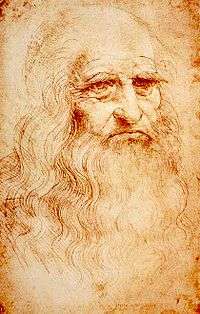
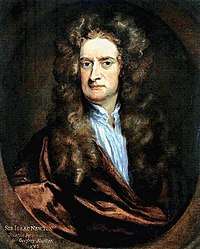
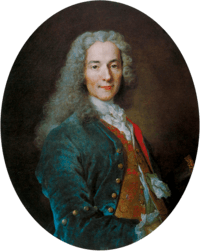
The Renaissance
The Renaissance began in Italy 14th century, and continued into the 17th century. It literally meant "rebirth", as it was seen as a rebirth of Classical learning and culture. There were developments in philosophy (particularly humanism), science, technology, and warfare. There were also artistic developments, including architecture, dance, fine arts, literature and music. There was renewed interest in Classical Roman and Greek texts, but also translations of Arabic texts. Early writers included Dante Alighieri, who wrote the Divine Comedy c. 1308 to 1320. Petrarch (1304–1374) was a particular proponent of humanism.
The High Renaissance, with Leonardo da Vinci, early Michelangelo, Raphael, and the architect Bramante, was between circa 1495 to 1520; it ended with the death of Raphael. Other artists included the sculptor Donatello, Titian, Sandro Botticelli, Masaccio, Giotto, Paolo Veronese, Tintoretto, Giovanni Bellini, Filippo Lippi, Paolo Uccello, and Antonio da Correggio. Filippo Brunelleschi was one of the foremost architects and engineers.
The House of Medici ruled Florence (as the Republic then Duchy of Florence, and as the Grand Duchy of Tuscany), for most of the period from 1434 to the early 18th century. They patronized many intellectuals associated with the Renaissance; these included Leonardo da Vinci, Michelangelo, Niccolò Machiavelli, Galileo Galilei and Sandro Botticelli. Lorenzo de’ Medici is particularly associated with this patronage.
The Roman Inquisition began in 1542, and suppressed some aspects of the Renaissance. It made some books forbidden, such as On the Revolutions of the Heavenly Sphere by Polish scientist Nicolaus Copernicus; first printed in 1543, it promoted the heliocentric theory of the Solar System. It also held trials against intellectuals; Galileo Galilei, who supported the work of Copernicus in his Dialogue Concerning the Two Chief World Systems (1632), was put on trial.
Outside of Italy, Renaissance ideas soon spread across Europe to countries such as England, France, Germany, Hungary, the Low Countries, Poland, Portugal, Russia, Spain, Croatia, and Scotland. The invention of the printing press, which was greatly improved by the German Johannes Gutenberg circa 1439, helped in the dissemination of learning. In the English Renaissance, the works of William Shakespeare (1564–1616) are often regarded as the greatest in English literature. Other notable artists included: the German artists Hans Holbein the Younger, Hans Holbein the Elder, and Albrecht Dürer; the Dutch artists Hieronymus Bosch, Pieter Brueghel the Elder, Pieter Brueghel the Younger, and Jan van Eyck; and the Greek artist El Greco.
Baroque Period and Age of Enlightenment
Baroque Period (17th and 18th centuries) was characterised by highly ornate styles in architecture, music, painting, and sculpture. Artists included Velázquez, Caravaggio, Rembrandt, Rubens, Poussin, and Vermeer. Baroque composers included Johann Sebastian Bach, Antonio Vivaldi, George Frideric Handel, Claudio Monteverdi, and Henry Purcell. It was followed by the Classical period of music; roughly between 1730 and 1820, it included Joseph Haydn, Wolfgang Amadeus Mozart, Ludwig van Beethoven, and Franz Schubert. Rococo, or "Late Baroque", spread across Europe in the mid-18th century.
Age of Enlightenment or Age of Reason was during the 18th century, and sometimes extended to the 17th century. Ideas that were developed were characterised by being secular, pluralistic, rule-of-law-based, with an emphasis on individual rights and freedoms. There was also an emphasis on science. Prominent scientists included Isaac Newton and Gottfried Leibniz, who built on the earlier work of Francis Bacon, the father of empiricism. Prominent philosophers included:
- French philosophers René Descartes (who contributed to rationalism), Voltaire (a particular advocate of freedom of speech and religion), Denis Diderot (and his Encyclopédie), and Montesquieu (and his theory of separation of powers).
- English philosophers John Locke and Thomas Hobbes, who both contributed to empiricism and social contract theory.
- Prussian-German philosopher Immanuel Kant, and the doctrine of transcendental idealism.
- Dutch-Portuguese philosopher Baruch Spinoza, a rationalist.
Voltaire and Benjamin Franklin greatly influenced the French Revolution and the American Revolution. The encyclopedia Encyclopédie (1751–72), edited by Denis Diderot, was a great success of the period.
Enlightened absolutism, the use of the the Enlightenment to espouse absolute monarchy, was a curious side effect; much later it was followed by the concept of the benevolent dictatorship. Joseph II, the Holy Roman Emperor 1765–1790, was a prominent monarch of the Enlightenment and enlightened absolutism, along with Catherine the Great of Russia, and Frederick the Great of Prussia.
Capitalism and mercantilism
Rise of capitalism: capitalism became a dominant force in the sixteenth century, with the abolition of feudalism. It took its name from capital, defined by Adam Smith as "that part of man's stock which he expects to afford him revenue". The investment of capital became the primary factor in the accumulation of wealth.
Mercantilism, the exporting goods from countries, also rose in importance, particularly as a result of colonialism, with the trade of slaves and goods across the Atlantic Ocean being particularly important.
Chapter 5 Late modern period
The Late modern period was circa 1750–1945, or 1800–1945. It may also be extended to the present day.
The "long nineteenth century" was 1789–1914. See also: Wikipedia:Late modern period
States and territories of the late modern period
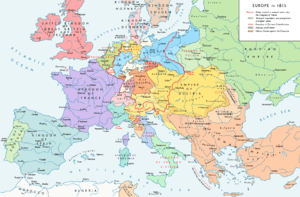
In 1815 states included:
- Northern Europe
- Included Sweden–Norway (1814–1905) and Denmark. The Kingdom of Great Britain (1707–1801) (of England, Wales and Scotland) would merge with the Kingdom of Ireland (1542–1801) to create the United Kingdom of Great Britain and Ireland (1801–1922); this later became the United Kingdom of Great Britain and Northern Ireland and the Republic of Ireland.
- Western and Central Europe
- Included France and Switzerland. The German Confederation included some of the Kingdom of Prussia and the Austrian Empire. The United Kingdom of the Netherlands (1815–1839) covered the present-day Netherlands and Belgium. The Belgian Revolution (1830–1831) and the First Treaty of London (1839) resulted in Belgium separating from the Netherlands, mainly on the grounds of religion as Belgium was mainly Catholic, and the Dutch were mainly Protestant; Luxembourg, in the area were they spoke a German dialect called Luxembourgish, also received independence. After the Luxembourg Crisis (1867) between the the French Empire and Prussia, the Second Treaty of London (1867) was passed.
- Eastern Europe
- Included the Russian Empire and Congress Poland; Congress Poland became a puppet state of Russia, although the Polish Free City of Cracow (1815–1846) was autonomous until annexed by the Austrians. The Prince-Bishopric of Montenegro (1516–1852) would later became the Principality of Montenegro. The Ottoman Empire included the semi-autonomous Principality of Serbia (1815–1882). The Danubian Principalities (Moldavia and Wallachia) were Ottoman vassals which would later become the United Principalities (1859–1881), later renamed to Romania; they eventually, with Transylvania, formed the basis for the Kingdom of Romania (1881–1947). With the Greek War of Independence (1821–1832), Greece would obtain independence from the Ottomans as the Kingdom of Greece (1832–1924).
- Iberian Peninsula
- Included Spain and Portugal.
- Italian Peninsula
- Included the kingdoms of Sicily and Naples. Northern Italy included the Kingdom of Sardinia (with Piedmont, Nice, Savoy, Genoa), the Grand Duchy of Tuscany, the Kingdom of Lombardy–Venetia (Austrian), the Papal States, and the duchies of Lucca, Massa and Carrara, Modena and Reggio, and Parma; and San Marino.
Age of Revolution and late eighteenth century
Age of Revolution (1774–1848): saw a rise of revolutionary activities, especially away from absolute monarchy and towards constitutional republics. The Atlantic Revolutions was a revolutionary wave within the Atlantic World, and included: the American Revolution (1765–1783); the French Revolution (1789–1799); the Haitian Revolution (1791–1804), a large slave rebellion followed by a massacre of the French (1804); the Irish Rebellion of 1798, which would contribute to the formation of the United Kingdom of Great Britain and Ireland; and the Spanish American wars of independence (1808–1833).
Other revolutionary waves included the Revolutions of 1820 and the Revolutions of 1830. The Ottoman Empire would also experience unrest in this period, with the Serbian Revolution (1804–1835) and the Greek War of Independence (1821–1832). The Revolutions of 1848, with widespread revolt across Europe, contributed to the French Revolution of 1848, and the First Italian War of Independence (1848–1849).
Seven Years' War, and French and Indian War
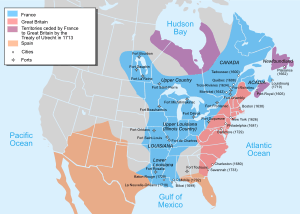
.jpg)
Seven Years' War (1756–1763) split Europe into two coalitions: (i) Kingdom of Great Britain coalition, including the German states of Prussia and Hanover, and Portugal; (ii) Kingdom of France coalition, including the Habsburg/Austrian Monarchy, Russian Empire, Bourbon Spain, and Sweden. Major European theaters included: Silesia, Pomeranian War (Sweden and Prussia), and the Spanish invasion of Portugal (1762). Other European theaters included: Bohemia and Moravia; Westphalia, Hesse, and Lower Saxony; Upper Saxony; Brandenburg; and East Prussia.
The Seven Years' War also had theaters in North America, West Indies, West Africa, India, and Uruguay and Rio Grande do Sul. It resulted in a Anglo-Prussian coalition victory, although there was little change in European territories. There were transfers of colonial possessions, including in North America, and India (the Northern Circars ceded to Great Britain). After the Anglo–Spanish War (1762–1763), Spain ceded Florida to Britain in exchange for return of Havana.
French and Indian War (1754–1763) was a North American theater of the Seven Years' War, although warfare was extended during the period 1688 and 1763. Principally it was British America against New France and its Indian allies. It ended with Louis XV ceding New France (a North American territory roughly west of the Thirteen Colonies) to Spain and Great Britain after France's defeat. Britain received Canada, Acadia, and parts of Louisiana, with Spain gaining the larger portion of Louisiana.
After the war French possessions in North America were reduced to the islands of Saint Pierre and Miquelon. In 1800 Spain returned its portion of Louisiana to France, but Napoleon Bonaparte in turn sold it to the United States in the Louisiana Purchase of 1803.
American Revolution
American Revolution (1765–1783): resulted in the Kingdom of Great Britain losing possession of the United States of America (USA), called the Thirteen Colonies until the Declaration of Independence of the Second Continental Congress on July 4, 1776. It included the American Revolutionary War (1775–1783). In 1765 the First Congress of the American Colonies met in response to taxation introduced by the Stamp Act. The Boston Tea Party (1773) was an act of symbolic defiance against the tax on tea. In 1774, the First Continental Congress attempted to create at a separatist government. War erupted in 1775, with the Patriots (and later their French, Spanish, and Dutch allies) against the British and Loyalists (also known as Tories).
In 1783 the British capitulated to the Americans, and signed the Treaty of Paris. George Washington was the first President of the United States (1789–1797), and the Commander-in-Chief of the Continental Army during the American Revolutionary War. George Washington is one of the Founding Fathers of the United States, along with Thomas Jefferson, Benjamin Franklin, John Adams, Alexander Hamilton, John Jay, and James Madison.
Partitions of Poland
Partitions of Poland (1772–1795): in a series of partitions, the Polish–Lithuanian Commonwealth was partitioned to the Habsburg/Austrian Monarchy, Kingdom of Prussia, and Russian Empire. Three partitions took place in 1772, 1793, and 1795. In 1807, Napoleon resurrected Poland when he set up the Duchy of Warsaw.
French Revolution


.jpg)
The French Revolution (1789–1799) was a period of French history that resulted in the abolition of the Ancien Régime (the Old Rule of the monarchy and nobles), the establishment of a republic based on secular democracy and liberalism, and the rise of Napoleon Bonaparte. The guillotine was used in many executions during this period.
Key events included:
- The formation of the Third Estate of the Estates-General (May 1789), an assembly representing commoners, as opposed to clergy (the First Estate) and nobility (the Second Estate); it was then renamed the National Assembly (17 June 1789).
- The National Constituent Assembly (July 1789 to September 1791) followed the National Assembly after its members took the Tennis Court Oath (20 June 1789).
- The Storming of the Bastille (a state prison), a mainly symbolic gesture, commenced on 14th July 1789, and is now commemorated on Bastille Day.
- The abolition of feudalism (August 1789), and later the privileges of the nobility (June 1790). The Declaration of the Rights of Man and the Citizen (in part drafted by the Marquis de Lafayette) was adopted in August 1789, and was later followed by the Declaration of the Rights of Woman (September 1791).
- The Women's March on Versailles (October 1789) compelled the Louis XVI and most of the Assembly to return with them to Paris; Louis took up residence in the Tuileries Palace in Paris.
- Jacobin Club (re-founded in Paris in November 1789) was a nationwide republican movement, which would greatly influence three main bodies of revolutionaries of whom many were members: Montagnards, Girondins, and Maraisards. The sans-culottes (lower-class radicals) were closely aligned, and involved in the September Massacres (September 1792).
- The Civil Constitution of the Clergy (July 1790) caused the immediate subordination of the French clergy to the French government. Many anti-clerical laws would later be passed.
- The Flight to Varennes (June 1791) of Louis XVI, and his subsequent capture, damaged his prestige. The Champ de Mars massacre (July 1791) took place after it was announced that Louis XVI would retain his throne.
- The National Legislative Assembly (October 1791 and September 1792) replaced the National Constituent Assembly as legislative body, with government on the basis of a constitutional monarchy, a position favored by moderates such as the Count of Mirabeau.
- The Paris Commune, who ruled Paris, became dominated by Jacobins in 1792, and would became insurrectionary that summer; it lost much power in 1794 and was replaced in 1795 by the French Directory.
- The National Convention (1792–1795) replaced the National Legislative Assembly on 20 September, after the storming of the Tuileries Palace (10 August 1792); it was dominated by Jacobins.
- The French First Republic (1792–1804) was declared on 22 September 1792 by the National Convention. This ended the reign of Louis XVI; he was then executed in January 1793, followed by his wife Marie Antoinette nine months later.
- The Committee of Public Safety (1793–1795) was first chaired by the Montagnard Georges Danton (who was executed with Camille Desmoulins in April 1794). It held de facto executive from April 1793, and organized the Reign of Terror (1793–1794), with resulted in over 40,000 executions, particularly from the Law of Suspects (September 1793).
- The fall of the Girondin party took place after the Insurrection of 31 May to 2 June 1793; in July 1793 Jean-Paul Marat was assassinated by Charlotte Corday (a Girondin sympathizer); and in October 1793 many prominent Girondins were then executed, including Jacques Pierre Brissot.
- The Thermidorian Reaction ended the Reign of Terror; Montagnard committee member Maximilien Robespierre, Louis Antoine de Saint-Just, and twenty of their allies were executed by the Thermidorians on 28 July 1794. It was followed by the First White Terror (1794–1795) against people identified as being associated with the Reign of Terror, particularly those of the Jacobin Club which was suppressed and disbanded.
- The French Directory (1795–1799) in November 1795 became the new five-member executive elected by the legislature (the Council of Five Hundred and Council of Ancients), after 13 Vendémiaire (an October 1795 battle between revolutionary troops and royalist forces in Paris). The Committee of Public Safety and National Convention were abolished.
- There was a number of coups during the French Directory: the Conspiracy of the Equals (May 1796, a failed royalist coup), the Coup of 18 Fructidor (September 1797, against the royalists), and the Coup of 30 Prairial VII (June 1799, with Emmanuel-Joseph Sieyès gaining control).
- The Coup of 18 Brumaire (9 November 1799) ended the French Directory and the French Revolution era; the French Consulate and Napoleonic Era began the next day.
French Revolutionary Wars
French Revolutionary Wars (1792–1802): were wars of French Republic against Great Britain, Austria and others, sparked by the overthrow of Louis XVI. They included two wars, well as numerous other conflicts:
- War of the First Coalition (1792–1797): with French annexation of the Austrian Netherlands, the Left Bank of the Rhine and other smaller territories. Northern Italy and other territories were turned into several French sister republics.
- War of the Second Coalition (1798–1802): the previous annexations by France were confirmed. France was led by Paul Barras (until 1799) and Napoleon Bonaparte (from 1799).
The French Revolutionary Army was greatly strengthened by Lazare Carnot. The Levée en masse introduced mass national conscription (August 1793). Napoleon was the most successful general for France, and conquered much of Italy (campaigns of 1796 and 1797), and made the Austrians sue for peace; he also led the French campaign in Egypt and Syria (1798–1801). The French Revolutionary Wars temporarily ended with the Treaty of Amiens 1802, but would flare up in 1803 with the Napoleonic Wars.
Napoleonic Era
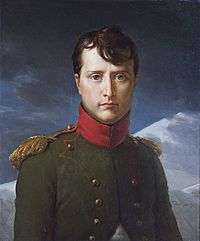

.jpg)
Napoleonic Era (1799–1815) was the era when France was led by Napoléon Bonaparte, as First Consul (1799–1804) and then Emperor (1804–1814, 1815).
The French Consulate (1799–1804) began with Napoleon Bonaparte seizing control on 10 November 1799 and becoming First Consul. The Provisional Second and Third Consuls Emmanuel Joseph Sieyès and Roger Ducos were soon replaced by J.J. Cambacérès and Charles-François Lebrun. The three parliamentary assemblies were the Conseil d'État, Tribunat, and Corps législatif; the Sénat conservateur directly advised the First Consul.
It was followed by the First French Empire (1804–1814, 1815), when Napoléon was crowned Emperor of the French, replacing the Consulate. He had previously gained Life Consulship (May 1802). In 1812, France was enlarged with territories such as the Low Countries and parts of Italy; and had client states such as the Confederation of the Rhine, Switzerland, the Kingdom of Italy, the Kingdom of Naples, the Duchy of Warsaw, and Spain; and had allies such as Austria and Prussia.
Napoleonic Wars
The Napoleonic Wars (1803–1815) were a series of conflicts between Napoleon's France its allies and client-states, against the Coalition Forces of the Napoleonic Wars (the third through to the seventh). They began with the United Kingdom declaring war on France in May 1803. Co-belligerents with the UK included Holy Roman Empire (pre-1806), Austria (from 1804), Prussia, and Russia, among others; the French were allied with their client states. The wars were a continuation of the French Revolutionary Wars (1792–1802), with the War of the Second Coalition (1798–1802) being part of the French Revolutionary Wars and the Napoleonic Era.
Major battles and aspects of the Napoleonic Wars included the following:
- War of the Third Coalition (1803–1806). The Franco-Spanish navy was defeated by the British Navy (commanded by Horatio Nelson) at the Battle of Trafalgar (1805), off Cape Trafalgar, Spain; this prevented a French invasion of England. But the French were victorious over the Russian-Austrian army at the Battle of Austerlitz (1805) in Austrian Moravia. The Confederation of the Rhine was created, and the dissolution of the Holy Roman Empire followed (1806).
- War of the Fourth Coalition (1806–1807). The French had victories over the Prussia and Saxony at the Battle of Jena–Auerstedt (1806) in Germany; and the Russians at the Battle of Friedland (1807) in Prussia. This created an uneasy truce, with the Napoleon receiving many Prussian lands; these contributed to the formation of the Kingdom of Westphalia and Duchy of Warsaw,
- French Invasion of Portugal (1807), and the subsequent overthrow of the Spanish Bourbons (1808) and occupation of Spain and Portugal. The Peninsular War (1808–1814) eventually resulted in the expulsion of the French from Portugal and then Spain. The Battle of Vitoria (1813) in Spain was a decisive victory for the British, who were led by the Duke of Wellington (Arthur Wellesley).
- War of the Fifth Coalition (1809), with a French victory over the Austrians at the Battle of Wagram (1809) in Austria. The French imposed harsh terms on the Austrians.
- French invasion of Russia (1812), and the resulting catastrophe for the French; the French Grande Armée of circa 685,000 troops had losses of circa 500,000; the Russians lost a similar amount. It included the major but indecisive Battle of Borodino (1812) in Russia.
- War of the Sixth Coalition (1812–1814), with French defeat by coalition forces at the Battle of Leipzig (1813) in Saxony; but the French had success in the Six Days' Campaign (1814) in northeastern France. The Battle of Paris (1814) ended the war in favor of the coalition.
- Hostilities temporarily ended with Provisional Government of 1814, and then the first Bourbon Restoration (1814–1815) of the Kingdom of France under Louis XVIII. Napoleon was forced to abdicate, and was temporarily exiled to the island of Elba (1814–1815).
- The Hundred Days, or War of the Seventh Coalition (1815), was the from 20 March 1815 (the French Government of the Hundred Days after Napoleon's return from Elba), to 8 July 1815 (the second Bourbon Restoration), a period of 111 days. Napoleon's was defeated at the Battle of Waterloo (1815) in present day Belgium; this was by an Anglo-allied army (commanded by the Duke of Wellington), and a Prussian army (commanded by Field Marshal Blücher). The French had previously beaten the Prussians at the Battle of Ligny two days earlier.
The French Provisional Government of 1815 was followed by the second Bourbon Restoration (1815–1830), the restoration of the Kingdom of France at first under Louis XVIII. Napoleon was permanently exiled to St. Helena, where he died in 1821. The Bourbons were overthrown in 1830, but the French monarchy survived until the French Second Republic (1848–1852).
Other wars of the Napoleonic Era included the following (some of which may be also included in the Napoleonic Wars): Anglo-Spanish War (1796–1808); English Wars (of the UK and Sweden against Denmark-Norway, 1801–1814); Russo-Persian War (1804–13); Franco-Swedish War (1805–1810 which included the Finnish War of 1808–1809); Russo-Turkish War (1806–1812); Anglo-Turkish War (1807–1809); Anglo-Russian War (1807–1812); Anglo-Swedish War (1810–1812); War of 1812 (between the United States and the United Kingdom, 1812–1815); Swedish-Norwegian War (1814). The Latin American wars of independence, the wars for independence of countries in Latin America mainly from the Spanish, were greatly influenced by the Napoleonic Wars.
Post-Napoleonic Europe
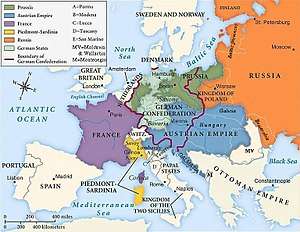
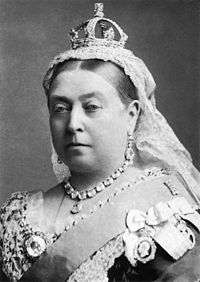
Congress of Vienna (Final Act 1815): ended the Napoleonic Era. Austrian Empire gains included Lombardy–Venetia (1815–1866), Tyrol and Salzburg. Prussia gained parts of: Saxony, Duchy of Warsaw, Danzig, and the Rhineland/Westphalia. Congress Poland (1815−1867) formed, which later became part of Russian Empire (1867−1915). United Kingdom of the Netherlands (1815–1839) was formed (now the Low Countries). Russia annexed Finland from Sweden; Norway was taken from Denmark and given to Sweden. Many other territorial changes occurred.
Concert of Europe (1815): also known as the Congress System or the Vienna System, it was a system of dispute resolution founded by the Quadruple Alliance (Austria, Prussia, Russia, and the UK) that defeated Napoleon. The Quadruple Alliance, minus the UK, also formed the Holy Alliance that same year. The principles were that no important change take place without the consent of these Great Powers, and that a the balance of power be maintained.
Pax Britannica (1815–1914) was a period of relative peace between the five great powers of the period: the Austrian Empire, France, Prussia, Russia, and the United Kingdom. Other powers had lessened influence, such as Spain, Portugal, and Sweden. The United Kingdom in particular had a position of hegemony (that is, leadership and dominance) through its British Empire and Royal Navy. The Royal Navy had surpassed the Dutch Navy and the French Navy to "rule the waves". Slavery was abolished within the British Empire in 1833 under William IV. Queen Victoria, who reigned 1837–1901, ruled over the Victorian era of the United Kingdom, characterized by great national confidence in empire and industry.
Post-Napoleonic France

Post-Napoleon, major French regimes included:
1. Monarchies of the Kingdom of France (1814–1815 and 1815–1848):
- Bourbon Restorations (1814–1815 and 1815–1830): with the reigns of Louis XVIII (until 1824) and Charles X (1824–1830); both restorations of Louis XVIII were preceded by Provisional Governments.
- July Monarchy: after the July Revolution (1830) resulted in the reign of the the Orléans King Louis Philippe I (1830–1848). The June Rebellion (1832): which was an unsuccessful Paris uprising immortalised in Les Misérables.
2. France after the French Revolution of 1848:
- French Second Republic (1848–1852): preceded by Provisional Government, and with President Charles-Louis Napoléon Bonaparte (the nephew of Napoleon) ruling after the presidential election of 1848.
- Second French Empire (1852–1870): after the French coup d'état of 1851, with Charles-Louis Napoléon Bonaparte ruling as Emperor Napoleon III.
- French Third Republic (1870–1940): after the collapse of the regime of Napoleon III, during defeat in the Franco-Prussian War (1870–1871). The Paris Commune (1871) was bloodily suppressed. The first government was the Government of National Defense.
- In 1940, during World War II, mainland France separated into: (i) zone libre ("free zone") administered by Vichy France, although the zone sud ("south zone") was later occupied by Italy; (ii) zone occupée/nord ("occupied/north zone") occupied by Germany, with the zone interdite/réservée ("forbidden/reserved zone") reserved for coastal military and German settlement. Alsace-Lorraine was secretly annexed by Germany, and some border areas were annexed by Italy. France's colonies came under occupation by Germany, Italy, Japan, and Thailand. Free France was a government-in-exile led by Charles de Gaulle.
- Provisional Government of the French Republic (1944–1946), after the liberation of continental France.
- French Fourth Republic (1946–1958), a post-World War II republic.
- French Fifth Republic (1958 to the present day) was established after the Algerian crisis of 1958.
Revolutions of 1848
Revolutions of 1848: across much of Europe (1848–1849), with numerous revolutions and periods of unrest. In France it contributed to the formation of the French Second Republic (1848–1851). In Hungary, the Hungarian Revolution of 1848 would eventually give rise to the Austro-Hungarian Compromise (1867), which gave birth to Austria-Hungary. In Italy, temporary independence in Sicily was created, followed soon after by the First Italian War of Independence (1848–1849). In the Danish Duchy of Schleswig, unrest contributed to the the First Schleswig War (1848–1852) against the Germans, which ended with a Danish victory; but in the Second Schleswig War (1864), Schleswig-Holstein would be lost to the Germans.
There were numerous other events; 1848 was also the year of the publication of The Communist Manifesto by Karl Marx and Friedrich Engels.
Spain during the late modern period
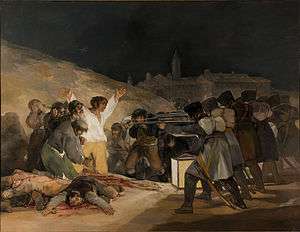
Bourbon monarchs ruled the Kingdom of Spain between 1700 to 1808, interrupted by Joseph Bonaparte of the House of Bonaparte (1808–1813), who was installed by Napoleon during the Peninsular War. After Spanish victory in the Peninsular War the Bourbons were restored (1813–1868) with Ferdinand VII (who reigned in 1808 and 1813–1833); during this period the Spanish colonies in the New World were lost, except for Cuba and Puerto Rico.
Carlism was an attempt to promote a rival branch of the House of Bourbon to the Spanish monarchy; it stemmed from Infante Carlos, Count of Molina, who claimed the monarchy after the death of his brother Ferdinand VII in 1833, over Ferdinand's daughter Isabella II. This led to the Carlist Wars for the monarchy, which were unsuccessful, although Carlism would continue as right-wing political movement, and Carlists were instrumental for the Nationalists during the Spanish Civil War.
Isabella II was later deposed in the Spanish Glorious Revolution (1868). The Glorious Revolution was followed by the Sexenio Democrático (six democratic years): Provisional Government (1868–1871), King Amadeo I of the House of Savoy (1871–1873), and the First Spanish Republic (1873–1874). The Bourbons were then restored for the second time during the period known as the Restoration (1874–1931) with Alfonso XII of Spain. After the fall of Alfonso XIII of Spain, in part due to economic chaos caused by the Wall Street Crash (1929), the Second Spanish Republic (1931–1939) was established.
General Franco was proclaimed Head of State after the Spanish coup of July 1936; in the Spanish Civil War (1936–1939) Franco's Nationalists defeated the Republicans, and Franco would remain dictator of Francoist Spain until his death in 1975. In 1947, Spain was declared a kingdom, but without a monarch; not until 1969 did Franco establish Juan Carlos of Bourbon as the heir to the monarchy. After Franco's death, democracy was slowly established under a constitutional monarchy with a Bourbon monarch, the third restoration of the Spanish Bourbons; this continues to this day. Juan Carlos I (who reigned 1975–2014) was succeeded by Felipe VI (2014 to present).
Crimean War
Crimean War (1853–1856): the Russian Empire lost to an alliance of the Ottoman Empire, France, Britain and Sardinia. Russia was expanding into the Danubian Principalities, then vassals of the Ottoman Empire. Also involved the rights of Christians (Roman Catholic and the Eastern Orthodox) at Holy Land sites, then under the Ottoman Empire. Fighting took part on the Crimean peninsula and around the Black Sea.
Risorgimento

The Risorgimento, or Italian unification, occurred between 1815 and 1871. After the Congress of Vienna (1815), there were many changes in the Italian makeup. The Kingdom of Sardinia was restored to include Sardinia, Piedmont, Nice, Savoy, and Genoa. With the Kingdom of the Two Sicilies, Sicily and Naples were restored to the Bourbon King Ferdinand I of the Two Sicilies. Austria gained Lombardy-Venetia (Lombardy and Venice). Italy also consisted of the Papal States, some independent central states (Tuscany, Parma, Modena and Lucca), and San Marino.
The Revolutions of 1848 created temporary independence in Sicily. The First Italian War of Independence (1848–1849) resulted in a victory of Austria over Sardinia; but after the Second Italian War of Independence (1859), Sardinia annexed the majority of Lombardy from Austria. Also in 1859, the United Provinces of Central Italy was created from the duchies of Tuscany, Parma, and Modena, and the Papal Legations; in 1860, Central Italy was united with Sardinia, but Savoy and Nice were annexed by the French. In 1861 the Kingdom of Italy (1861–1946) was proclaimed under King Victor Emmanuel II, with much of the Two Sicilies and Papal States having been annexed. After the Third Italian War of Independence (1866), Venetia was annexed; and in 1870 most of the remaining Papal States were further annexed. Only Vatican City and San Marino were to remain independent. In 1871 the capital was moved from Florence to Rome.
Giuseppe Garibaldi was a popular statesman and the greatest military leader during unification, his actions included leading the Expedition of the Thousand (1860–1861) to conquer the Two Sicilies.
German Empire

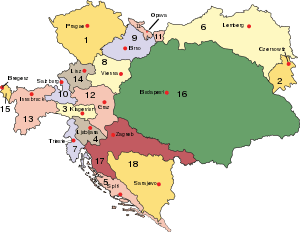
The Holy Roman Empire was dissolved to form the Napoleon's Confederation of the Rhine (1806–1813). It was eventually replaced by the German Confederation (1815–1866), with 39 states created from the previous 300 states of the Holy Roman Empire. The German Confederation contained (in part) two major states: the Kingdom of Prussia (1701–1918) and the Austrian Empire (1804–1867).
After the Austro-Prussian War (1866), the North German Confederation (1867–1871) of northern German states was formed, which excluded the Austrian Empire and the southern German states. With the Franco-Prussian War (1870–1871), which included the Siege of Paris (1870–71), France was defeated by Prussia, and Alsace-Lorraine was annexed by the Germans. In January 1871 the German Empire was declared, which now included the southern states of Bavaria, Württemberg, Baden and Hesse. The new Constitution of the German Empire was then adopted, with Germany under the permanent presidency of Prussia.
The German Empire (Deutsches Kaiserreich) (1871–1918) was a federal semi-constitutional monarchy; the German Emperor was the King of Prussia, and included Wilhelm I (1871–1888), Friedrich III (1888), and Wilhelm II (1888–1918). The empire was composed of four kingdoms: Prussia (Preußen), Bavaria (Bayern), Saxony (Sachsen), and Württemberg. It also included many other territories; larger ones included Baden, Hesse, Oldenburg, Mecklenburg-Schwerin and Alsace-Lorraine. The first chancellor was Otto von Bismarck (1873–1890), who had been Minister President of Prussia from 1862; nicknamed the "Iron Chancellor", he is regarded as an outstanding statesman and architect of the German Empire.
After defeat in World War I, the German Empire became a much reduced state called the Weimar Republic (1918–1933); this became Nazi Germany (1933–1945), the "3rd Reich" in Nazi terminology; they considered the 1st as being the Holy Roman Empire, and the 2nd as being the German Empire. After World War II, Germany would be divided into West Germany (the Federal Republic of Germany) and East Germany (the German Democratic Republic), until German reunification in 1990.
Austria-Hungary
Austria-Hungary (1867–1918): was created after the Austrian Empire had left the German Confederation, and the Austro-Hungarian Compromise (1867). Austria-Hungary was a constitutional union between the Austria, Hungary, and Croatia-Slavonia; the Habsburg Austrian Emperor was the monarch. Hungary and Croatia-Slavonia (termed the Lands of the Crown of Saint Stephen or Transleithania) were administered by the Hungarian government; while the other lands (Cisleithania) were administered by the Austrians. Hungary included Transylvania, and the Voivodeship of Serbia and Temes Banat.
Following the Russo-Turkish War (1877–1878), Bosnia and Herzegovina nominally remained under sovereignty of the Ottoman Empire, but was de facto ceded to Austria-Hungary. The Bosnian Crisis of 1908–1909 was created by the formal annexation of Bosnia and Herzegovina by Austria-Hungary.
After defeat in World War I, Austria-Hungary was broken up, and separated into Austria and Hungary; and Austria-Hungarian lands were ceded to Czechoslovakia, Romania, Yugoslavia, Poland, Italy, and Liechtenstein. Before World War II, the Anschluss was the annexation of Austria into Nazi Germany in 1938. After World War II, Austria was again separated from the German states (West Germany and East Germany).
New Imperialism
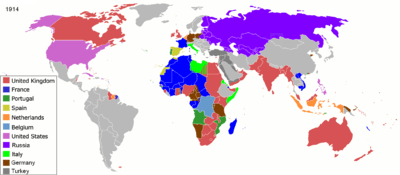

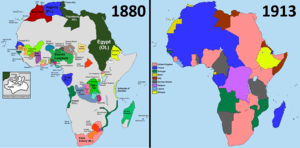
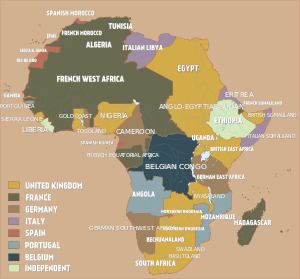
New Imperialism is a term for the imperialism that followed the first wave of European colonization (1402 to 1815). From 1800 onward most of the colonies in the Americas would be lost, with the United States already independent; the largest remaining European colony would be Canada. At around 1800, European power was comparatively weak outside of Europe and the Americas; the larger empires there included the Russian Empire, the British Empire, the Ottoman Empire, Qajar Iran, the Chinese Qing dynasty, and the Indian Maratha Empire; but by 1914 European colonization there had greatly increased.
Britain's imperial century (1815–1914) was a time of unprecedented expansion of the British Empire; it reached a territorial peak in 1921. The East India Company was a British charted company founded in 1600; it seized British possessions on the Indian subcontinent, South East Asia, and Hong Kong. The rivalry between Britain and Russia in Afghanistan and surroundings during this period became known as the Great Game (1830–1895). The British Empire included:
- British Raj (1858–1947), now India, Pakistan and Bangladesh. Asian possessions also included: Burma (now Myanmar), Malaya and British Borneo (now Malaysia and Brunei), Singapore, Hong Kong, British New Guinea (now Papua New Guinea); the Indian Ocean islands of Mauritius, Seychelles, Ceylon (now Sri Lanka); and some islands in the Pacific Ocean.
- African colonies included: Egypt, Sudan, Somaliland, South Africa, South-West Africa (now Namibia), Basutoland (now Lesotho), Swaziland, Bechuanaland (now Botswana), Northern and Southern Rhodesia (now Zimbabwe and Zambia), British East Africa (Kenya, Uganda, Tanzania/Tanganyika, Zanzibar), Gambia, Sierra Leone, Nigeria, British Togoland (now part of Ghana), Cameroons (now parts of Cameroon and Nigeria), Gold Coast (now Ghana), Nyasaland (now Malawi).
- The British also expanded Canada, Australia, and New Zealand. They also had possessions in Europe, the Atlantic Ocean, and South and Central America. They also had protectorates in southern and eastern Arabia and Kuwait.
Most New World possessions of Spain were lost during the Spanish American wars of independence (1808–1833), partly a result of the Napoleonic Wars. Simón Bolívar led the secession of Venezuela, Bolivia, Colombia, Ecuador, Peru, and Panama from Spain. The War of Independence of Brazil (1822–1825) resulted in Brazil becoming independent of Portugal. After these wars, most mainland European colonies in the Americas were lost; colonies that continued included (British) Canada, Russian America (now Alaska), French Guiana, (Dutch) Suriname, (British) Guyana, and British Honduras (now Belize). West Indies colonies were slower to gain independence or remained dependent: these included islands in the French West Indies, British West Indies, Danish West Indies, Netherlands Antilles (Dutch West Indies), and Spanish West Indies (including Cuba).
Scramble for Africa was the rapid colonization of Africa beginning in the late nineteenth century; new empires mostly centered on Africa included the Italian (1869–1960), German (1884–1918), and Belgian (1885–1962) colonial empires; the British, French, Portuguese and Spanish also colonized Africa. In 1870, only 10 percent of Africa was formally under European control. Between 1881 and 1914 the majority of Africa was colonized, with only with only Ethiopia (Abyssinia) and Liberia remaining independent in 1914. The Berlin Conference of 1884–85 to some extent formalized the Scramble for Africa. In 1936 Ethiopia fell to the Italians, and only Liberia remained independent. Gradually, decolonization resulted in the loss of these African colonies by 1975, accelerated by the devastation of the world wars.
Key aspects of the New Imperialism included:
- French colonialism continued, and in the east it would include French Indochina (now Cambodia, Laos, Vietnam), and French Polynesia; and African colonization would become extensive, with French North Africa, French West Africa, French Equatorial Africa, and French East Africa (including Madagascar). They also control French Guiana and the French West Indies.
- German colonial empire was the third-largest colonial empire by 1914, after the British and French; it included German New Guinea (including including German Samoa). African possessions included German Kamerun, German South West Africa, German East Africa, and German Togoland.
- Leopold II of Belgium was founder and sole owner of the Congo Free State (1885–1908), which became infamous for killing and brutality. It was succeeded by the Belgian Congo (1908–1960), and they also controlled Rwanda and Burundi.
- Italian colonization included in the Balkans, Italian East Africa, Italian Libya, and in the Western Mediterranean and Far East. It gained momentum with the rise of Benito Mussolini in 1922, who conquered Albania, Ethiopia, British Somaliland, parts of south-eastern France, western Egypt, and most of Greece; by 1947 it had lost them all, but Italian Somaliland would then become its protectorate.
- The Dutch East Indies (1816–1949) followed on from the possessions of the defunct Dutch East India Company; the territories would form the basis for present-day Indonesia. They also controlled Surinam and the Netherlands Antilles.
- Portuguese colonies in Africa included Angola, Mozambique, Guinea, Cape Verde, and São Tomé and Príncipe; Spanish colonies in Africa included Northern Spanish Morocco, Spanish West Africa, and Spanish Guinea.
- Empire of Japan (1868–1947): after the Meiji Restoration in 1868, Japan built an extensive empire from 1894. It included Taiwan (1895–1945), Korea (1910–1945), Manchuria (as Manchukuo, 1932–1945), and parts of northern China. Japan fought and defeated Russia during the Russo-Japanese War (1904–1905), with Russia losing territories and local influence.
- Century of humiliation was a period of intervention and imperialism by Western powers and Japan in China between 1839 and 1949, with China under the Qing dynasty (1636–1912) and Republic of China (1912–1949). It included defeat in the Opium Wars (1839–1842 and 1856–1860), defeat in the Sino-French War (1884–1885), the First and Second Sino-Japanese War (1894–1895 and 1937–1945), Japanese invasion of Manchuria (1931-1932), and many other aspects.
- United States imperialism included the Commonwealth of Liberia (1821–1847), Philippine Islands (1898–1942), and North American and Oceanic possessions. The Philippine Revolution in 1898 ended Spanish colonization, but colonization by the United States was confirmed by their victory in the Philippine–American War (1899–1902).
Decline and fall of the Ottoman Empire
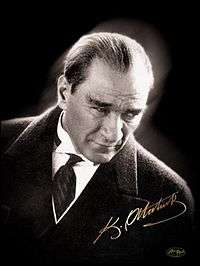
The Ottoman Empire, the “sick man of Europe” was in decline in the 19th and early 20th centuries. What would happen to the failing empire would be called the Eastern Question.
It led to a number of newly independent Balkan countries by 1914, such as Greece (and the Cretan State of 1898–1908), Serbia, Romania, Bulgaria, and Albania; Montenegro was already independent, and the status of Bosnia and Herzegovina within Austria-Hungary would help to precipitate World War I. Further afield, the Ottoman Empire lost a number of territories before 1914: Algeria and Tunisia to France; Egypt, the Yemen, and Cyprus to Britain; and Italian Libya to the Italians.
Dissolution of the Ottoman Empire (1908–1922) was the general disintegration of the empire, particularly as a result of World War I. After Italian victory in the Italo-Turkish War (1911–1912), the First Balkan War (of 1912) resulted in the victory of the Balkan League (Bulgaria, Serbia, Greece, and Montenegro) against the Ottoman Empire. During World War I, genocide in Anatolia became prevalent; 1.5 million Armenians were killed in the Armenian Genocide (1914–1923), and there was also genocide of Greek and Assyrian minorities.
In 1916, Hussein bin Ali, the Sharif of Mecca, led the the Great Arab Revolt, a pan-Arab revolt against the Ottoman Empire to create a united Arab state. There was fighting in Hejaz, Transjordan, and Syria. Although Arab efforts to achieve unified independence failed, Allied victory in World War I assured the end of the Ottoman Empire. With the end of Ottoman suzerainty in Arabia, Hussein bin Ali became King of the Kingdom of Hejaz (1916–1925). The Saudi conquest of Hejaz (1924–25) was a step in the unification of Saudi Arabia. The Kingdom of Saudi Arabia is the third Saudi state ruled by the House of Saud, and was founded in 1932 by Ibn Saud; it dominates the Arabian peninsula.
Partition of the Ottoman Empire, after World War I, was largely under the terms of the British/French Sykes-Picot Agreement outside of the Arabian peninsula; it planned for a geographical divider called the Sykes-Picot line, with French influence to the north and British influence to the south. The British had mandates for Mandatory Palestine (1920–1948, today Israel and the State of Palestine); Mesopotamia (which later became the basis of Iraq); and the Emirate of Transjordan (1921–1946), which was later divided between Jordan, Saudi Arabia and Iraq. The French had mandates for Syria and the Lebanon.
The Turkish War of Independence (1919–1922) was led by Mustafa Kemal Pasha, who would be later known as Atatürk. Atatürk had come to prominence during the Ottoman Turkish victory at the Battle of Gallipoli (1915) during World War I; and as the leading figure of the Turkish National Movement he had defeated Greece, United Kingdom, France and Armenia during the Turkish War of Independence. The Ottoman Sultanate was finally abolished in 1922; the Republic of Turkey was declared in 1923. Atatürk became the first President of Turkey, with Turkey guided by Atatürk's Reforms and Kemalism.
World War I and the Interwar Period
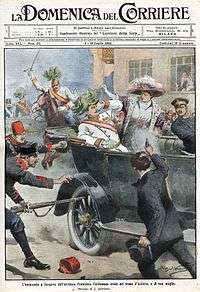

_in_1919.jpg)
Prelude to World War I
The war had roots in the tensions between France and Germany, exacerbated by the Franco-Prussian War (1870–1871), and the French defeat and loss of Alsace-Lorraine to the Prussians. The Dual Alliance (1879) and Triple Alliance (1882) created an alliance between Germany, Austria-Hungary and Italy that excluded France. Partly in response, and after the failure of the German–Austrian–Russian League of the Three Emperors (1873–1880) and the secret German–Russian Reinsurance Treaty (1887–1890), the French–Russian Franco-Russian Alliance was created with agreements between 1891 and 1894.
The Anglo-German naval arms race (1898–1912) worsened British and German relations. The Entente Cordiale (1904) between the British and French improved their relations, and marked the end of almost a thousand years of intermittent conflict between them. The First and Second Moroccan Crises (1905–1906, 1911) worsened German relations with both France and the Britain. The Anglo-Russian Convention (1907) led to the creation of the Triple Entente (1907), an alliance between Britain, France and Russia.
The Bosnian crisis (1908–1909), when Austria-Hungary announced the formal annexation of Bosnia and Herzegovina from the Ottomans, worsened Austria-Hungarian relations with Italy, Serbia, and Russia. The assassination of Archduke Franz Ferdinand was on Sunday, 28 June 1914; the Austrian heir was assassinated by Gavrilo Princip, a Bosnian Serb nationalist. Franz Ferdinand was visiting Sarajevo, the capital of Bosnia and Herzegovina.
Bosnia and Herzegovina was a mixture of South-Slavic peoples: Bosniaks, Bosnian Serbs, and Bosnian Croats. Many Bosnian Serbs and other Bosnians opposed the Austrian annexation; Serbia was sympathetic to them, and the Black Hand, a secret military society formed by officers in the Army of the Kingdom of Serbia, had helped the assassins.
World War I
World War I (the Great War, 1914–1918) had the Allied Powers defeating the Central Powers. The Allied Powers included the Triple Entente of France, the British Empire, and Russia (to 1917), but also include Japan (from August 1914), Italy (from April 1915), the USA (from April 1917), and other allies and co-belligerents. The Central Powers would eventually include Germany, Austria-Hungary, the Ottoman Empire and Bulgaria, and other co-belligerents and client states; it evolved from the earlier Triple Alliance of Germany, Austria-Hungary and Italy (but Italy never fought for the Central Powers).
Key aspects include:
- In the July Crisis, after a series of diplomatic maneuvers, Austria-Hungary declared war on Serbia on 28 July, who they blamed for the assassination of the Archduke Franz Ferdinand. Serbia was a Russian ally, so Russian mobilization had already commenced.
- Events of August 1914: Germany declared war on Russia, and then France and Belgium; they would invade France through Belgium according to the Schlieffen Plan. Britain then declared war against Germany for violating Belgian neutrality, and sent the British Expeditionary Force to France. Austria-Hungary declared war against Russia, and Britain and France declared war against Austria-Hungary.
- German advances in France came to a halt after the First Battle of the Marne (September 1914) with over a half a million casualties; afterwards the Western Front was little changed until 1917.
- In November 1914, the Ottoman Empire entered the war in support of the Central Powers, and opened fronts in the Caucasus, Mesopotamia and the Sinai Peninsula. The Middle Eastern theater included the Gallipoli campaign (1915), which resulted in over half a million casualties.
- The Balkans Campaign (1914–1918) extended the war to the Balkans, with Bulgaria joined the Central Powers in 1915 and the Greece joining the Allies in 1917.
- On the Eastern Front, the Austro-Hungarian offensive at the Battle of Galicia (1914) resulted in over half a million casualties; the German Gorlice-Tarnów Offensive (1915) resulted in as many as half a million casualties; the Russian Brusilov Offensive (1916) resulted in over a million casualties.
- On the Western Front, the Battle of Verdun (1916), the longest offensive of the War, resulted in over a half a million casulaties; the First Battle of the Somme (1916) resulted in over a million casualties; the Third Battle of Ypres (Passchendaele) (1917) resulted in over half a million casualties.
- In 1917, the Central Powers achieved victory on the Eastern Front, with Russian capitulation. Other Allied defeats included Serbia (1915) and Romania (1917).
- The USA joined the Allied Powers in 1917, after German U-boats sank seven US merchant ships, and the Zimmermann Telegram suggesting that Germany was inciting a Mexican-American war.
- On the Western Front in 1918, the German Spring Offensive resulted in one and a half million casualties; and the Allied Powers' Hundred Days Offensive resulted in over two million casualties.
- The Central Powers, of Germany, Austria-Hungary, the Ottoman Empire and Bulgaria, all capitulated to the Allied Powers in 1918. Kaiser Wilhelm II abdicated and Germany signed an armistice on 11 November 1918.
World War I was largely based on the attrition due to casualties of troops, rather than decisive territorial gains. As a result of the World War I, the Austro-Hungarian, German, Ottoman, and Russian Empires ceased to exist. An estimated nine million combatants and seven million civilians died as a direct result of the war. The 1918 influenza pandemic caused another 50 to 100 million deaths worldwide.
Interwar period
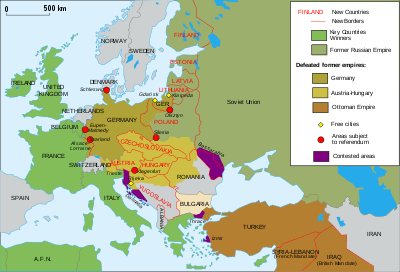
The interwar period was post-World War I to World War II in 1939. The League of Nations was founded in 1920 to maintain world peace.
With the Treaty of Versailles, signed at the 1919 Paris Peace Conference, the Big Four imposed their terms on Germany; they were represented by David Lloyd George (for Britain), Georges Clemenceau (for France), Woodrow Wilson (for the USA), and Vittorio Orlando (for Italy). Germany had Alsace-Lorraine returned to France, its colonies taken, was disarmed, and was forced to make reparation payments.
The Baltic states of Latvia, Lithuania, and Estonia, and Finland and Poland, achieved independence from Russia after civil war. Austria and Hungary were founded as reduced separate states; Czechoslovakia and Yugoslavia were also were created. Josip Broz, also known as Tito, would later become the Yugoslav leader. The partitioning of the Ottoman Empire by the British and French would result in the Turkish War of Independence, and the establishment of the Republic of Turkey in 1923.
Spanish Civil War (1936–1939): Spanish Republicans, loyal to the left-leaning Second Spanish Republic, fought and lost against the Nationalists, led by General Francisco Franco. Resulted in the continuing rule of Francoist Spain (1936–1975).
Russian revolutions and Soviet Union
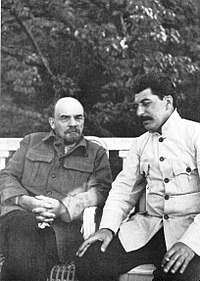
Russian revolutions: the first successful revolution was the February Revolution (March 1917), and the Russian Provisional Government, a coalition of various revolutionary factions, came to power. With the October Revolution (November 1917), the Bolsheviks, a communist faction led by Vladimir Lenin, took over. With the armistice of December 2017, and the Treaty of Brest-Litovsk (March 1918), the Russian SFSR (Russian Soviet Federative Socialist Republic) left World War I. In July 1918, the former Russian Emperor Nicholas II and his family were executed.
Russian Civil War (1917–1922): the Red Army of the Bolsheviks defeated the White Army; there were between 7 and 12 million deaths (including civilians). Subsequently the Soviet Union or USSR (1922–1991) was established as a union of socialist states which excluded the Baltic states formerly in the Russian Empire; the Soviet Union was dominated by the Russian SFSR. Subsequently, Decossackization was a policy of elimination against the Cossacks who had formed the effective core of the anti-Bolshevik White Army.
With the Polish–Soviet War (1919–1921), Ukraine and Belarus ended up being partitioned between Poland and the Soviet Union.
After the death of Vladimir Lenin in 1924, Joseph Stalin, who had been General Secretary since 1922, gradually became an absolute ruler, especially with the Great Purge (1936–1938). The Soviet famine of 1932–33 may have killed as many as eight million, and was related to the forced collectivization of agriculture as a part of the Soviet first five-year plan; it included the Holodomor, widely seen as genocide against the Ukrainians, as well as alleged genocide against the Kazakhs.
World War II
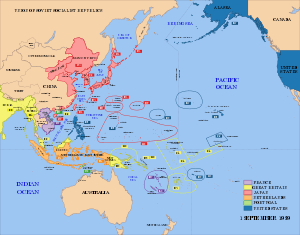
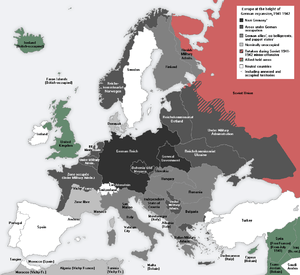
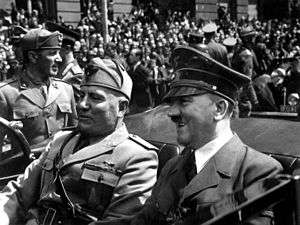
_(B%26W).jpg)
Background to World War II: Benito Mussolini became Prime Minister of Italy in 1922. In 1933 Adolf Hitler became Chancellor (and later Führer) of Nazi Germany, and Germany withdrew from the League of Nations. Ethiopia was invaded by Italy in 1935. Italy and Germany created the Rome-Berlin Axis in 1936, which was later widened to Japan. In 1938 Germany annexed Austria; Czechoslovakia was then annexed by Germany, Hungary and Poland. In March 1939 the UK and France promised to defend the independence of Poland. In August 1939, the Molotov–Ribbentrop Pact between the Soviet Union and Germany planned for mutual non-aggression, and the division of Europe into spheres of influence.
World War II (1939–1945): was a world war in which the Allies would defeat the Axis powers. The Allies would eventually include the Big Four of the USA, UK, Soviet Union, and China; and also governments-in-exile of occupied countries and other combatant states. The Axis powers included the Tripartite Pact powers of Germany, Japan and Italy (until 1943); and other adherents to the Tripartite Pact, and other co-belligerents.
Key aspects include (this list is very limited):
- Preceded by and included the Second Sino-Japanese War (1937–1945), after Japan invaded China, who already occupied Manchuria after the Japanese invasion of Manchuria (1931–1932), with resulting Soviet–Japanese border conflicts (1932 to 1939).
- In September 1939 the UK and France declared war on Germany after the Invasion of Poland, which included Germany and the Soviet Union. This commenced the European theatre of conflict. Under the Molotov–Ribbentrop Pact, Eastern Europe was occupied by Germany and the Soviet Union. Poland was partitioned, and the Baltic states (Estonia, Latvia and Lithuania) were occupied and annexed by the Soviet Union in 1940.
- After the so-called Phoney War, the Western Front commenced with the the Battle of France (May 1940); within six weeks Germany had conquered France, Belgium, Luxembourg and the Netherlands. Germany avoided the stronger Maginot Line fortifications by invading through the Ardennes forest. Erich von Manstein formulated the plan for the battle. This ended land operations on the Western Front until D-Day. Germany divided France into German-occupied northern France and a German-friendly Vichy France to the south.
- The Mediterranean and Middle East theatre opened in June 1940, beginning with the Battle of the Mediterranean, and later extending to the Middle East, North Africa, and West Africa. Erwin Rommel commanded the Germans in the the North African campaign.
- Conflict in the South-East Asian theater began when Japan invaded French Indochina in September 1940, who they occupied. It later included British Burma, Ceylon, Malaya and Singapore; and in Thailand. There was also warfare in the Indian Ocean, as well as the Philippines, Dutch East Indies, New Guinea, and Borneo (see the Pacific War).
- By early June 1941, only the UK actively opposed Germany in Europe; the Soviet Union and Germany were still at peace, and controlled much of Europe. The Battle of the Atlantic (1939–1945) had weakened the UK due to a blockade of supplies by German U-boats. During July–October 1940, the Battle of Britain was the successful defense of the UK from the German air force.
- On the 22nd June 1941, Operation Barbarossa, the German invasion of the Soviet Union, commenced the German-Soviet War at the Eastern Front; German-occupied Europe reached a territorial peak 1941–1942. On the Eastern Front, Georgy Zhukov was responsible for some of the Russian Red Army's most decisive victories.
- In 1941 the USA joined the war after the bombing of Pearl Harbor by Japan on December 7. This commenced the Pacific War; theaters can be divided into North; Central (including Pearl Harbor and the Battle of Midway); South (including the Solomon Islands and the Battle of Guadalcanal); and South West (including the Philippines, Dutch East Indies, New Guinea, and Borneo). Warfare continued in the South-East Asian theater and China.
- During 1942, key Axis defeats included the Battle of Midway (in the Pacific), the Second Battle of El Alamein (in North Africa), and Stalingrad (in the Soviet Union, ending in 1943). The Italian Campaign, commencing July 1943, resulted in the collapse of Fascist Italy (1943) and the Allied occupation of all of Italy by 1945. In December 1943 Dwight D. Eisenhower was made Supreme Allied Commander in Europe. On 6 June 1944, D-Day commenced the Allied invasion of northern Europe, the second stage of conflict on the Western Front.
- V-E Day (Victory in Europe Day) declared on May 8, 1945, after the defeat and occupation of Germany by the Allies. The atomic bombings of Hiroshima and Nagasaki contributed to the surrender of Japan on September 2, 1945 (V-J Day).
There were a number of conferences during and after World War II, which involved members of the Big Three (USA, UK and Russia). Conferences included:
- Casablanca Conference (January 1943): included Franklin D. Roosevelt (USA President), Winston Churchill (UK Prime Minister), and Charles de Gaulle and Henri Giraud (for Free France).
- Cairo Conference (November 1943): included Roosevelt, Churchill, and Generalissimo Chiang Kai-shek (of the Republic of China). It ended with the Cairo Declaration for post-war Asia.
- Tehran Conference (November and December 1943), the first meeting of the Big Three: with Roosevelt, Churchill, and Joseph Stalin for Russia. It planned for the continuing European war, and a date for D-Day.
- Fourth Moscow Conference (October 1944): included Churchill and Stalin and some ministers, with planning for post-war spheres of influence in Eastern Europe.
- Yalta Conference (February 1945), a pre-V-E Day conference between the Big Three (Roosevelt, Churchill, and Stalin). It planned for the defeat of Germany, and post-war arrangements.
- Potsdam Conference (July to August 1945), a pre-V-J Day conference between the Big Three: Stalin, Harry S. Truman (USA President), and Churchill and Clement Attlee (UK Prime Ministers). It created the Potsdam Declaration on the surrender of Japan, and a policy for Germany.
Aftermath of World War II: there were between 50 to 85 million fatalities, mostly civilians in the Soviet Union and China. The war marked the advent of air supremacy and nuclear warfare. The Holocaust, a genocide perpetrated by the Germans during the war, resulted in 17 million deaths, including 6 million Jews. Strategic bombing, the bombing of non-military targets, was a result of the blurring between civilian and military contributions to the war effort, and total war meant that entire populations were dedicated to the war effort. The end of the war marked the beginnings of the Cold War.
Industrialization and cultural changes
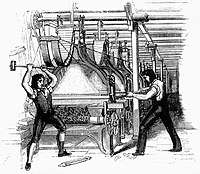
The First Industrial Revolution of the 18th and 19th centuries, particularly in Europe and the USA. Around 1750, developments included the mechanisation of the textiles, developments of iron-making, the introduction of canals, the development of steam power and railways, and the development of all metal machine tools. Luddites protested against the use of machinery, and committed acts of sabotage.
The Second Industrial Revolution was the rapid industrialization between late 19th century and early 20th century. It included the Machine Age, circa 1880–1945. As industrial work forces grew in Western Europe, socialism and trade union activity developed. The last vestiges of serfdom were abolished in Russia in 1861 by Alexander II.
Other important historical periods included: the Victorian era and the Edwardian periods in the UK, 1837–1901–1910 with British Empire building and industry at its peak. The Gilded Age of the United States, 1870–1900, was a period of rapid growth in industry. The Meiji era of Japan, 1868–1912, was the rule of Emperor Meiji and period of Japanese industrialization in which it emerged as a great power. The Great Depression (1929–1939), which came after the Roaring Twenties; an earlier period, called the Long Depression, was between 1873–1879 (by some metrics).
Arts of the late modern period
European arts can be divided into many Western art movements and periods.
Common practice period (circa 1600 to 1910) was the musical era of the tonal system. It followed Early Music (circa 500–1600); it included the Baroque era (c. 1600–1750), galant music era (c. 1720s–1770s), Classical era (c. 1730–1820), and Romantic era (c. 1780–1910). The Classical period of music was at a time when there was a renewal in classicism (that is, drawing inspiration from classical antiquity); the term "classical music" can be applied to all Western art music. It was followed by the Modernist era (c. 1890–1950), and the Postmodern era or Contemporary period (c. 1930 to the present-day).
Visual arts and architecture movements and periods, from circa 1750 onward, included:
- Rococo, or Late Baroque, emerged circa the 1730s to the 1760s in architecture and arts.
- Neoclassicism, began circa 1760, and continues to the present day. As a form of classicism, it draws inspiration from classical antiquity.
- Romanticism in art and music was circa 1780 to 1910, and was in part a reaction to modernity.
- Realism, as an art movement, emerged in the 1840s, and nouveau réalisme (new realism) developed in the 1960s.
- Impressionism in art and music, emerged early 1860s. It was followed by Post-Impressionism, and Neo-Impressionism and Pointillism.
- Modernism was circa 1860s to the 1970s. Late modernism was after World War II, and it was followed by postmodern art.
- Arts and Crafts movement was between circa 1880 and 1920, and stood for traditional craftsmanship. It is related to Art Nouveau.
- Expressionism in art and music, is a modernist movement from the early 20th century onward. It is related to abstract expressionism, and it was followed by neo-expressionism.
- Art Deco emerged in the 1910s as a popular modern art movement, particularly with architecture and design.
- Dada started circa 1915, and rejected the logic, reason, and aestheticism of modern capitalist society; it was followed by Neo-Dada.
- Surrealism started in 1917, and applied aspects of dreams and reality.
- Avant-garde ("advance guard") is cutting-edge experimental art, and was the term was particularly applied to 20th-century music and theater.
- Pop art, from the 1950s onward, was so named as it glorified and expanded upon popular culture.
- Conceptual art emerged late 20th century; new concepts and ideas take precedence over traditional craftsmanship.
- Contemporary art is a period of art post-World War II to the present day.
Other 20th century movements include: Fauvism (circa 1900 to 1935), Cubism (circa 1907 to 1914), Futurism (circa 1909 to 1920s), Constructivism (1913 onward), Suprematism (1913 onward), Bauhaus (circa 1919 to 1933), Constructivism (1920s), The International Typographic Style (1945 onward), Op Art (1950s to 1960s), Arte Povera (1960s), Land art (1960s onward), Minimalism (1960s to 1970s), Installation art (1970s onward), and Memphis design aesthetic (1980s).
Chapter 6 Contemporary period
Contemporary period from circa 1945 (post World War II) to the present time.
See also: Wikipedia:Contemporary history
Cold War
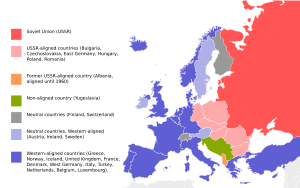
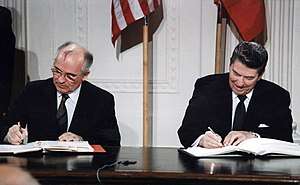

The Cold War (1945–1991) was a period of simmering tension between the the USA with its allies (the Western Bloc), and the Soviet Union and its satellite states (the Eastern Bloc), after World War II. There were sporadic wars in various theaters which did not directly involve the major powers, but instead were wars by proxy. Eventually it would end with the Revolutions of 1989, and the collapse of the Soviet Union (1991).
Two major military treaties divided the Cold War factions:
- The Western Bloc countries; many of these formed NATO (North Atlantic Treaty Organization) in 1949. Twelve countries were part of the founding of NATO: the European countries of Belgium, Denmark, France, Iceland, Italy, Luxembourg, the Netherlands, Norway, Portugal, and the United Kingdom; and the North American countries of the United States, and Canada. It would later expand to other European countries.
- The Eastern Bloc countries, which were described as being "behind the Iron Curtain". They signed the Warsaw Pact in 1955, a treaty establishing the mutual defense organization known as the Warsaw Treaty Organization (WTO) of communist countries; these included the Soviet Union, Poland, East Germany, Albania, Bulgaria, Romania, Czechoslovakia, and Hungary; but Albania withdrew in 1960. Yugoslavia was a communist state that remained non-aligned.
Notable events during this period included:
- United Nations: founded in 1945 it replaced the ineffective League of Nations
- Truman Doctrine (1947): the US doctrine aimed at "containing" Soviet expansion
- Marshall Plan (1948): economic aid was offered to European nations that worked out a program for rehabilitation
- Czechoslovak Communists seized control of the country (1948)
- USA, UK and France merged their German zones in 1947 and 1948, which became West Germany in 1949, as opposed to East Germany
- Berlin Blockade (1948–1949): the Soviet Union blocked the Western Allies' access to Berlin, resulting in the Berlin airlift to supply Berlin
- People's Republic of China established in 1949 by Mao Zedong, and the Republic of China under Chiang Kai-shek retreated to Taiwan
- Korean War (1950–1953), a war between North Korea (with the support of China and the Soviet Union), and South Korea (with the support of the United Nations)
- Cuban Revolution (1953–1959): Fidel Castro's forces defeated the military dictatorship of Cuban President Fulgencio Batista
- Vietnam War (1955–1975): principally a conflict between the communist North Vietnam and its allies, and the anti-communist South Vietnam and its allies
- Hungarian Revolution of 1956, which was crushed by a Soviet invasion
- Suez crisis (1956), after Egypt attempts to nationalize the Suez Canal
- Berlin Wall construction begins (1961), separating West Berlin (a political enclave surrounded by East Germany) from East Berlin
- Cuban Missile Crisis (1962): after the failed Bay of Pigs Invasion of 1961, Cuba requested nuclear missiles to deter a future invasion, causing a showdown with the USA
- Prague Spring (1968), a period of political liberalization and mass protest in Czechoslovakia, resulting in Warsaw Pact occupation
- Soviet-Afghan War (1979–1989): resulted in a strong denunciation of the Soviet Union by the West
- Strategic Defense Initiative (1983): dubbed "Star Wars", it was a proposed missile defense system of the United States from ballistic strategic nuclear weapons
Fall of communism
Mikhail Gorbachev came to power in 1985, and brought policies of glasnost (openness) and perestroika (restructuring). Following the 1989 revolutions, dissolution of the Soviet Union and Warsaw Pact was in 1991. After the fall of the Berlin Wall in 1989 came German reunification in 1990.
15 states were formed from the former USSR: in Europe they consisted of Russia, Ukraine, Belarus, and Moldova; and the Baltic states of Lithuania, Latvia, and Estonia. Other states were states in the Caucasus (Armenia, Azerbaijan, Georgia), and Kazakhstan, Kyrgyzstan, Tajikistan, Turkmenistan, and Uzbekistan.
Yugoslav Wars
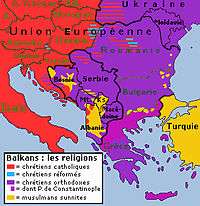
Yugoslav Wars: were civil wars that resulted in the partitioning of Yugoslavia into the new countries of Serbia; Montenegro; Croatia; Slovenia; North Macedonia (also called the former Yugoslav Republic of Macedonia); and Bosnia and Herzegovina.
- Croatian War of Independence (1991–1995): there was a long war in Croatia between the ethnic Croats and Serbs.
- Bosnian War (1992–1995): the peoples of Bosnia and Herzegovina include ethnic Bosniaks, Croats, and Serbs, and saw much conflict.
- Kosovo War (1998–1999): in the Kosovo region of Serbia, there was fighting between the Serbs and the muslim Kosovars (mainly ethnic Albanians).
- There was also the Ten-Day War (1991) in Slovenia; Insurgency in the Preševo Valley (1999–2001) in southern Serbia; and Insurgency in the Republic of Macedonia (2001).
Much of the conflict was a result of the religious differences between the mix of ethnicities that inhabit the former Yugoslav countries:
- Ethnic Slovenians and Croats are mainly Catholic Christian.
- Ethnic Serbs, Montenegrins, and Macedonians are mainly Orthodox Christian.
- Ethnic Bosniaks and Albanians are mainly Sunni Muslim.
Among the former Yugoslav countries there is a mix of these ethnicities in each. Ethnic Serbs, Croats, Bosniaks, Montenegrins, and Slovenians, all speak a closely related group of South-Slavic languages called South-Western Slavic (formerly "Serbo-Croato-Slovenian"). Macedonians speak a South-Eastern Slavic language, like the Bulgarians. Albanians speak a non-Slavic language; Albania was not a Yugoslav country, but there is a sizeable Albanian diaspora especially in Kosovo.
Serbia includes the Autonomous Province of Vojvodina, and the Autonomous Province of Kosovo and Metohija; but Kosovo unilaterally declared independence from Serbia in 2008, and this is currently recognized by about 100 UN states but not Serbia.
Other aspects of the contemporary period
Decolonisation gained traction, with European colonial empires in Africa and Asia gone by 1975. In 1947, the British Empire had begun a process of voluntarily dismantling with the granting of independence to India and Pakistan.
Spain: democracy was restored in Spain in 1975, with a constitutional monarchy.
EEC and EU: Treaty of Rome (1957) founds the European Economic Community. The European Union formed in 1993 with the Maastricht Treaty. The Euro adopted as a currency in 2002. Enlargement of the EU in 2004: Cyprus, the Czech Republic, Estonia, Hungary, Latvia, Lithuania, Malta, Poland, Slovakia, and Slovenia. Accession of Bulgaria and Romania in 2007
The 2014 Ukrainian revolution had armed conflict in the regions of Donetsk and Lugansk, after attempts to cede to the Russian Federation. A referendum held in Crimea led to its annexation to the Russian Federation as the Republic of Crimea, which is largely unrecognized.
Technology and industry: Western countries began de-industrialisation; globalization led to the emergence of new industrial centres, including Japan, Taiwan, China. The rise of science, technology, and computers led to the Information Age (1971–) and the widespread use of the Internet, creating profound changes. The Space Age was established in 1957.
The arts: popular music became prominent in the 20th Century. Postmodernism (c. 1930–) was an arts movement that developed in the mid- to late 20th century; the avant-garde (from the French for "advance guard") was seen as the cutting edge of experimentation.
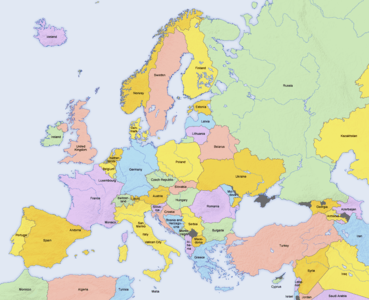 Present-day Europe
Present-day Europe.png) 2019 World map
2019 World map